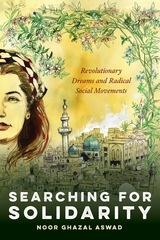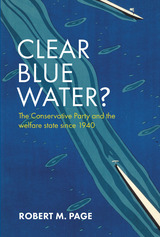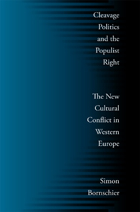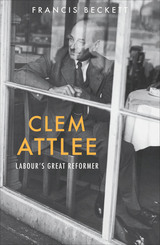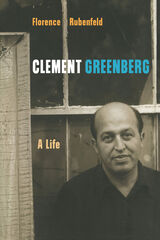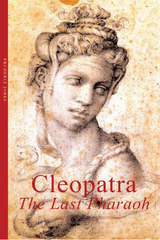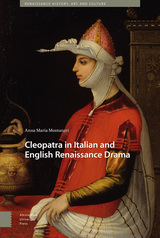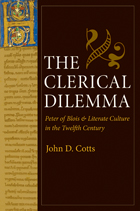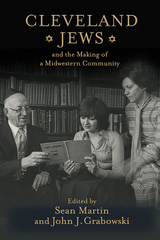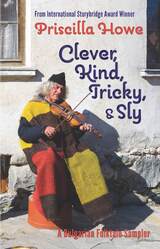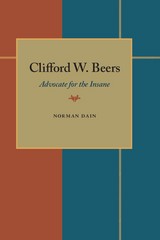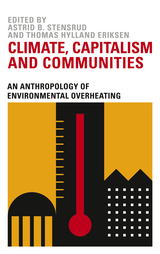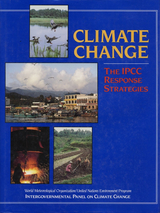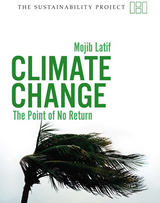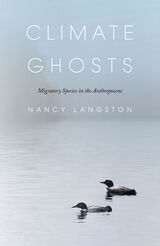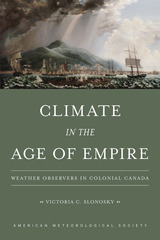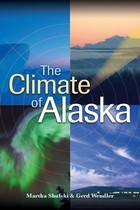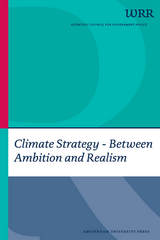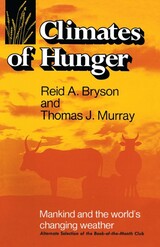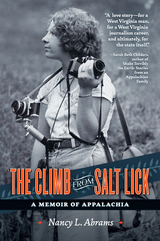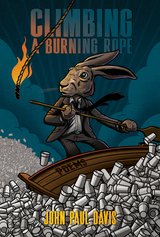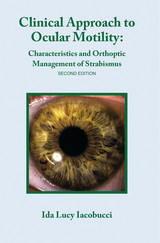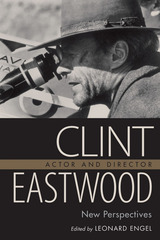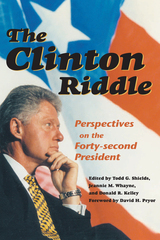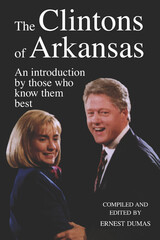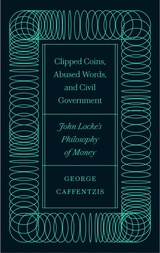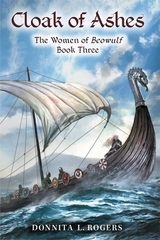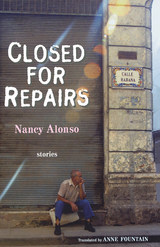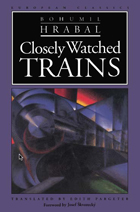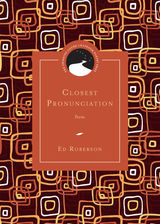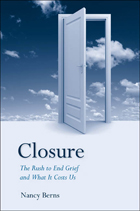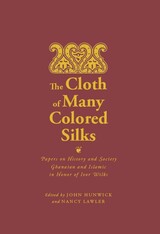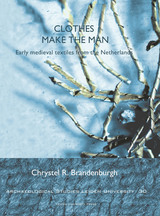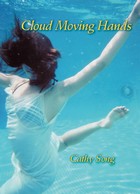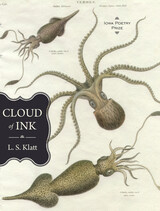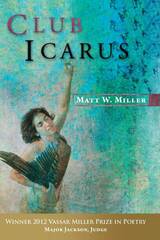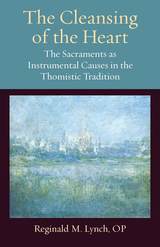 The Cleansing of the Heart
Reginald Lynch
Catholic University of America Press, 2017 Recalling the Biblical and Patristic roots of the Church's sacramental identity, the Second Vatican Council calls the Church the 'visible sacrament' of that unity offered through Christ (LG 9). 'Sacrament' in this sense not only describes who the Church is, but what she does. In this regard, the Council Fathers were careful to establish a strong connection between the symbolic nature of the Church's sacraments and their effect on those who received them.
Reginald Lynch is concerned with the cleansing of the heart—a phrase borrowed from St. Augustine and employed by Aquinas, which describes the effects that natural elements such as water or bread have on the human person when taken up by the Church as sacramental signs. Aquinas' approach to sacramental efficacy is unique for its integration of diverse theological topics such as Christology, merit, grace, creation and instrumentality. While all of these topics will be considered to some extent, the primary focus of The Cleansing of the Heart is the sacraments understood as instrumental causes of grace. This volume provides the historical context for understanding the development of sacramental causality as a theological topic in the scholastic period, emphasizing the unique features of Aquinas' response to this question. Following this, relevant texts from Aquinas' early and later work are examined, noting Aquinas' development and integration of the idea of sacramental causality in his later work. The Cleansing of the Heart concludes by contrasting alternatives to Aquinas' theory of sacramental causality that subsequently emerged. The rise of humanism introduced many changes within rhetoric and philosophy of language that had a profound effect on some theologians during the Modern period. This book provides historical context for understanding the most prominent of these theories in contrast to Aquinas, and examines some of their theological implications.
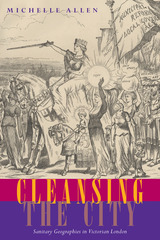 Cleansing the City: Sanitary Geographies in Victorian London
Michelle Allen
Ohio University Press, 2008 Cleansing the City: Sanitary Geographies in Victorian London explores not only the challenges faced by reformers as they strove to clean up an increasingly filthy city but the resistance to their efforts. Beginning in the 1830s, reform-minded citizens, under the banner of sanitary improvement, plunged into London’s dark and dirty spaces and returned with the material they needed to promote public health legislation and magnificent projects of sanitary engineering. Sanitary reform, however, was not always met with unqualified enthusiasm. While some improvements, such as slum clearances, the development of sewerage, and the embankment of the Thames, may have made London a cleaner place to live, these projects also destroyed and reshaped the built environment, and in doing so, altered the meanings and experiences of the city.
From the novels of Charles Dickens and George Gissing to anonymous magazine articles and pamphlets, resistance to reform found expression in the nostalgic appreciation of a threatened urban landscape and anxiety about domestic autonomy in an era of networked sanitary services. Cleansing the City emphasizes the disruptions and disorientation occasioned by purification—a process we are generally inclined to see as positive. By recovering these sometimes oppositional, sometimes ambivalent responses, Michelle Allen elevates a significant undercurrent of Victorian thought into the mainstream and thus provides insight into the contested nature of sanitary modernization.
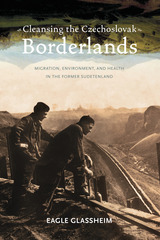 Cleansing the Czechoslovak Borderlands: Migration, Environment, and Health in the Former Sudetenland
Eagle Glassheim
University of Pittsburgh Press, 2016 In this innovative study of the aftermath of ethnic cleansing, Eagle Glassheim examines the transformation of Czechoslovakia’s Sudetenland from the end of the Second World War, through the Cold War, and into the twenty-first century.
Prior to their expulsion in 1945, ethnic Germans had inhabited the Sudeten borderlands for hundreds of years, with deeply rooted local cultures and close, if sometimes tense, ties with Bohemia’s Czech majority. Cynically, if largely willingly, harnessed by Hitler in 1938 to his pursuit of a Greater Germany, the Sudetenland’s three million Germans became the focus of Czech authorities in their retributive efforts to remove an alien ethnic element from the body politic—and claim the spoils of this coal-rich, industrialized area. Yet, as Glassheim reveals, socialist efforts to create a modern utopia in the newly resettled “frontier” territories proved exceedingly difficult. Many borderland regions remained sparsely populated, peppered with dilapidated and abandoned houses, and hobbled by decaying infrastructure. In the more densely populated northern districts, coalmines, chemical works, and power plants scarred the land and spewed toxic gases into the air. What once was a diverse religious, cultural, economic, and linguistic “contact zone,” became, according to many observers, a scarred wasteland, both physically and psychologically.
Glassheim offers new perspectives on the struggles of reclaiming ethnically cleansed lands in light of utopian dreams and dystopian realities—brought on by the uprooting of cultures, the loss of communities, and the industrial degradation of a once-thriving region. To Glassheim, the lessons drawn from the Sudetenland speak to the deep social traumas and environmental pathologies wrought by both ethnic cleansing and state-sponsored modernization processes that accelerated across Europe as a result of the great wars of the twentieth century.
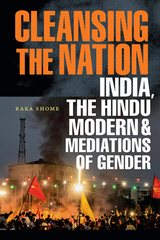 Cleansing the Nation: India, the Hindu Modern, and Mediations of Gender
Raka Shome
Duke University Press, 2025 In Cleansing the Nation, Raka Shome explores the logics of governmentality of contemporary Hindu nationalism in India by advancing the concept of the “Hindu modern.” Analyzing a national cleanliness program and other development projects, Shome shows how the Hindu modern—a form of national governmentality that disciplines and regulates individual subjects to create desirable “clean” citizens—inscribes Hindu nationalism in India. Focused on security, progress, and development while celebrating and protecting the figure of the upper-caste Hindu woman, the Hindu modern works toward a religious and casteist cleansing of the nation that rewrites Indian modernity as a purified and cleansed Hindu modernity. It shores up caste and religious inequalities around who is authentically Indian, reproducing historical violence against and exclusions of caste, gender, and religion, especially toward Muslims, Dalits, and Adivasis. By outlining how the Hindu modern sutures Hindu-ness to the contemporary Indian national project of modernity, Shome helps us further understand projects of national purification and cleanliness within global populist authoritarian movements.
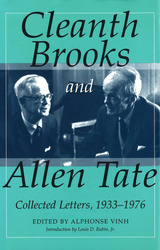 Cleanth Brooks and Allen Tate: Collected Letters, 1933-1976
Edited by Alphonse Vinh & Intro by Louis D. Rubin, Jr.
University of Missouri Press, 1998
Offering all of the extant letters exchanged by two of the twentieth century's most distinguished literary figures, Cleanth Brooks and Allen Tate: Collected Letters, 1933-1976 vividly depicts the remarkable relationship, both professional and personal, between Brooks and Tate over the course of their lifelong friendship.
An accomplished poet, critic, biographer, and teacher, Allen Tate had a powerful influence on the literary world of his era. Editor of the Fugitive and the Sewanee Review, Tate greatly affected the lives and careers of his fellow literati, including Cleanth Brooks. Esteemed coeditor of An Approach to Literature and Understanding Poetry, Brooks was one of the principal creators of the New Criticism. His Modern Poetry and the Tradition and The Well Wrought Urn, as well as his two-volume study of Faulkner, remain among the classics read by any serious student of literature. The correspondence between these two gentlemen-scholars, which began in the 1930s, extended over five decades and covered a vast amount of twentieth-century literary history.
In the more than 250 letters collected here, the reader will encounter their shared concerns for and responses to the work of their numerous friends and many prominent writers, including T. S. Eliot, William Faulkner, and Robert Lowell. Their letters offer details about their own developing careers and also provide striking insight into the group dynamics of the Agrarians, the noteworthy community of southern writers who played so influential a role in the literature of modernism.
Brooks once said that Tate treated him like a younger brother, and despite great differences between their personalities and characters, these two figures each felt deep brotherly affection for the other. Whether they contain warm invitations for the one to visit the other, genteel or honest commentaries on their families and friends, or descriptions of the vast array of social, professional, and even political activities each experienced, the letters of Brooks and Tate clearly reveal the personalities of both men and the powerful ties of their strong camaraderie.
Invaluable to both students and teachers of literature, Cleanth Brooks and Allen Tate provides a substantial contribution to the study of twentieth-century American, and particularly southern, literary history.
Clear Blue Water?: The Conservative Party and the Welfare State Since 1940
Robert M. Page
Bristol University Press, 2015 In Clear Blue Water?, Robert M. Page takes an authoritative look at the policies and politics of Britain’s Conservative Party to discover if it has developed a distinctive approach to the postwar welfare state. He begins with the progressive One Nation Conservatism wing of the party, exploring how it strove to embrace the features of the welfare state that were compatible with its underlying philosophy. Page then turns to the neoliberal conservatives, who sought to undo the welfare state, before placing the spotlight on the strategy behind David Cameron’s progressive neoliberal conservative version. Weaving a broad historical thread throughout, this timely, accessible book will be a valuable resource for students in social policy, politics, and social history.
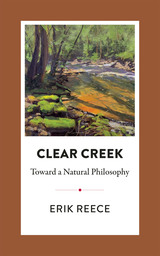 Clear Creek: Toward a Natural Philosophy
Erik Reece
West Virginia University Press, 2023 Acclaimed author Erik Reece spends a year beside a rural Kentucky stream, in close observation of the natural world’s cycles, revelations, and redemptions.
A critic once wrote that Rebecca West’s Black Lamb and Grey Falcon was about two things: Yugoslavia and everything else. Something similar might be said about Clear Creek. In this boundary-defying work, Erik Reece spends a year beside the stream in his rural Kentucky homeplace, tracking the movements of the seasons, the animals, and the thoughts passing through his mind. Clear Creek is a series of vignettes that calls us out of our frenzied, digitized world to a slower, more contemplative way of being. Reece’s subjects range from solitude and solidarity to the intricacies of forest communities, and from the genius of songwriter Tom T. Hall to reforestation projects on abandoned strip mines. A work of close observation and carefully grounded insights, Clear Creek articulates a nature-based philosophy for pondering humanity’s current plight.
 Clear Grammar 2, 2nd Edition: Keys to Grammar for English Language Learners
Keith S. Folse
University of Michigan Press, 2012 Clear Grammaris a four-level grammar series that features a unique combination of useful grammar information written in clear language with activities that promote more accurate and fluent vocabulary usage, writing, speaking, and reading. Important features of all four new editions of Clear Grammarinclude: - More user-friendly charts to accompany grammar explanations
- High-frequency, corpus-based vocabulary related to each grammar point
- Grammar discovery tasks using students’ inductive learning skills
- A greater variety and increased number of activities, including more practice online
- Many more activities at the longer discourse level
- The addition of reading practice at the end of the unit, as well a critical-reading task
- More writing practice, including one on editing student writing and another for original student writing
- Two vocabulary practice activities, including a focus on collocations, in each unit, as well as many one-minute mini lessons showing the connection between grammar and vocabulary
- More speaking practice, with activities that require students to speak and listen to each other while using the target grammar
Support for teachers in the form of indicators that reference how to teach the grammar points in the Clear Grammar series from Keys to Teaching Grammar for English Language Learners by Keith S. Folse (978-0-472-03220-4).
Clear Grammar 2offers students and teachers a solid introduction to low-intermediate grammar.
Clear Grammar 2, 2nd Ed., includes * Articles * Past tense of irregular verbs * Present perfect tense * Adverbs of frequency * Nouns used as adjectives * Object pronouns * Past progressive tense * One and Other * Possessives
*Comparatives and superlatives
*Modals
The book's companion website includes the additional grammar/vocabulary activities that are referenced in the textbook.
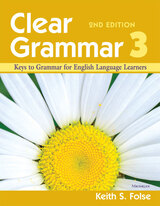 Clear Grammar 3, 2nd Edition: Keys to Grammar for English Language Learners
Keith S. Folse
University of Michigan Press, 2015 Clear Grammar 3 introduces high-intermediate grammar. Clear Grammar 3, 2nd Ed., includes -
phrasal verbs -
infinitives and gerunds -
participial adjectives: -ing and -ed -
prepositions after verbs, adjectives, and nouns -
passive voice -
adjective clauses -
adverbs -
connectors -
review of verb tenses Clear Grammar 3 concludes with a review of this volume’s contents of high-intermediate grammar points. Clear Grammar is a four-level grammar series that features a unique combination of useful grammar information written inclearlanguage with activities that promote more accurate and fluent writing, speaking, reading, and vocabulary usage. Important features of the new editions of Clear Grammar include: - More user-friendly charts to accompany grammar explanations
- High-frequency, corpus-informed vocabulary related to each grammar point
- Grammar discovery tasks using students’ inductive learning skills
- A greater variety and more activities, including practice online (www.press.umich.edu/esl/compsite/cleargrammar/)
- Many more activities at the longer discourse level
- The addition of reading practice at the end, plus a critical-reading task
- More writing practice, including one on editing student writing and another for original student writing
- Two vocabulary practice activities per unit, with one on collocations; plus many one-minute lessons showing the connection between grammar and vocabulary
- More speaking practice, with activities that require students to speak and listen to each other while using the target grammar
- Support for teachers in the form of indicators that reference how to teach the grammar points in the Clear Grammar series from Keys to Teaching Grammar for English Language Learners by Keith S. Folse (978-0-472-03220-4).
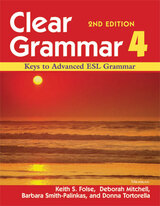 Clear Grammar 4, 2nd Edition: Keys to Advanced ESL Grammar
Keith S. Folse, Deborah Mitchell, Barbara Smith-Palinkas, and Donna Tortorella
University of Michigan Press, 2013 Clear Grammar 4 introduces advanced grammar. Clear Grammar 4, 2nd Ed., includes - Subject-verb agreement
- Word forms
- Past perfect tense
- Conditionals
- Adverb clauses
- Noun clauses
- Reduction of adjective and adverb clauses (including appositives)
- Past modals
- Review of verb tenses
Clear Grammar 4 concludes with a review of this volume’s contents of advanced grammar points. Clear Grammar is a four-level grammar series that features a unique combination of useful grammar information written in clear language with activities that promote more accurate and fluent writing, speaking, reading, and vocabulary usage. Important features of the new editions of Clear Grammar include: - More user-friendly charts to accompany grammar explanations
- High-frequency, corpus-informed vocabulary related to each grammar point
- Grammar discovery tasks using students’ inductive learning skills
- A greater variety and more activities, including practice online (www.press.umich.edu/esl/compsite/cleargrammar/)
- Many more activities at the longer discourse level
- The addition of reading practice at the end, plus a critical-reading task
- More writing practice, including one on editing student writing and another for original student writing
- Two vocabulary practice activities per unit, with one on collocations; plus many one-minute lessons showing the connection between grammar and vocabulary
- More speaking practice, with activities that require students to speak and listen to each other while using the target grammar
- Support for teachers in the form of indicators that reference how to teach the grammar points in the Clear Grammar series from Keys to Teaching Grammar for English Language Learners by Keith S. Folse (978-0-472-03220-4).
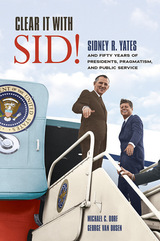 Clear It with Sid!: Sidney R. Yates and Fifty Years of Presidents, Pragmatism, and Public Service
Michael C. Dorf and George Van Dusen
University of Illinois Press, 2022 The son of a Lithuanian blacksmith, Sidney R. Yates rose to the pinnacle of Washington power and influence. As chair of a House Appropriations Subcommittee, Yates was a preeminent national figure involved in issues that ranged from the environment and Native American rights to Israel and support for the arts. Speaker Tip O'Neill relied on the savvy Chicagoan in the trenches and advised anyone with controversial legislation to first "clear it with Sid!"
Michael C. Dorf and George Van Dusen draw on scores of interviews and unprecedented access to private papers to illuminate the life of an Illinois political icon. Wise, energetic, charismatic, petty, stubborn--Sid Yates presented a complicated character to constituents and colleagues alike. Yet his get-it-done approach to legislation allowed him to bridge partisan divides in the often-polarized House of Representatives. Following Yates from the campaign trail to the negotiating table to the House floor, Dorf and Van Dusen offer a rich portrait of a dealmaker extraordinaire and tireless patriot on a fifty-year journey through postwar American politics.
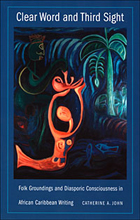 Clear Word and Third Sight: Folk Groundings and Diasporic Consciousness in African Caribbean Writing
Catherine A. John
Duke University Press, 2003 Clear Word and Third Sight examines the strands of a collective African diasporic consciousness represented in the work of a number of Black Caribbean writers. Catherine A. John shows how a shared consciousness, or “third sight,” is rooted in both pre- and postcolonial cultural practices and disseminated through a rich oral tradition. This consciousness has served diasporic communities by creating an alternate philosophical “worldsense” linking those of African descent across space and time. Contesting popular discourses about what constitutes culture and maintaining that neglected strains in negritude discourse provide a crucial philosophical perspective on the connections between folk practices, cultural memory, and collective consciousness, John examines the diasporic principles in the work of the negritude writers Léon Damas, Aimé Césaire, and Léopold Senghor. She traces the manifestations and reworkings of their ideas in Afro-Caribbean writing from the eastern and French Caribbean, as well as the Caribbean diaspora in the United States. The authors she discusses include Jamaica Kincaid, Earl Lovelace, Simone Schwarz-Bart, Audre Lorde, Paule Marshall, and Edouard Glissant, among others. John argues that by incorporating what she calls folk groundings—such as poems, folktales, proverbs, and songs—into their work, Afro-Caribbean writers invoke a psychospiritual consciousness which combines old and new strategies for addressing the ongoing postcolonial struggle.
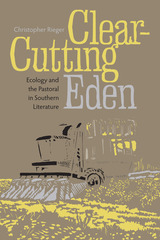 Clear-Cutting Eden: Ecology and the Pastoral in Southern Literature
Christopher Rieger
University of Alabama Press, 2009 Examines how Southern literary depictions of the natural world were influenced by the historical, social, and ecological changes of the 1930s and 1940s Rieger studies the ways that nature is conceived of and portrayed by four prominent Southern writers of the era: Erskine Caldwell, Marjorie Kinnan Rawlings, Zora Neale Hurston, and William Faulkner. Specifically, he argues that these writers created new versions of an old literary mode—the pastoral—in response to the destabilizing effects of the Great Depression, the rise of Southern modernism, and the mechanization of agricultural jobs. Mass deforestation, soil erosion, urban development, and depleted soil fertility are issues that come to the fore in the works of these writers. In response, each author depicts a network model of nature, where humans are part of the natural world, rather than separate, over, or above it, as in the garden pastorals of the Old South, thus significantly revising the pastoral mode proffered by antebellum and Reconstruction-era writers. Each writer, Rieger finds, infuses the pastoral mode with continuing relevance, creating new versions that fit his or her ideological positions on issues of race, class, and gender. Despite the ways these authors represent nature and humankind’s place in it, they all illustrate the idea that the natural environment is more than just a passive background against which the substance of life, or fiction, is played out.
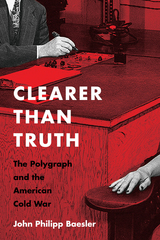 Clearer Than Truth: The Polygraph and the American Cold War
John Philipp Baesler
University of Massachusetts Press, 2018 A person strapped to a polygraph machine. Nervous eyes, sweaty brow, the needle trembling up and down. Few images are more evocative of Cold War paranoia.
In this first comprehensive history of the polygraph as a tool and symbol of American Cold War policies, John Philipp Baesler tells the story of a technology with weak scientific credentials that was nevertheless celebrated as a device that could expose both internal and external enemies. Considered the go-to technology to test agents' and employees' loyalty, the polygraph's true power was to expose deep ideological and political fault lines. While advocates praised it as America's hard-nosed yet fair answer to communist brainwashing, critics claimed that its use undermined the very values of justice, equality, and the presumption of innocence for which the nation stood.
Clearer Than Truth demonstrates that what began as quick-fix technology promising a precise test of honesty and allegiance eventually came to embody tensions in American Cold War culture between security and freedom, concerns that reach deep into the present day.
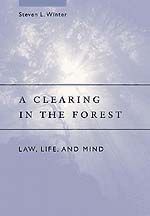 A Clearing in the Forest: Law, Life, and Mind
Steven L. Winter
University of Chicago Press, 2001 Cognitive science is transforming our understanding of the mind. New discoveries are changing how we comprehend not just language, but thought itself. Yet, surprisingly little of the new learning has penetrated discussions and analysis of the most important social institution affecting our lives-the law.
Drawing on work in philosophy, psychology, anthropology, linguistics, and literary theory, Steven L. Winter has created nothing less than a tour de force of interdisciplinary analysis. A Clearing in the Forest rests on the simple notion that the better we understand the workings of the mind, the better we will understand all its products-especially law. Legal studies today focus on analytic skills and grand normative theories. But, to understand how real-world, legal actors reason and decide, we need a different set of tools. Cognitive science provides those tools, opening a window on the imaginative, yet orderly mental processes that animate thinking and decisionmaking among lawyers, judges, and lay persons alike. Recent findings about how humans actually categorize and reason make it possible to explain legal reasoning in new, more cogent, more productive ways.
A Clearing in the Forest is a compelling meditation on both how the law works and what it all means. In uncovering the irrepressibly imaginative, creative quality of human reason, Winter shows how what we are learning about the mind changes not only our understanding of law, but ultimately of ourselves. He charts a unique course to understanding the world we inhabit, showing us the way to the clearing in the forest.
 Clearing Out: A Novel
Helene Uri
University of Minnesota Press, 2024 Winner of the Nadia Christensen Prize for translation from the American-Scandinavian Foundation
In a masterful blend of fiction and autobiography, a Norwegian novelist sends her character to the far north to learn what she can about their Sami ancestry Inspired by Helene Uri’s own journey into her family’s ancestry, Clearing Out, an emotionally resonant novel by one of Norway’s most celebrated authors, tells two intertwining stories. A novelist, named Helene, is living in Oslo with her husband and children and contemplating her new protagonist, Ellinor Smidt—a language researcher, divorced and in her late thirties, with a doctorate but no steady job. An unexpected call from a distant relative reveals that Helene’s grandfather, Nicolai Nilsen, was the son of a coastal (sjø) Sami fisherman—something no one in her family ever talked about. Uncertain how to weave this new knowledge into who she believes she is, Helene continues to write her novel, in which her heroine Ellinor travels to Finnmark in the far north to study the dying languages of the Sami families there. What Ellinor finds among the Sami people she meets is a culture little known in her own world; she discovers history richer and more alluring than rumor and a connection charged with mystery and promise. Through her persistence in approaching an elderly Sami activist, and her relationship with a local Sami man, Ellinor confronts a rift that has existed between two families for generations. Intricate and beautifully constructed, Clearing Out offers a solemn reflection on how identities, like families, are formed and fractured and recovered as stories are told. In its depiction of the forgotten and the fiercely held memories among the Sea (sjø) Sami of northern Norway, the novel is a powerful statement on what is lost, and what remains in reach, in the character and composition of contemporary life.
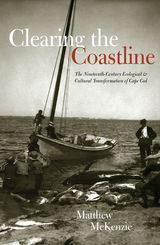 Clearing the Coastline: The Nineteenth-Century Ecological & Cultural Transformations of Cape Cod
Matthew McKenzie
University Press of New England, 2011 In just over a century Cape Cod was transformed from barren agricultural wasteland to bountiful fishery to pastoral postcard wilderness suitable for the tourist trade. This complex social, ecological, and scientific transformation fundamentally altered how Cape Codders used and managed their local marine resources, and determined how they eventually lost them. The Cape Cod story takes the usual land-use progression—from pristine wilderness to exploitation of resources to barren wasteland—and turns it on its head. Clearing the Coastline shows how fishermen abandoned colonial traditions of small-scale fisheries management, and how ecological, cultural, and scientific changes, as well as commercial pressures, eroded established, local conservation regimes. Without these protections, small fish and small fishermen alike were cleared from Cape Cod’s coastal margins to make room for new people, whose reinvention of the Cape as a pastoral “wilderness” allowed them to overlook the social and ecological dislocation that came before.
Cleavage Politics and the Populist Right: The New Cultural Conflict in Western Europe
Authored by Simon Bornschier
Temple University Press, 2010 Over the last two decades, right-wing populist parties in Western Europe have gained sizable vote shares and power, much to the fascination and consternation of political observers. Meshing traditionalism and communitarian ideals, right-wing populist parties have come to represent a polar normative ideal to the New Left in Western Europe. In his dynamic study Cleavage Politics and the Populist Right, Simon Bornschier applies a cultural as well as political dimension to analyze the parties of both the right and left in six countries. He develops a theory that integrates the role of political conflict around both established cleavages and party strategies regarding new divisions to explain the varying fortunes of the populist right.
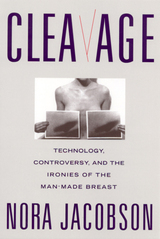 Cleavage: Technology, Controversy, and the Ironies of the Man-Made Breast
Jacobson, Nora
Rutgers University Press, 1999 Women's breasts have been idealized as symbols of femininity and motherhood. They have held great social and psychological significance as objects drawing intrusive gazes, and as images of self worth to be measured against an idealized form. It is no wonder, then, that a technology emerged to alter and "enhance" their appearance. Nora Jacobson traces the hundred-year history of one such technology: breast implants.
Organized both chronologically and thematically, this book examines the history of breast implant technology from 1895 to 1990, including the controversies that erupted in the early 1990s over the safety of the devices and the Food and Drug Administration's regulation of their use. Jacobson examines such topics as politics and bias in medical practice and the role of bureaucracies, corporations, and governments in establishing policy and regulating implant technology.
Clem Attlee: Labour's Great Reformer
Francis Beckett
Haus Publishing, 2015 As British prime minister from 1945 to 1951, Clement Attlee built a legacy that includes today’s famous—and controversial—National Health Service, yet he is often remembered as a rather dull political figure. Rejecting Winston Churchill’s jibe that Attlee was a “modest little man with plenty to be modest about,” this biography makes the case that his reputation as Britain’s greatest reforming prime minister is fully deserved.
Building on his earlier work on Attlee and including new research and stories, many of which are published here for the first time, Francis Beckett highlights Attlee’s relevance for a new generation. A poet and dreamer, Attlee led a remarkable political life that saw, among other challenges, the beginning of the Cold War. Ultimately, this perceptive biography demonstrates that Attlee’s ideas have never been more relevant.
Clemenceau
Geoffrey Bruun
Harvard University Press
 Clemency and Cruelty in the Roman World
Melissa Barden Dowling
University of Michigan Press, 2006 When the Roman democratic republic fell and the monarchical empire rose, a new vocabulary of power was needed to help balance the awesome abilities of the state to inflict harm and the need of its people for individual protection. In Clemency and Cruelty in the Roman World, Melissa Barden Dowling explores the formation of clemency as a human and social value in the Roman Empire, a topic that has been curiously neglected despite its obvious importance to our understanding of Roman society and the workings of the penal system.
In this first thorough study of the origins of clemency, Dowling provides a vivid look at the ideology of clemency and new philosophies of mercy and cruelty in Western society, through an examination of ancient art, literature, historical documents, and archaeological artifacts. By illuminating the emergence of mercy and forgiveness as social concepts, and the mechanisms by which peoples are transformed in response to changes in power structures, Dowling makes an important contribution to the study of the ancient Roman world, as well as to modern Western culture.
Clement Greenberg: A Life
Florence Rubenfeld
University of Minnesota Press, 2004 The only book-length biography of this controversial critic, now in paperback for the first time!
Love him or hate him, admire him or revile him, there is no doubt that Clement Greenberg was the most influential critic of modern art in the second half of the twentieth century. His championing of abstract expressionist painters such as Jackson Pollock, Barnett Newman, and David Smith put the United States on the international art map. His support for color-field painters Morris Louis and Kenneth Noland dramatically accelerated their careers. The intellectual power of his polemical essays helped bring about the midcentury shift in which New York replaced Paris as the art capital of the Western world; his aggressive personality and fierce involvement in the New York art scene triggered a backlash so potent that one critic termed it a “patricide.”
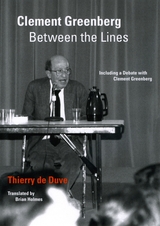 Clement Greenberg Between the Lines: Including a Debate with Clement Greenberg
Thierry de Duve
University of Chicago Press, 2010 Clement Greenberg (1909–1994), champion of abstract expressionism and modernism—of Pollock, Miró, and Matisse—has been esteemed by many as the greatest art critic of the second half of the twentieth century, and possibly the greatest art critic of all time. This volume, a lively reassessment of Greenberg’s writings, features three approaches to the man and his work: Greenberg as critic, doctrinaire, and theorist. The book also features a transcription of a public debate with Greenberg that de Duve organized at the University of Ottawa in 1988. Clement Greenberg Between the Lines will be an indispensable resource for students, scholars, and enthusiasts of modern art. “In this compelling study, Thierry de Duve reads Greenberg against the grain of the famous critic’s critics—and sometimes against the grain of the critic himself. By reinterpreting Greenberg’s interpretations of Pollock, Duchamp, and other canonical figures, de Duve establishes new theoretical coordinates by which to understand the uneasy complexities and importance of Greenberg’s practice.” John O’Brian, editor of Clement Greenberg: The Collected Essays and Criticisms “De Duve is an expert on theoretical aesthetics and thus well suited to reassess the formalist tenets of the late American art critic's theory on art and culture. . . . De Duve's close readings of Greenberg . . . contain much of interest, and the author clearly enjoys matching wits with ‘the world's best known art critic.’” Library Journal
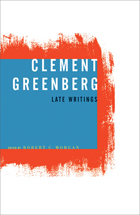 Clement Greenberg, Late Writings
Clement Greenberg
University of Minnesota Press, 2007 Clement Greenberg (1909-1994) was a colossus of twentieth-century American art, achieving a degree of authority almost unimaginable for a critic today. For more than thirty years he was both lionized as a proponent of formalism and criticized for his perceived dogmatism. In the postwar period Greenberg used his position of influence to advocate the importance of abstract expressionism and color-field painting and to establish the careers of such artists as Jackson Pollock, Hans Hofmann, Barnett Newman, and Willem de Kooning. With the coming of pop art, performance and conceptual art, and postmodernism, however, Greenberg found his position increasingly challenged. Edited with an introduction by critic Robert C. Morgan, Clement Greenberg, Late Writings is the first collection from the period 1970 to 1990, and the only comprehensive resource for Greenberg’s thought during the last third of his life. While earlier works have covered Greenberg’s early and middle career, this volume spans his mature period, during which he reevaluates and refines many of his earlier tenets in some of his most carefully crafted and engaging work. Exploring a surprising breadth of issues and mediums and demonstrating a depth of aesthetic and philosophical insights, in these relatively unknown works Greenberg incites a new direction for modernism beyond the twentieth century. This essential volume includes five interviews from the end of his life in which Greenberg revisits some of the concerns of his formative years, illuminating the progression of his thought. Late Writings is an integral resource as issues of quality and significance in the dynamic world of art continue to be redefined. Clement Greenberg was the most influential art critic of the postwar period. He was the author of numerous books, and his essays appeared in art magazines as well as such publications as Partisan Review, Commentary, and The Nation. Robert C. Morgan is the author of The End of the Art World and of a monograph on the optical painter Vasarely. In addition to his work as a critic, artist, art historian, and curator, he is visiting professor of art at Hunter College in New York City.
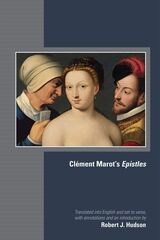 Clément Marot's Epistles
Clément Marot
Arizona Center for Medieval and Renaissance Studies, 2021 The first complete, versified English-language translation of the epistles of Renaissance poet Clément Marot.
Clément Marot (1496–1544), a royal poet in Renaissance France who ushered in new verse forms and renewed existing ones, stands as one of the most important literary voices of the first half of the sixteenth century. Clément Marot’s Epistles represents a first attempt to offer a sustained English-language translation and critical edition of what is widely considered his most personal, historically relevant, and crowning verse form. Aiming for integrality and poetic precision, the volume translates and sets to verse all seventy-four of Marot’s epistles, employing the same meter and rhyme scheme used by the poet in the original compositions. Likewise focused on capturing Marot’s poetic voice, thus maintaining idiomatic and literary integrity, the resulting translation is an attempt to relate the playfulness and pathos of Marot’s verse, rendering it accessible to an anglophone public.
Beyond the more traditional verse epistles included in the primary base text, Marot’s authorized complete works from 1538, the volume also offers translations of the introductory prose epistles penned by Marot for his Adolescence clémentine of 1532 and the 1538 edition (Lyon, Dolet), as well as the coq-à-l’âne and other versified satirical epistles, the “artificial epistle” retelling of a popular medieval romance, and more. A robust critical apparatus includes ample footnotes, an extensive introduction, illustrations, a bibliography, a chronological table, and a concordance with the principal modern French-language editions of Marot’s epistles.
The book should appeal to English-speaking historians and literary scholars alike, as well as to poetry lovers, who will appreciate a new acquaintance with this distinctive voice from poetry’s past.
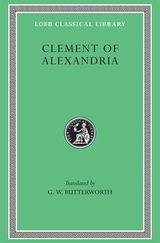 Clement of Alexandria: Exhortation to the Greeks. The Rich Man’s Salvation. To the Newly Baptized
Clement of Alexandria
Harvard University Press A scholarly evangelist.
Clement of Alexandria, famous Father of the Church, is known chiefly from his own works. He was born, perhaps at Athens, about AD 150, son of non-Christian parents; he converted to Christianity probably in early manhood. He became a presbyter in the Church at Alexandria and there succeeded Pantaenus in the catechetical school; his students included Origen and Bishop Alexander. He may have left Alexandria in 202, was known at Antioch, was alive in 211, and was dead before 220.
We have Clement’s Exhortation to the Greeks to give up gods for God and Christ; Tutor (3 books), wherein Clement instructs Christians on how to act in keeping with Christ’s teachings; Stromateis (Patchwork, 8 books), intending to stress the true nature of the Christian Gnostic; and Who Is the Man Who Is Saved? (an exposition of Mark 10:17–31). This volume contains the Exhortation to the Greeks, the treatise on the rich man, and an exhortation To the Newly Baptized. Clement was an eclectic philosopher of a neo-Platonic kind who later found a new philosophy in Christianity, and studied not only the Bible but the beliefs of Christian heretics.
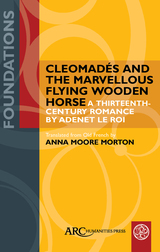 Cleomadés and the Marvellous Flying Wooden Horse: A Thirteenth-Century Romance by Adenet le Roi
Anna Moore Morton
Arc Humanities Press, 2024 A translation into English of Albert Henry’s definitive edition of Adenet le Roi’s Cleomadés, a story based on a tale from The One Thousand and One Nights.
Palace and pageantry, music and feast contribute to the poetic beauty of the tale, in which the hero Cleomadés and his sweetheart Clarmondine share love of an intensity evoking that of Layla and Majnun, of Isolde and Tristan, of Guinevere and Lancelot. When adventures with a mechanical flying horse separate them disastrously, the lovers undertake epic journeys and devise ingenious ruses to effect their eventual union. In medieval French tradition, their ardour is the consuming passion of the narrative. However, Cleomadés is replete with material on the status of women, of the disabled, of the insane, of religious toleration, of violent behaviour, of duty toward parents. Produced in Paris in 1285 under the patronage of Marie de Brabant, queen of France and daughter of Adenet’s first patron, Cleomadés crowns its author’s illustrious career.
Cleopatra
Prudence Jones
Haus Publishing, 2006 This biography concentrates on Cleopatra's ever-shifting identity. Depending on the audience, she might present herself as a goddess, a political leader, or an alluring and exotic woman. Roman statesmen likewise manipulated Cleopatra's image for their own political ends.
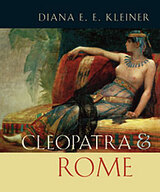 Cleopatra and Rome
Diana E. E. Kleiner
Harvard University Press, 2009 With the full panorama of her life forever lost, Cleopatra touches us in a series of sensational images: floating through a perfumed mist down the Nile; dressed as Venus for a tryst at Tarsus; unfurled from a roll of linens before Caesar; couchant, the deadly asp clasped to her breast. Through such images, each immortalizing the Egyptian queen's encounters with legendary Romans--Julius Caesar, Mark Antony, and Octavian Augustus--we might also chart her rendezvous with the destiny of Rome. So Diana Kleiner shows us in this provocative book, which opens an entirely new perspective on one of the most intriguing women who ever lived. Cleopatra and Rome reveals how these iconic episodes, absorbed into a larger historical and political narrative, document a momentous cultural shift from the Hellenistic world to the Roman Empire. In this story, Cleopatra's death was not an end but a beginning--a starting point for a wide variety of appropriations by Augustus and his contemporaries that established a paradigm for cultural conversion.
In this beautifully illustrated book, we experience the synthesis of Cleopatra's and Rome's defining moments through surviving works of art and other remnants of what was once an opulent material culture: religious and official architecture, cult statuary, honorary portraiture, villa paintings, tombstones, and coinage, but also the theatrical display of clothing, perfume, and hair styled to perfection for such ephemeral occasions as triumphal processions or barge cruises. It is this visual culture that best chronicles Cleopatra's legend and suggests her subtle but indelible mark on the art of imperial Rome at the critical moment of its inception.
Cleopatra in Italian and English Renaissance Drama
Anna Maria Montanari
Amsterdam University Press, 2019 This book considers some of the main adaptations of the character of Cleopatra for the Renaissance stage, travelling from Italy to England to arrive finally to Shakespeare. It shows how each reading of the story of Cleopatra is unique to and expressive of the culture which produced it, even as writers drew from the same sources from Antiquity. For the first time texts belonging to different cultures, rigorously presented, are brought into dialogue on such questions as moral standpoint, gender and the representation of the exotic. Moreover, through the fascinating figure of Cleopatra, the reader is able to explore the development of Renaissance tragedy, in its commercial and non-commercial versions. Ultimately both questions at the heart of this study - concerning Cleopatra's identity and her translation into theatre - converge to be (dis)solved by Shakespeare.
Clepsydra and Other Poems
Camilo Pessanha, Translated by Adam Mahler, Introduction by K. David Jackson
Tagus Press, 2021 The only collection of poems to be published by the Portuguese writer Camilo Pessanha during his lifetime, Clepsydra is the crowning achievement of the Portuguese symbolist movement. Meditating on the inexorable flow of time, Pessanha sets the music of his verses against the murmuring water clock that gives the book its title. This new annotated translation by Adam Mahler recreates in English the haunting melodies and evocative dreamscapes that were widely admired and emulated by Portuguese modernists such as Fernando Pessoa. In addition to the thirty poems of the original 1920 publication, the bilingual volume features eighteen compositions that appeared in subsequent editions, making it the most comprehensive scholarly edition of Clepsydra to date.
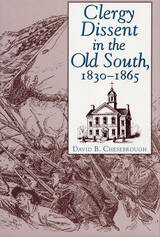 Clergy Dissent in the Old South, 1830 - 1865
David B. Chesebrough
Southern Illinois University Press, 1996
Emphasizing the courage required and the cost of dissent before and throughout the Civil War, David B. Chesebrough identifies dissenters among the southern clergy, tells their stories, and discusses the issues that caused these Christians to split from the majority
After an opening chapter in which he provides an overview of the role of the southern clergy in the antebellum and war years, Chesebrough turns to the South’s efforts to present a united proslavery front from 1830 to 1861. Clergy who could not support the "peculiar institution" kept silent, moved to the North, or suffered various consequences for their nonconformity.
Chesebrough then deals with the war years (1861–1865), when opposition to secession and the war was regarded as much more serious than opposition to slavery had been. Some members of the clergy who formally supported and justified slavery could not support secession and war. This was a dangerous stance, sometimes carrying a death sentence.
The final chapter, "The Creative Minority" stresses the important societal role of dissenters, who, history shows, often perceive events more clearly than the majority.
The dissenters Chesebrough discusses include John H. Aughey, a Presbyterian evangelist from Mississippi who was imprisoned and sentenced to death for his opposition to secession; William G. Brownlow, a Methodist cleric and newspaper publisher who, though he later became governor of Tennessee, was imprisoned and forced to leave the state because of his opposition to secession and the Civil War; John Gregg Fee, the founder of Berea College in Kentucky, who was denounced by his family and forced to leave the state because of his abolitionist views; and Melinda Rankin, a Presbyterian missionary worker in Brownsville, Texas, who was dismissed from her teaching responsibilities because of alleged northern sympathies.
 The Clergy Sexual Abuse Crisis: Reform and Renewal in the Catholic Community
Paul R. Dokecki
Georgetown University Press, 2004 The story of sexual abuse of children by Catholic priests has sent shock waves around the nation and will not fade from consciousness or the news. We ask, "How could this happen?" And then we ask, "How could the Catholic Church let this continue for so long—in seeming silence and duplicity?" Paul R. Dokecki, a community psychologist at Vanderbilt University, an active Catholic, and a former board member of the National Catholic Education Association, investigates the crisis not only with the eye of an investigative reporter, but with the analytical skills and training of a psychologist as well. Moreover, he lays the foundation for reasonable and practical reform measures. Through the scandal in the Archdiocese of Boston as well as the earlier, if less well known but momentous, case in the Diocese of Nashville, Dokecki reports on and analyzes what is ultimately an abuse of power—not only by the clergy but by church officials. As distasteful as these instances may be, they are compelling reading, enlightened by the author's abilities to contextualize these events through the lenses of professional ethics, the human sciences, and ecclesiology. According to Dokecki, these and other instances of clergy sexual abuse reveal a systemic deficiency in the structure and the nature of the church itself, one that has prevented the church from adequately dealing with its own worst sins. Dokecki may shine a spotlight into the church's dark corners—but he does so in the service of enlightenment, calling the church back toward the vision of Vatican II and the spirit of Pope John XXIII—toward a greater transparency, a more open and participatory governance in the church, and for a greatly expanded role for the people of God who make up the church. It is in this way, Dokecki believes, the church will be better able to keep the innocent children of the church safe from harm.
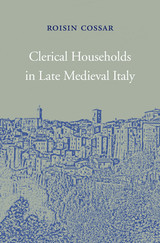 Clerical Households in Late Medieval Italy
Roisin Cossar
Harvard University Press, 2017 Roisin Cossar brings a new perspective to the history of the Christian church in fourteenth century Italy by examining how clerics managed efforts to reform their domestic lives in the decades after the arrival of the Black Death.
Priests at the end of the Middle Ages resembled their lay contemporaries as they entered into domestic relationships with women, fathered children, and took responsibility for managing households, or familiae. Cossar limns a complex portrait of daily life in the medieval clerical familia that traces the phases of its development. Many priests began their vocation as apprentices in the households of older clerics. In middle age, priests fully embraced the traditional role of paterfamilias—patriarchs with authority over their households, including servants and, especially in Venice, slaves. As fathers they endeavored to establish their illegitimate sons in a clerical family trade. They also used their legal knowledge to protect their female companions and children against a church that frowned on such domestic arrangements and actively sought to stamp them out.
Clerical Households in Late Medieval Italy refutes the longstanding charge that the late medieval clergy were corrupt, living licentious lives that failed to uphold priestly obligations. In fashioning a domestic culture that responded flexibly to their own needs, priests tempered the often unrealistic expectations of their superiors. Their response to the rigid demands of church reform allowed the church to maintain itself during a period of crisis and transition in European history.
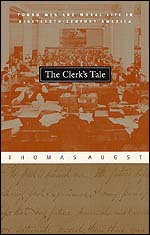 The Clerk's Tale: Young Men and Moral Life in Nineteenth-Century America
Thomas Augst
University of Chicago Press, 2003 Thousands of men left their families for the bustling cities of nineteenth-century America, where many of them found work as clerks. The Clerk's Tale recounts their remarkable story, describing the struggle of aspiring businessmen to come of age at the dawn of the modern era. How did these young men understand the volatile world of American capitalism and make sense of their place within it?
Thomas Augst follows clerks as they made their way through the boarding houses, parlors, and offices of the big city. Tracing the course of their everyday lives, Augst shows how these young men used acts of reading and writing to navigate the anonymous world of market culture and claim identities for themselves within it. Clerks, he reveals, calculated their prospects in diaries, composed detailed letters to friends and family, attended lectures by key thinkers of the day, joined libraries where they consumed fiction, all while wrestling with the boredom of their work. What results, then, is a poignant look at the literary practices of ordinary people and an affecting meditation on the moral lives of men in antebellum America.
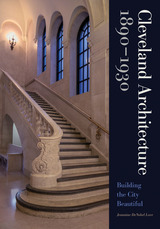 Cleveland Architecture 1890–1930: Building the City Beautiful
Jeannine deNobel Love
Michigan State University Press, 2020 This study looks at the architectural transformation of Cleveland during its “golden age”—roughly the period between post–Civil War reconstruction and World War I. By the early twentieth century, Cleveland, which would evolve into the fifth largest city in America, hoped to shed the gritty industrial image of its rapid-growth period and evolve into a city to match the political clout of its statesmen like John Hay and wealth of its business elites such as John D. Rockefeller. Encouraged by the spectacle and public response to the Beaux-Arts buildings of the Chicago World’s Exposition of 1893, the city embarked upon a grand scheme to construct new governmental and civic structures known as the Cleveland Plan of Grouping Public Buildings, one of the earliest and most complete City Beautiful planning schemes in the country. The success of this plan led to a spillover effect that prompted architects to design all manner of new public buildings with similar Beaux-Arts stylistic characteristics during the next three decades. With the group plan realized, civic leaders— with the goal of expanding the city’s cultural institutions to match the distinction of its civic center—established its counterpart in University Circle, creating a secondary group plan, the first cultural center in the country.
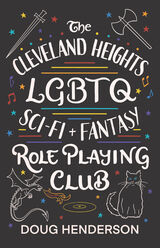 The Cleveland Heights LGBTQ Sci-Fi and Fantasy Role Playing Club
Doug Henderson
University of Iowa Press, 2021 On Thursday nights, the players assemble in the back of Readmore Comix and Games. Celeste is the dungeon master; Valerie, who works at the store, was roped in by default; Mooneyham, the banker, likes to argue; and Ben, sensitive, unemployed, and living at home, is still recovering from an unrequited love. In the real world they go about their days falling in love, coming out at work, and dealing with their family lives all with varying degrees of success. But in the world of their fantasy game, they are heroes and wizards fighting to stop an evil cult from waking a sleeping god. But then a sexy new guy, Albert, joins the club, Ben’s character is killed, and Mooneyham’s boyfriend is accosted on the street. The connections and parallels between the real world and the fantasy one become stronger and more important than ever as Ben struggles to bring his character back to life and win Albert’s affection, and the group unites to organize a protest at a neighborhood bar. All the while the slighted and competing vampire role playing club, working secretly in the shadows, begins to make its move.
Cleveland Jews and the Making of a Midwestern Community
Sean Martin
Rutgers University Press, 2020 This volume gathers an array of voices to tell the stories of Cleveland’s twentieth century Jewish community. Strong and stable after an often turbulent century, the Jews of Cleveland had both deep ties in the region and an evolving and dynamic commitment to Jewish life. The authors present the views and actions of community leaders and everyday Jews who embodied that commitment in their religious participation, educational efforts, philanthropic endeavors, and in their simple desire to live next to each other in the city’s eastern suburbs. The twentieth century saw the move of Cleveland’s Jews out of the center of the city, a move that only served to increase the density of Jewish life. The essays collected here draw heavily on local archival materials and present the area’s Jewish past within the context of American and American Jewish studies.
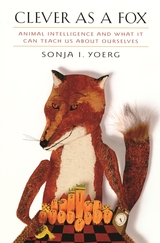 Clever as a Fox: Animal Intelligence and What It Can Teach Us about Ourselves
Sonja I. Yoerg
Harvard University Press Dogs are smarter than cats, dolphins and chimps are more clever than both, and we who determine the rankings top the scale--or so we think. But are we thinking clearly? To appreciate the mental abilities of the owl and the pussycat, the tortoise and the hare, requires a commitment to unraveling the nature of intelligence--a tricky and controversial proposition that Sonja Yoerg sets out to explore in this learned, lucid, and entertaining book about our complicated, often erroneous notions about animal intelligence.
With forays into evolutionary biology, behavioral science, and comparative psychology, Clever as a Fox reveals the promise and pitfalls inherent in any attempt to assess animal intelligence. Along with the concepts we deploy to define and compare intelligence, Yoerg looks at the expectations and prejudices that cloud our judgment of the animal mind, perceptions shaped as much by Aesop and Disney as by direct observation of our fellow creatures. And because such perceptions are inextricably linked with judgments of value--ideas about animal mentality have much to do with which species end up on our laps and which on our plates--this deeply revealing look at how we think about animal intelligence should help us use our own intelligence more wisely.
Clever, Kind, Tricky, and Sly: A Bulgarian Folktale Sampler
Priscilla Howe
Parkhurst Brothers, Inc., 2020 Translations of forty-two Bulgarian folktales, together with introductory essay and notes for teachers and storytellers following each story, with a list of Resources Cited.
Each folktale expresses an aspect of Bulgarian folk culture, presents characters who are clever enough to avoid ill-conceived courtship, kind enough to esteem even the poorest of neighbors, tricky enough to evade shysters, or sly enough to remain independent in the face of great power. Each of these traits has helped the Bulgarian people survive and thrive in a relatively poor, mountainous environment for more than fourteen centuries. In celebrating these traits and others, the folktales collected here honor the character of a people.
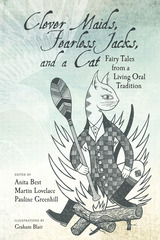 Clever Maids, Fearless Jacks, and a Cat: Fairy Tales from a Living Oral Tradition
Anita Best
Utah State University Press, 2019 Clever Maids, Fearless Jacks, and a Cat showcases the stories of two Newfoundland storytellers, Philip Pius Power and Alice Lannon. Ethnopoetic transcriptions of these sensitive and artful tales, which have been passed on orally for generations as part of a community tradition, give accounts of living oral performances from the last quarter of the twentieth century and demonstrate the artistry that is possible without the written word.
Here, eight tales from Power and five tales from Lannon take up issues of vital concern—such as spousal abuse, bullying, and social and generational conflict—allusively, through a screen of fiction. In commentary following the stories Anita Best, Martin Lovelace, and Pauline Greenhill discuss the transmission of fairy tales in oral tradition, address the relation of these magic tales to Lannon’s and Power’s other stories, and share specifics about Newfoundland storytelling and the two tellers themselves. The text is further enriched by expressive illustrations from artist Graham Blair.
Clever Maids, Fearless Jacks, and a Cat presents the fairy-tale oeuvres of two superb storytellers as a contribution to interdisciplinary fairy-tale studies and folklore—countering fairy-tale studies’ focus on written traditions and printed texts—as well as to gender studies, cultural studies, Newfoundland studies, and Canadian studies. Students, scholars, and general readers interested in folk and fairy tales, contemporary Märchen, Newfoundland folklore, or oral tradition more generally will find much of value in these pages.
Support for this publication was provided, in part, by the University of Winnipeg.
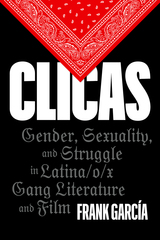 Clicas: Gender, Sexuality, and Struggle in Latina/o/x Gang Literature and Film
Frank García
University of Texas Press, 2024 2025 First Book Prize Honorable Mention, Cultural Studies Association How Latina/o/x gang literature and film represent women and gay gang members’ challenges to gendered, sexual, racial, and class oppression. Clicas examines Latina/o/x literature and film by and/or about gay and women gang members. Through close readings of literature and film, Frank García reimagines the typical narratives describing gang membership and culture, amplifying and complicating critical gang studies in the social sciences and humanities and looking at gangs across racial, ethnic, and national identities. Analyzing how the autobiographical poetry of Ana Castillo presents gang fashion, culture, and violence to the outside world, the effects of women performing female masculinity in the novel Locas, and gay gang members’ experiences of community in the documentary Homeboy, García complicates the dialogue regarding hypermasculine gang cultures. He shows how they are accessible not only to straight men but also to women and gay men who can appropriate them in complicated ways, which can be harming and also, at times, emancipating. Reading gang members as (de)colonial agents who contest the power relations, inequalities, oppressions, and hierarchies of the United States, Clicas considers how women and gay gang members resist materially and psychologically within a milieu shaped by the intersection of race, gender, sexuality, and class.
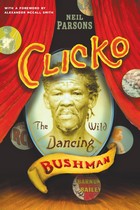 Clicko: The Wild Dancing Bushman
Neil Parsons
University of Chicago Press, 2010 During the 1920s and ’30s, Franz Taibosh—whose stage name was Clicko—performed in front of millions as one of the stars of the Ringling Brothers and Barnum & Bailey Circus. Prior to his fame in the United States, Taibosh toured the world as the “Wild Dancing Bushman,” showing off his frenzied dance moves in freak shows, sideshows, and music halls from Australia to Cuba. When he died in 1940, the New York Times called him “the only African bushman ever exhibited in this country.” In Clicko, Neil Parsons unearths the untold story of Taibosh’s journey from boyhood on a small farm in South Africa to top billing as one of the travelling World’s Fair Freaks.
Through Taibosh’s tale, Parsons brings to life the bizarre golden age of entertainment as well as the role that the dubious new science of race played in it. Beginning with Taibosh’s early life, Clicko untangles the real story of his ancestry from the web of myths spun around him on his rise to international stardom. Parsons then chronicles the unhappy middle period of Taibosh’s career, when he suffered under the heel of a vicious manager. Left to freeze and nearly starve in an unheated apartment, Taibosh was rescued by Frank Cook, Barnum & Bailey’s lawyer. The Cooks adopted Taibosh as a member of their family of circus managers and performers, and his happy—if far from average—years with them make up the final chapter of this remarkable story.
Equal parts entertaining and disturbing, Clicko vividly evokes a forgotten era when vaudeville drew massive crowds and circus freaks were featured in Billboard and Variety. Parsons introduces us to colorful characters such as George Auger the giant and the original Zip the Pinhead, but above all, he gives us an unforgettable portrait of Franz Taibosh, rescued at last from the racists and the romantics and revealed here as an ordinary man with an extraordinary life.
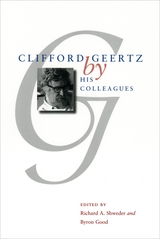 Clifford Geertz by His Colleagues
Edited by Richard A. Shweder and Byron Good
University of Chicago Press, 2005 Clifford Geertz is the most influential American anthropologist of the past four decades. His writings have defined and given character to the intellectual agenda of a meaning-centered, nonreductive interpretive social science and have provoked much excitement and debate about the nature of human understanding.
As part of the American Anthropological Association's centennial celebration, the executive board sponsored a presidential session honoring Geertz. Clifford Geertz by His Colleagues compiles the twelve speeches given then by a distinguished panel of social scientists along with a concluding piece by Geertz in which he responds to each speaker and reflects on his own career. These edited speeches cover a broad range of topics, including Geertz's views on morality, cultural critique, interpretivism, time and change, Islam, and violence.
A fitting tribute to one of the great thinkers of our age, this collection will be enjoyed by anthropologists as well as students of psychology, history, and philosophy.
Clifford W. Beers: Advocate for the Insane
Norman Dain
University of Pittsburgh Press, 1980 Norman Dain offers a compelling biography of Clifford W. Beers, whose lifelong battle against his own mental illness inspired him to become a champion for mental health. Beers' autobiography, A Mind That Found Itself, created a public outcry in 1908, as it chronicled Beers' experiences during his three-year confinement in an asylum. Despite his disability, Beers went on to found the National Committee for Mental Hygiene (now the National Association for Mental Health), the American Foundation for Mental Hygiene, and the International Committee for Mental Hygiene.
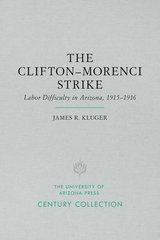 The Clifton-Morenci Strike: Labor Difficulty in Arizona, 1915–1916
James R. Kluger
University of Arizona Press, 1970 The strike that paralyzed the mining camps of Clifton and Morenci during 1915–16 and gained nationwide attention was one of the most remarkable that ever occurred in the West. During an era when physical violence, death, and property destruction were almost accepted elements of Western labor difficulties, this walkout was peaceful. With few exceptions, law and order continually predominated. This, then, is the seldom-seen side, a positive side, to a state's labor history.
Coming at a time when western labor was purging itself of radicalism and recharting its goals, the Clifton-Morenci strike may well have been that "milestone" in organized labor's groping for recognition in the West. Violence did not erupt—this notable absence of bloodshed thereby making the strike unique in that time of industrial turbulence.
Kluger's answer to the question of why and how peace prevailed is significant reading. Strikers and managers hurled charges at each other, but both sides showed restraint when it came to action. When negotiations reached an impasse, Governor George W. P. Hunt moved to prevent the managers from importing strike-breakers. At the same time, the Department of Labor entered the situation, and the rise in copper prices and loss of wages made a settlement desirable for both sides.
When the mine whistles blew on January 26, 1916, to signal the end of the strike, the repercussions of the events of 1915 were still to be felt. Author Kluger traces how the strike affected working conditions, wages, and the cause of unionism in the district. Overall, he provides insight into feelings concerning the fears of management regarding unionism, and labor's manner of making itself heard during these years.
Western historians, labor historians, and all those concerned with labor relations will recognize the importance of this highly readable work.
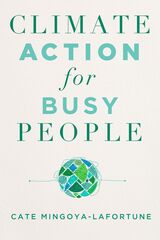 Climate Action for Busy People
Cate Mingoya-LaFortune
Island Press, 2024 As unprecedented heat waves, storms of the century, and devastating fires impact cities across the country, the time to create climate resilient communities is now. While large-scale innovations in policy and technology are necessary to preserve the planet, the wisest and most lasting adaptation solutions originate at the local level. However, with something as large as the climate crisis, it can be hard to know where to begin.
Climate Action for Busy People is a hopeful and realistic roadmap for individuals and groups who want to boost climate preparedness and move the needle towards environmental justice. Drawing from her professional and personal success in climate adaptation and community organizing, Cate Mingoya-LaFortune begins with a brief history of why our communities look the way they do (spoiler, it’s not an accident!) and how that affects how vulnerable we are to climate risks. Each chapter will help readers scale up their actions, from identifying climate solutions that an individual or small group can pull off in a handful of weekends, like tree plantings or depaving parties, to advocating for change at the municipal level through coalition-building and data collection. It’s not too late for people of all ages and skill levels to create climate safe neighborhoods.
Climate Action for Busy People is an invaluable guide for anyone who wants to make lasting and equitable improvements that will make their communities climate resilient.
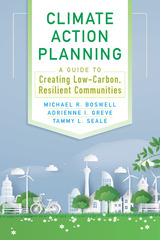 Climate Action Planning: A Guide to Creating Low-Carbon, Resilient Communities
Michael R. Boswell, Adrienne I. Greve, and Tammy L. Seale
Island Press, 2019 Climate change continues to impact our health and safety, the economy, and natural systems. With climate-related protections and programs under attack at the federal level, it is critical for cities to address climate impacts locally. Every day there are new examples of cities approaching the challenge of climate change in creative and innovative ways—from rethinking transportation, to greening city buildings, to protecting against sea-level rise.
Climate Action Planning is designed to help planners, municipal staff and officials, citizens and others working at local levels to develop and implement plans to mitigate a community's greenhouse gas emissions and increase the resilience of communities against climate change impacts. This fully revised and expanded edition goes well beyond climate action plans to examine the mix of policy and planning instruments available to every community. Boswell, Greve, and Seale also look at process and communication: How does a community bring diverse voices to the table? What do recent examples and research tell us about successful communication strategies?
Climate Action Planning brings in new examples of implemented projects to highlight what has worked and the challenges that remain. A completely new chapter on vulnerability assessment will help each community to identify their greatest risks and opportunities. Sections on land use and transportation have been expanded to reflect their growing contribution to greenhouse gas emissions. The guidance in the book is put in context of international, national, and state mandates and goals.
Climate Action Planning is the most comprehensive book on the state of the art, science, and practice of local climate action planning. It should be a first stop for any local government interested in addressing climate change.
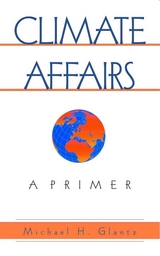 Climate Affairs: A Primer
Michael H. Glantz
Island Press, 2003 Climate Affairs sets forth in a concise primer the base of knowledge needed to begin to address questions surrounding the unknown impacts of climate change. In so doing, it outlines a new approach to understanding the interactions among climate, society, and the environment. Chapters consider: • the key concepts and terms in climate affairs
• the effects of climate around the world
• important but overlooked aspects of climate-society-environment interactions
• examples of societal uses, misuses, and potential uses of climate-related information such as forecasts
• a research agenda, challenges, and methodologies for future climate research. Climate Affairs draws on a range of study areas—including climate science, impacts on ecosystems and society, politics, policy and law, economics, and ethics—to address the complexity and gravity of impacts that our increasing vulnerability to climate portends. It is the first book to consider the full range of climate-related topics and the interactions among them, and will be a key resource for decision makers, as well as for students and scholars working in climate and related fields.
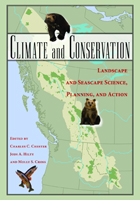 Climate and Conservation: Landscape and Seascape Science, Planning, and Action
Edited by Jodi A. Hilty, Charles C. Chester, and Molly S. Cross
Island Press, 2012 Climate and Conservation presents case studies from around the world of leading-edge projects focused on climate change adaptation-regional-scale endeavors where scientists, managers, and practitioners are working to protect biodiversity by protecting landscapes and seascapes in response to threats posed by climate change.
The book begins with an introductory section that frames the issues and takes a systematic look at planning for climate change adaptation. The nineteen chapters that follow examine particular case studies in every part of the world, including landscapes and seascapes from equatorial, temperate, montane, polar, and marine and freshwater regions. Projects profiled range from North American grasslands to boreal forests to coral reefs to Alpine freshwater environments.
Chapter authors have extensive experience in their respective regions and are actively engaged in working on climate-related issues. The result is a collection of geographical case studies that allows for effective cross-comparison while at the same time recognizing the uniqueness of each situation and locale.
Climate and Conservation offers readers tangible, place-based examples of projects designed to protect large landscapes as a means of conserving biodiversity in the face of the looming threat of global climate change. It informs readers of how a diverse set of conservation actors have been responding to climate change at a scale that matches the problem, and is an essential contribution for anyone involved with large-scale biodiversity conservation.
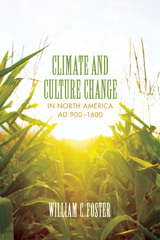 Climate and Culture Change in North America AD 900–1600
By William C. Foster
University of Texas Press, 2012 Climate change is today’s news, but it isn’t a new phenomenon. Centuries-long cycles of heating and cooling are well documented for Europe and the North Atlantic. These variations in climate, including the Medieval Warm Period (MWP), AD 900 to 1300, and the early centuries of the Little Ice Age (LIA), AD 1300 to 1600, had a substantial impact on the cultural history of Europe. In this pathfinding volume, William C. Foster marshals extensive evidence that the heating and cooling of the MWP and LIA also occurred in North America and significantly affected the cultural history of Native peoples of the American Southwest, Southern Plains, and Southeast. Correlating climate change data with studies of archaeological sites across the Southwest, Southern Plains, and Southeast, Foster presents the first comprehensive overview of how Native American societies responded to climate variations over seven centuries. He describes how, as in Europe, the MWP ushered in a cultural renaissance, during which population levels surged and Native peoples substantially intensified agriculture, constructed monumental architecture, and produced sophisticated works of art. Foster follows the rise of three dominant cultural centers—Chaco Canyon in New Mexico, Cahokia on the middle Mississippi River, and Casas Grandes in northwestern Chihuahua, Mexico—that reached population levels comparable to those of London and Paris. Then he shows how the LIA reversed the gains of the MWP as population levels and agricultural production sharply declined; Chaco Canyon, Cahokia, and Casas Grandes collapsed; and dozens of smaller villages also collapsed or became fortresses.
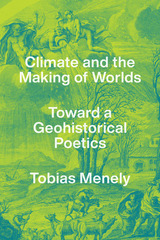 Climate and the Making of Worlds: Toward a Geohistorical Poetics
Tobias Menely
University of Chicago Press, 2021 Winner of the Society for Literature, Science, and the Arts Michelle Kendrick Memorial Book Prize and the Center for Robert Penn Warren Studies Warren-Brooks Award.
In this book, Tobias Menely develops a materialist ecocriticism, tracking the imprint of the planetary across a long literary history of poetic rewritings and critical readings which continually engage with the climate as a condition of human world making. Menely’s central archive is English poetry written between John Milton’s Paradise Lost (1667) and Charlotte Smith’s “Beachy Head” (1807)—a momentous century and a half during which Britain, emerging from a crisis intensified by the Little Ice Age, established the largest empire in world history and instigated the Industrial Revolution. Incorporating new sciences into ancient literary genres, these ambitious poems aspired to encompass what the eighteenth-century author James Thomson called the “system . . . entire.” Thus they offer a unique record of geohistory, Britain’s epochal transition from an agrarian society, buffeted by climate shocks, to a modern coal-powered nation. Climate and the Making of Worlds is a bracing and sophisticated contribution to ecocriticism, the energy humanities, and the prehistory of the Anthropocene.
 Climate Bridge: An International Perspective on How to Enact Climate Action at the Government Public Interface
Wolfram Höfer
Rutgers University Press, 2025 Climate change is creating new challenges for spatial and environmental planning on both sides of the Atlantic. Planning and policy must balance moderating climate change impact from rising temperatures, extreme precipitation, and sea level rise with social equity and environmental justice. Climate Bridge compares New Jersey and the German Ruhr region to build an international perspective on how to enact climate action at the government-public interface. The book grew from fifteen years of collaboration between scholars in New Jersey and Germany through summer programs, a landscape architecture design studio, internships for Rutgers University students, and joint publications. Notably, settlement patterns and brownfield issues reveal similarities between the underserved in both regions. The first section compares international environmental planning approaches and outlines different approaches to common problems. The second section presents case studies that highlight adaptation strategies for uncertainties caused by climate change. Finally, the closing section reminds us of our dependence on ecological systems for physical, mental, and emotional well-being. Contributors to this landmark volume include planners, designers, scholars, public administrators, and decision-makers on both sides of the Atlantic. Together, the chapters bring interdisciplinary approaches and diverse perspectives to the environmental, economic, political, and social dimensions of planning and design in the context of climate change.
 Climate by Proxy: A History of Scientific Reconstructions of the Past and Future
Melissa Charenko
University of Chicago Press, 2025 How twentieth-century scientists used proxies to understand historic climates, shaping scientific analyses of the past and the future.
Unlike our daily reckoning with the weather, our experience of climate must be mediated through methods that measure the ebb and flow of climate, such as computer models, instruments like thermometers, and organic and inorganic remains known as “proxies.” Climate by Proxy by Melissa Charenko explores how scientists read the record of past climates and how their readings have engendered particular understandings of climate. Charenko focuses on the twentieth century, a period when scientists in Europe and North America began to believe that climate had a dynamic history worth studying. Scientists in this period developed several techniques to infer past climate from fossil pollen, tree rings, pieces of vegetation, and other organic remains imprinted upon by former climates. Climate by Proxy examines how these techniques helped shape notions of climate itself.
Charenko also shows how these varied interpretations of climate played an outsized role in explanations of human history and destiny. Geologists, botanists, ecologists, and other scientists interested in climate over long timescales routinely discussed how climate influenced plants, animals, and, notably, people. By following the scientists who reconstructed climate using natural archives, Climate by Proxy demonstrates how material objects worked with scientists’ perceptions of human groups to compel, constrain, and reinforce their understandings of climate, history, and the future.
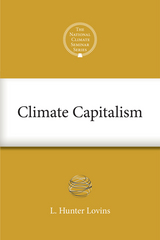 Climate Capitalism
L. Hunter Lovins
Island Press, 2012 On October 5, 2011, L. Hunter Lovins participated in The National Climate Seminar, a series of webinars sponsored by Bard College’s Center for Environmental Policy. The online seminars provide a forum for leading scientists, writers, and other experts to talk about critical issues regarding climate change. The series also opens a public conversation, inviting participants to ask questions and contribute their own thoughts. Lovins is President and founder of Natural Capitalism Solutions (NCS / www.natcapsolutions.org). NCS works with businesses, governments, and civil society to develop practices that are sustainable for both people and the environment. Her lecture focused on ways that the United States can pull itself out of the current recession, while preserving natural and human capital. This E-ssential is an edited version of Lovins’ talk and the subsequent question and answer session. While some material has been cut and some language modified for clarity, the intention was to retain the substance of the original discussion.
Climate, Capitalism and Communities: An Anthropology of Environmental Overheating
Astrid B. Stensrud
Pluto Press, 2019 Until now, the growing body of work on environmental anthropology has largely ignored the unavoidable impact of global capitalism on the environment and the extent to which capital itself is a key driver of climate change. Climate, Capitalism and Communities focuses explicitly on that nexus, examining the injustices and inequalities - as well as the activist responses - that have arisen as a result, and the contradictions between the imperatives of exponential economic growth, and those of environmental sustainability, and society as a whole. Bringing an innovative, ethnographic toolkit to bear on a crisis that is at once global and highly localised, the authors shift attention away from the consequences of climate change, to a focus on the social relations and power structures that continue to prevent effective action.
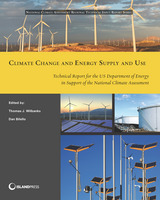 Climate Change and Energy Supply and Use: Technical Report for the U.S. Department of Energy in Support of the National Climate Assessment
Thomas J. Wilbanks
Island Press, 2014 Developed to inform the 3rd National Climate Assessment, and a landmark study in terms of its breadth and depth of coverage and conducted under the auspices of the U.S. Department of Energy, Climate Change and Energy Supply and Use examines the known effects and relationships of climate change variables on energy production and supply, including oil, gas, thermal electricity, and renewable energy.
Knowledge of today’s available energy forms is constantly surfacing and changing in the face of climate change, making it increasingly important to enhance communication about various energy supplies. This report on energy supply and use summarizes current knowledge, especially emerging findings, about implications of climate change for energy production and supply (oil and gas, thermal electricity, renewable energy, integrated perspectives, and indirect impacts on energy systems). A comprehensive resource for community planners and researchers, it discusses future risk-management strategies surrounding water treatment, heating or cooling, and mitigation that the country can utilize in its energy consumption. The authors analyze findings from their own research and practice to arrive at conclusions about vulnerabilities, risks, and impact concerns for different aspects of U.S. energy supply and use. Global and national policy contexts are informed by these efforts to create energy options and choices.
Rich in science and case studies, Climate Change and Energy Supply and Use offers decision makers and stakeholders a substantial basis from which to make informed choices that will affect energy risk-management in the decades to come.
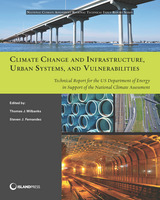 Climate Change and Infrastructure, Urban Systems, and Vulnerabilities: Technical Report for the U.S. Department of Energy in Support of the National Climate Assessment
Thomas J. Wilbanks and Steven Fernandez
Island Press, 2014 Hurricane Irene ruptured a Baltimore sewer main, resulting in 100 million gallons of raw sewage flooding the local watershed. Levee failures during Hurricane Katrina resulted in massive flooding which did not recede for months. With temperatures becoming more extreme, and storms increasing in magnitude, American infrastructure and risk-management policies require close examination in order to decrease the damage wrought by natural disasters. Climate Change and Infrastructure, Urban Systems, and Vulnerabilities addresses these needs by examining how climate change affects urban buildings and communities, and determining which regions are the most vulnerable to environmental disaster. It looks at key elements of urban systems, including transportation, communication, drainage, and energy, in order to better understand the damages caused by climate change and extreme weather. How can urban systems become more resilient? How can citizens protect their cities from damage, and more easily rebound from destructive storms? This report not only breaks new ground as a component of climate change vulnerability and impact assessments but also highlights critical research gaps in the material. Implications of climate change are examined by assessing historical experience as well as simulating future conditions.
Developed to inform the 3rd National Climate Assessment, and a landmark study in terms of its breadth and depth of coverage and conducted under the auspices of the U.S. Department of Energy, Climate Change and Infrastructure, Urban Systems, and Vulnerabilities examines the known effects and relationships of climate change variables on American infrastructure and risk-management policies. Its rich science and case studies will enable policymakers, urban planners, and stakeholders to develop a long-term, self-sustained assessment capacity and more effective risk-management strategies.
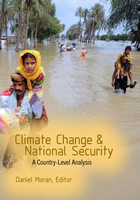 Climate Change and National Security: A Country-Level Analysis
Daniel Moran, Editor
Georgetown University Press, 2011 In this unique and innovative contribution to environmental security, an international team of scholars explore and estimate the intermediate-term security risks that climate change may pose for the United States, its allies and partners, and for regional and global order through the year 2030. In profiles of forty-two key countries and regions, each contributor considers the problems that climate change will pose for existing institutions and practices. By focusing on the conduct of individual states or groups of nations, the results add new precision to our understanding of the way environmental stress may be translated into political, social, economic, and military challenges in the future. Countries and regions covered in the book include China, Vietnam, The Philippines, Indonesia, India, Pakistan, Bangladesh, Central Asia, the European Union, the Persian Gulf, Egypt, Turkey, the Maghreb, West Africa, Southern Africa, the Northern Andes, and Brazil.
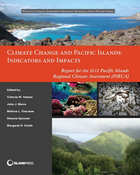 Climate Change and Pacific Islands: Indicators and Impacts: Report for the 2012 Pacific Islands Regional Climate Assessment
Edited by Victoria Keener with contributions from John J. Marra, Melissa L. Finucane, Deanna Spooner, and Margaret H. Smith
Island Press, 2013 Prepared for the 2013 National Climate Assessment and a landmark study in terms of its breadth and depth of coverage, Climate Change and the Pacific Islands was developed by the Pacific Islands Regional Climate Assessment, a collaborative effort engaging federal, state, and local government agencies, non-government organizations, academician, businesses, and community groups to inform and prioritize their activities in the face of a changing climate. The book assesses the state of knowledge about climate change indicators, impacts, and adaptive capacity of the Hawaiian archipelago and the US-Affiliated Pacific Islands.
The book provides the basis for understanding the key observations and impacts from climate change in the region, including the rise in surface air and sea-surface temperatures, along with sea levels, and the changes in ocean chemistry, rainfall amount and distribution, weather extremes, and widespread ecosystem changes.
Rich in science and case studies, it examines the latest climate change impacts, scenarios, vulnerabilities, and adaptive capacity and offers decision makers and stakeholders a substantial basis from which to make informed choices that will affect the well-being of the region’s inhabitants in the decades to come.
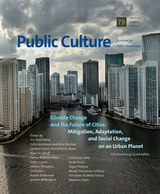 Climate Change and the Future of Cities
Eric Klinenberg, special issue editor
Duke University Press We live in the age of extremes, a period punctuated by significant disasters that have changed the way we understand risk, vulnerability, and the future of communities. Violent ecological events such as Superstorm Sandy attest to the urgent need to analyze what cities around the world are doing to reduce carbon emissions, develop new energy systems, and build structures to enhance preparedness for catastrophe. The essays in this issue illustrate that the best techniques for safeguarding cities and critical infrastructure systems from threats related to climate change have multiple benefits, strengthening networks that promote health and prosperity during ordinary times as well as mitigating damage during disasters. The contributors provide a truly global perspective on topics such as the toxic effects of fracking, water rights in the Los Angeles region, wind energy in southern Mexico, and water scarcity from Brazil to the Arabian Peninsula. Contributors: Nina Berman, Dominic Boyer, Daniel Aldana Cohen, Gökçe Günel, Cymene Howe, Colin Jerolmack, Eric Klinenberg, Liz Koslov, Andrew Lakoff, Valeria Procupez, Jerome Whitington, Austin Zeiderman
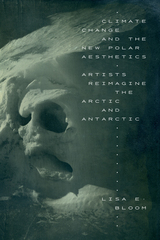 Climate Change and the New Polar Aesthetics: Artists Reimagine the Arctic and Antarctic
Lisa E. Bloom
Duke University Press, 2022 In Climate Change and the New Polar Aesthetics, Lisa E. Bloom considers the ways artists, filmmakers, and activists engaged with the Arctic and Antarctic to represent our current environmental crises and reconstruct public understandings of them. Bloom engages feminist, Black, Indigenous, and non-Western perspectives to address the exigencies of the experience of the Anthropocene and its attendant ecosystem failures, rising sea levels, and climate-led migrations. As opposed to mainstream media depictions of climate change that feature apocalyptic spectacles of distant melting ice and desperate polar bears, artists such as Katja Aglert, Subhankar Banerjee, Joyce Campbell, Judit Hersko, Roni Horn, Isaac Julien, Zacharias Kunuk, Connie Samaras, and activist art collectives take a more complex poetic and political approach. In their films and visual and conceptual art, these artists link climate change to its social roots in colonialism and capitalism while challenging the suppression of information about environmental destruction and critiquing Western art institutions for their complicity. Bloom’s examination and contextualization of new polar aesthetics makes environmental degradation more legible while demonstrating that our own political agency is central to imagining and constructing a better world.
 Climate Change and the Production of Knowledge
Ian Baucom and Matthew Omelsky, special issue editors
Duke University Press, 2017 Though the causes and effects of climate change pervade our everyday lives—the air we breathe, the food we eat, the objects we use—the way the discourse of climate change influences how we make meaning of ourselves and our world is still unexplored. Contributors to this issue bring diverse perspectives to the ways that climate change science and discourse have reshaped the contemporary architecture of knowledge itself: reconstituting intellectual disciplines and artistic practices, redrawing and dissolving boundaries, and reframing how knowledge is represented and disseminated. The contributors address the emergence of global warming discourse in fields like history, journalism, anthropology, and the visual arts; the collaborative study of climate change between the human and material sciences; and the impact of climate change on forms of representation and dissemination in this new interdisciplinary landscape.
Contributors. Ian Baucom, Rosi Braidotti, David Buckland, Matthew Burtner, Noel Castree, Dipesh Chakrabarty, Tom Cohen, Claire Colebrook, Olivia Gray, Willis Jenkins, Catherine Malabou, Matthew Omelsky, Michael Segal, Bently Spang, Gary Tomlinson, Astrid Ulloa, Lucy Wood
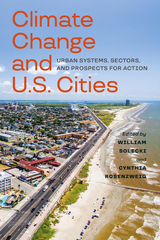 Climate Change and U.S. Cities: Urban Systems, Sectors, and Prospects for Action
Edited by William Solecki and Cynthia Rosenzweig
Island Press, 2021 Approximately 80% of the U.S. population now lives in urban metropolitan areas, and this number is expected to grow significantly in the coming years. At the same time, the built infrastructure sustaining these populations has become increasingly vulnerable to climate change. Stresses to existing systems, such as buildings, energy, transportation, water, and sanitation are growing. If the status quo continues, these systems will be unable to support a high quality of life for urban residents over the next decades, a vulnerability exacerbated by climate change impacts. Understanding this dilemma and identifying a path forward is particularly important as cities are becoming leading agents of climate action.
Prepared as a follow-up to the Fourth National Climate Assessment (NCA), Climate Change and U.S. Cities documents the current understanding of existing and future climate risk for U.S. cities, urban systems, and the residents that depend on them. Beginning with an examination of the existing science since 2012, chapters develop connections between existing and emerging climate risk, adaptation planning, and the role of networks and organizations in facilitating climate action in cities. From studies revealing disaster vulnerability among low-income populations to the development of key indicators for tracking climate change, this is an essential, foundational analysis. Importantly, the assessment puts a critical emphasis on the cross-cutting factors of economics, equity, and governance.
Urban stakeholders and decision makers will come away with a full picture of existing climate risks and a set of conclusions and recommendations for action. Many cities in the United States still have not yet planned for climate change and the costs of inaction are great. With bold analysis, Climate Change and U.S. Cities reveals the need for action and the tools that cities must harness to effect decisive, meaningful change.
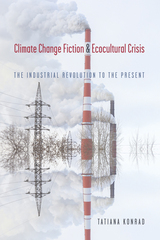 Climate Change Fiction and Ecocultural Crisis: The Industrial Revolution to the Present
Tatiana Konrad
University of Nevada Press, 2024 Concentrating on a powerful, emerging genre, Tatiana Konrad’s Climate Change Fiction and Ecocultural Crisis provides a survey of popular narratives that further our understanding of climate change in contemporary fiction. Konrad advocates for the expansion and redefinition of the cli-fi genre and argues that industrial fiction from the nineteenth century is the first example of climate change fiction. Tracing the ways through which cli-fi outlines a history of our modern ecocultural crisis, this book demonstrates how the genre employs four major thematic clusters to achieve this narrative: weather, science, religion, and place.
Focusing on a diverse range of issues, including fossil fuels, cheap energy, the intricacies of human–more-than-human relationships, and postcolonial geographies, Konrad illustrates how cli-fi transcends mere storytelling. The genre ultimately emerges as an important means to forecast, imagine, and contemplate climatic events.
The book invites a broadening of the environmental humanities discourse, asking readers not only to deepen their understanding of the current climate crisis, but also to consider how cli-fi culture can be viewed as an effective method to address climate change.
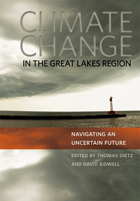 Climate Change in the Great Lakes Region: Navigating an Uncertain Future
Thomas Dietz
Michigan State University Press, 2012 People living in the Great Lakes region are already feeling the effects of a changing climate. Shifts in seasonal temperatures and precipitation patterns could have dramatic impacts on the economy, ecology, and quality of life. In this illuminating and thorough volume, leading scholars address the challenge of preparing for climate change in the region, where decision makers from various sectors—government, agriculture, recreation, and tourism—must increasingly be aware of the need to incorporate climate change into their short- and long-term planning. The chapters in this revealing book, written by some of the foremost climate change scholars in North America, outline the major trends in the climate of the Great Lakes region, how humans might cope with the uncertainty of climate change impacts, and examples of on-the-ground projects that have addressed these issues.
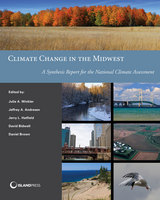 Climate Change in the Midwest: A Synthesis Report for the National Climate Assessment
Edited by Julie A. Winkler, Jeffrey A. Andersen, Jerry L. Hatfield, David Bidwell, and Daniel Brown
Island Press, 2013 Developed to inform the 2013 National Climate Assessment, and a landmark study in terms of its breadth and depth of coverage and conducted under the auspices of the U.S. Global Change Research Program, Climate Change in the Midwest examines the known effects and relationships of climate change variables on the eight states that make up the region.
This state of the art assessment comes from a broad range of experts in academia, private industry, state and local governments, NGOs, professional societies, and impacted communities. It highlights past climate trends, projected climate change and vulnerabilities, and impacts to specific sectors. Rich in science and case studies, it examines the latest climate change impacts, scenarios, vulnerabilities, and adaptive capacity and offers decision makers and stakeholders a substantial basis from which to make informed choices that will affect the well-being of the region’s inhabitants in the decades to come.
 Climate Change in the Northeast: A Sourcebook
Edited by Radley Horton
Island Press, 2015 Developed to inform the 2013 National Climate Assessment, and a landmark study in terms of its breadth and depth of coverage and conducted under the auspices of the U.S. Global Change Research Program, Climate Change in the Northeast examines the known effects and relationships of climate change variables on the Northeast region, encompassing New England, the Mid-Atlantic, Chesapeake Bay Area and Appalachia.
Prepared by a broad range of experts in academia, private industry, state and local governments, NGOs, professional societies, and impacted communities, it highlights past climate trends, projected climate change and vulnerabilities, and impacts to specific sectors and includes case studies on topics such as adaptive capacity and climate change effects.
Rich in science and case studies, it examines the latest climate change impacts, scenarios, vulnerabilities, and adaptive capacity and offers decision makers and stakeholders a substantial basis from which to make informed choices that will affect the well-being of the region’s inhabitants in the decades to come.
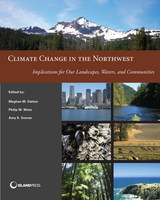 Climate Change in the Northwest: Implications for Our Landscapes, Waters, and Communities
Edited by Meghan M. Dalton, Philip Mote, and Amy K. Snover
Island Press, 2013 Climate Change in the Northwest: Implications for Our Landscapes, Waters, and Communities is aimed at assessing the state of knowledge about key climate impacts and consequences to various sectors and communities in the northwest United States. It draws on a wealth of peer-reviewed literature, earlier state-level assessment reports conducted for Washington (2009) and Oregon (2010), as well as a risk-framing workshop. As an assessment, it aims to be representative (though not exhaustive) of the key climate change issues as reflected in the growing body of Northwest climate change science, impacts, and adaptation literature now available.
This report will serve as an updated resource for scientists, stakeholders, decision makers, students, and community members interested in understanding and preparing for climate change impacts on Oregon, Washington, and Idaho. This more detailed, foundational report is intended to support the key findings presented in the Northwest chapter of the Third National Climate Assessment.
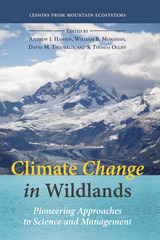 Climate Change in Wildlands: Pioneering Approaches to Science and Management
Andrew J. Hansen, William B. Monahan, David M. Theobald, and S. Thomas Olliff
Island Press, 2016 Scientists have been warning for years that human activity is heating up the planet and climate change is under way. In the past century, global temperatures have risen an average of 1.3 degrees Fahrenheit, a trend that is expected to only accelerate. But public sentiment has taken a long time to catch up, and we are only just beginning to acknowledge the serious effects this will have on all life on Earth. The federal government is crafting broad-scale strategies to protect wildland ecosystems from the worst effects of climate change. The challenge now is to get the latest science into the hands of resource managers entrusted with protecting water, plants, fish and wildlife, tribal lands, and cultural heritage sites in wildlands.
Teaming with NASA and the Department of the Interior, ecologist Andrew Hansen, along with his team of scientists and managers, set out to understand how climate and land use changes affect montane landscapes of the Rockies and the Appalachians, and how these findings can be applied to wildlands elsewhere. They examine changes over the past century as well as expected future change, assess the vulnerability of species and ecosystems to these changes, and provide new, collaborative management approaches to mitigate expected impacts. A series of case studies showcases how managers might tackle such wide-ranging problems as the effects of warming streams on cold-water fish in Great Smoky Mountain National Park and dying white-bark pine stands in the Greater Yellowstone area. A surprising finding is that species and ecosystems vary dramatically in vulnerability to climate change. While many will suffer severe effects, others may actually benefit from projected changes.
Climate Change in Wildlands is a collaboration between scientists and managers, providing a science-derived framework and common-sense approaches for keeping parks and protected areas healthy on a rapidly changing planet.
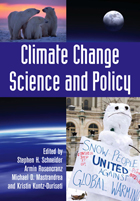 Climate Change Policy: A Survey
Edited by Stephen H. Schneider, Armin Rosencranz, and John O. Niles
Island Press, 2002 Questions surrounding the issue of climate change are evolving from "Is it happening?" to "What can be done about it?" The primary obstacles to addressing it at this point are not scientific but political and economic; nonetheless a quick resolution is unlikely. Ignorance and confusion surrounding the issue -- including a lack of understanding of climate science, its implications for the environment and society, and the range of policy options available -- contributes to the political morass over dealing with climate change in which we find ourselves. Climate Change Policy addresses that situation by bringing together a wide range of new writings from leading experts that examine the many dimensions of the topics most important in understanding climate change and policies to combat it. Chapters consider: - climate science in historical perspective
- analysis of uncertainties in climate science and policy
- the economics of climate policy
- North-South and intergenerational equity issues
- the role of business and industry in climate solutions
- policy mechanisms including joint implementation, emissions trading, and the so-called clean development mechanism
Regardless of the fate of the Kyoto Protocol, the issues raised in that debate will persist as new climate protection regimes emerge; this volume treats most of those topics. Tying the chapters together is a shared conclusion that climate change is a real and serious problem, and that we as a society have an obligation not merely to adapt to it but to mitigate it in whatever intelligent ways we can develop. Cost-effectiveness is not disdained, but neither is the imperative for valuing species threatened by rapid climate change.
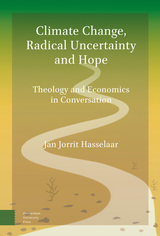 Climate Change, Radical Uncertainty and Hope: Theology and Economics in Conversation
Jan Jorrit Hasselaar
Amsterdam University Press, 2023 Views on climate change are often either pessimistic or optimistic. In this book Jan Jorrit Hasselaar discovers and explores a third way, one of hope. A debate within economics on risk and uncertainty brings him to theological questions and the concept of hope in the work of the late Jonathan Sacks—and to a renewed way of doing theology as an account of the good life. What follows is an equal conversation between theology and economics as has hardly been undertaken in recent times. It emerges that hope is not contrary to economic insights, but remarkably compatible with them. Communication between these fields of expertise can open the way for a courageous and creative embrace of radical uncertainty in climate change. A key notion here is that of a public Sabbath, or a ‘workplace of hope’—times and places set aside to cultivate inspiration and mutual trust among all parties involved, enabling them to take concrete steps forward.
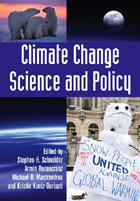 Climate Change Science and Policy
Stephen H. Schneider, Armin Rosencranz, Michael D. Mastrandrea, and Kristin Kuntz-Duriseti
Island Press, 2009 This is the most comprehensive and current reference resource on climate change available today. It features 49 individual chapters by some of the world’ s leading climate scientists. Its five sections address climate change in five dimensions: ecological impacts; policy analysis; international considerations; United States considerations; and mitigation options to reduce carbon emissions.
In many ways, this volume supersedes the Fourth Assessment Report of the Intergovernmental Panel on Climate Change (IPCC). Many important developments too recent to be treated by the 2007 IPCC documents are covered here. This book considers not only the IPCC report, but also results of the UN Framework Convention on Climate Change held in Bali in December 2007, as well as even more recent research data. Overall, Climate Change Science and Policy paints a direr picture of the effects of climate change than do the IPCC reports. It reveals that climate change has progressed faster than the IPCC reports anticipated and that the outlook for the future is bleaker than the IPCC reported.
In his prologue, John P. Holdren writes that the widely-used term “ global warming” is a misnomer. He suggests that a more accurate label would be “ global climatic disruption.” This volume, he states, will equip readers with all they need to know to rebut the misrepresentations being propagated by “ climate-change skeptics.” No one, he writes, will be a skeptic after reading this book.
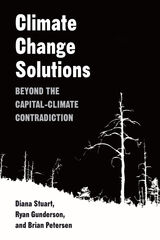 Climate Change Solutions: Beyond the Capital-Climate Contradiction
Diana Stuart, Ryan Gunderson, and Brian Petersen
University of Michigan Press, 2020 Climate Change Solutions represents an application of critical theory to examine proposed solutions to climate change. Drawing from Marx’s negative conception of ideology, the authors illustrate how ideology continues to conceal the capital-climate contradiction or the fundamental incompatibility between growth-dependent capitalism and effectively and justly mitigating climate change. Dominant solutions to climate change that offer minor changes to the current system fail to address this contradiction. However, alternatives like degrowth involve a shift in priorities and power relations and can offer new systemic arrangements that confront and move beyond the capital-climate contradiction. While there are clear barriers to a systemic transition that prioritizes social and ecological well-being, such a transition is possible and desirable.
Climate Change: The Ipcc Response Strategies
; Intergovernmental Panel on Climate Change
Island Press, 1991 Climate Change is the report of Working Group III of the Intergovernmental Panel on Climate Change (IPCC), established in 1988 by the World Meteorological Organization and UNEP to address the threat of global warming on an international scale.
Climate Change: The Point of No Return
Mojib Latif
Haus Publishing, 2009 There is no doubt: climate change is happening, and mankind is increasingly to blame. Climate Change: The Point of No Return provides a solid basis for the current discussion about climate change, by addressing the arguments from both sides of the debate and offering an objective evaluation of the facts. Using the latest scientific information about the causes of the global climate change, Professor Latif presents the likely scenario that will face us if we don't dedicate ourselves to a course of sustainable development, and offers concrete options for action.
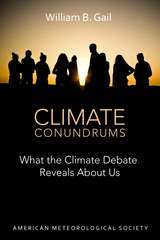 Climate Conundrums: What the Climate Debate Reveals About Us
William B. Gail
American Meteorological Society, 2014 It is generally assumed that, in polite company, you don’t talk politics, religion, or money. But in recent years, it seems “climate change” needs to be added to that list. Incorporating all of the above, few topics can divide a dinner party faster. Yet, while much ink has been spilled on both sides of the issue, few have considered the debate itself and what it reveals about modern culture.
Climate Conundrums is a journey through how we as humans think, individually and collectively, about the debate. It eschews rhetoric or fist-pounding conclusions and instead explores our ongoing attempts to reach a societal understanding about climate change and how we should respond to it. The essays throughout are broadly organized around our relationship with nature, the challenges facing human society, and the path ahead for civilization. Each begins with a question—Can we make nature better? Could science and religion reconcile?—and from there follows an introspective path through all sides of the debates. Some are longstanding issues, such as whether humans are growing increasingly distant from nature. Others are brought on by recent developments, such as whether technology can eventually solve all of society’s needs.
While no final answers are given, the insights that come from reflecting on these questions can help us better find our way and better connect with each other across the climate divide.
 Climate Dependence and Food Problems in Russia, 1900-1990: The Interaction of Climate and Agricultural Policy and Their Effect on Food Problems
Nikolai M. Dronin
Central European University Press, 2006 Between 1900 and 1990 there were several periods of grain and other food shortages in Russia and the former Soviet Union, some of which reached disaster proportions resulting in mass famine and death on an unprecedented scale. New stocks of information not previously accessible as well as traditional official and other sources have been used to explore the extent to which policy and vagaries in climate conspired to affect agricultural yields. Were the leaders' (Stalin, Krushchev, Brezhnev and Gorbachev) policies sound in theory but failed in practice because of unpredictable weather? How did the Soviet peasants react to these changes? What impact did Soviet agriculture have on the overall economy of the country? These are all questions that are taken into account. The book is arranged in chapters representing different time periods. In each the policy of the central government is discussed followed by the climate vagaries during that period. Crop yields are then analyzed in the light of policy and climate.
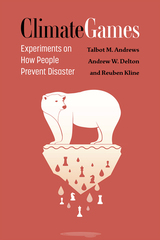 Climate Games: Experiments on How People Prevent Disaster
Talbot M. Andrews, Andrew W. Delton, and Reuben Kline
University of Michigan Press, 2024 Can humanity work together to mitigate the effects of climate change? Climate Games argues we can. This book brings together a decade and a half of experimentation, conducted by researchers around the world, which shows that people can and will work together to prevent disasters like climate change. These experiments, called economic games, put money on the line to create laboratory disasters. Participants must work together by spending a bit of money now to prevent themselves from losing even more money in the future. Will people sacrifice their own money to prevent disaster? Can people make wise decisions? And can people decide wisely on behalf of others? The answer is a resounding yes.
Yet real climate change is a complex social dilemma involving the world’s nearly eight billion inhabitants. In the real world, the worst effects of climate change are likely to be felt by developing countries, while most of the decisions will be made by rich, industrialized countries. And while the world as a whole would be better off if all nations reduced their greenhouse gas emissions, any given nation could decide it would be even better off if it continued emitting and let other nations take care of the problem. These disaster experiments test how real people respond to climate change’s unique constellation of challenges and deliver a positive message: People will prevent disaster.
Climate Ghosts: Migratory Species in the Anthropocene
Nancy Langston
Brandeis University Press, 2021 Climate Ghosts deals with the important issue of climate change and human impact on three species: woodland caribou, common loons, and lake sturgeon.
Environmental historian Nancy Langston explores three “ghost species” in the Great Lakes watershed—woodland caribou, common loons, and lake sturgeon. Ghost species are those that have not gone completely extinct, although they may be extirpated from a particular area. Their traces are still present, whether in DNA, in small fragmented populations, in lone individuals roaming a desolate landscape in search of a mate. We can still restore them if we make the hard choices necessary for them to survive. In this meticulously researched book, Langston delves into how climate change and human impact affected these now ghost species. Climate Ghosts covers one of the key issues of our time.
 Climate, God and Uncertainty: A Transcendental Naturalistic Approach Beyond Bruno Latour
Arthur C. Petersen
University College London, 2023 An inquiry into the philosophical implications of climate change and its associated uncertainties.
Climate, God and Uncertainty brings together the philosophical approaches of pragmatism and (neo-) Kantianism in transcendental naturalism. The new approach is based on combining an expansive concept of “nature” with an emphasis on the separate ontological status of transcendental values. This book moves beyond Bruno Latour’s thought to understand what climate change means for philosophical anthropology and wider culture.
Referring mainly to works by Latour, William James, and Heinrich Rickert, this book develops a cultural philosophical approach called “transcendental naturalism.” This approach reinterprets the interface between science and politics in the context of climate change, highlighting, for instance, issues such as the religious disenchantment of nature, the scientific disbelief in a plurality of value-laden perspectives, and the disregard for non-modern worldviews in politics. In developing its argument, the book makes a methodological intervention on the sort of naturalism that guides both Latour’s work and a large part of the academic field called “science and religion.”
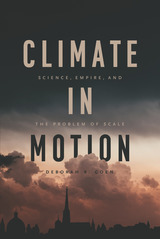 Climate in Motion: Science, Empire, and the Problem of Scale
Deborah R. Coen
University of Chicago Press, 2018 Today, predicting the impact of human activities on the earth’s climate hinges on tracking interactions among phenomena of radically different dimensions, from the molecular to the planetary. Climate in Motion shows that this multiscalar, multicausal framework emerged well before computers and satellites. Extending the history of modern climate science back into the nineteenth century, Deborah R. Coen uncovers its roots in the politics of empire-building in central and eastern Europe. She argues that essential elements of the modern understanding of climate arose as a means of thinking across scales in a state—the multinational Habsburg Monarchy, a patchwork of medieval kingdoms and modern laws—where such thinking was a political imperative. Led by Julius Hann in Vienna, Habsburg scientists were the first to investigate precisely how local winds and storms might be related to the general circulation of the earth’s atmosphere as a whole. Linking Habsburg climatology to the political and artistic experiments of late imperial Austria, Coen grounds the seemingly esoteric science of the atmosphere in the everyday experiences of an earlier era of globalization. Climate in Motion presents the history of modern climate science as a history of “scaling”—that is, the embodied work of moving between different frameworks for measuring the world. In this way, it offers a critical historical perspective on the concepts of scale that structure thinking about the climate crisis today and the range of possibilities for responding to it.
Climate in the Age of Empire: Weather Observers in Colonial Canada
Victoria C. Slonosky
American Meteorological Society, 2018 Though efforts to understand human-caused climate change have intensified in recent decades, weather observers have been paying close attention to changes in climate for centuries. This book offers a close look at that work as it was practiced in Canada since colonial times. Victoria C. Slonosky shows how weather observers throughout Canada who had been trained in the scientific tradition inherited from their European forebears built a scientific community and amassed a remarkable body of detailed knowledge about Canada’s climate and its fluctuations, all rooted in firsthand observation. Covering work by early French and British observers, the book presents excerpts from weather diaries and other records that, more than the climate itself, reveal colonial attitudes toward it.
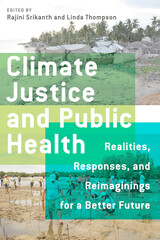 Climate Justice and Public Health: Realities, Responses, and Reimaginings for a Better Future
Edited by Rajini Srikanth and Linda Thompson
University of Massachusetts Press, 2024 When climate disasters like hurricanes, heatwaves, and tsunamis strike, they reveal the inequities of our social, political, and economic structures. They also lay bare the negative impacts of these structures on the health and safety of all people, and particularly socioeconomically vulnerable groups. With original contributions from scholars from a wide range of diverse fields—including environmental studies, public health, legal studies, urban planning, literary studies, and nursing—Climate Justice and Public Health examines this nexus of climate change, which has become impossible to ignore in the twenty-first century.
Expanding the climate and health equity discussions to populations all over the globe, the contributors in this volume address an impressive and broad range of topics that include Indigenous health and cultural practices, mental and emotional health, senior health, and impacts on African American communities. Collectively, they present radical new ways of confronting these issues and propose holistic solutions.
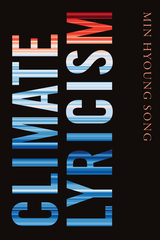 Climate Lyricism
Min Hyoung Song
Duke University Press, 2022 In Climate Lyricism Min Hyoung Song articulates a climate change-centered reading practice that foregrounds how climate is present in most literature. Song shows how literature, poetry, and essays by Tommy Pico, Solmaz Sharif, Frank O’Hara, Ilya Kaminsky, Claudia Rankine, Kazuo Ishiguro, Teju Cole, Richard Powers, and others help us to better grapple with our everyday encounters with climate change and its disastrous effects, which are inextricably linked to the legacies of racism, colonialism, and extraction. These works employ what Song calls climate lyricism—a mode of address in which a first-person “I” speaks to a “you” about how climate change thoroughly shapes daily life. The relationship between “I” and “you” in this lyricism, Song contends, affects the ways readers comprehend the world, fostering a model of shared agency from which it can become possible to collectively and urgently respond to the catastrophe of our rapidly changing climate. In this way, climate lyricism helps to ameliorate the sense of being overwhelmed and feeling unable to do anything to combat climate change.
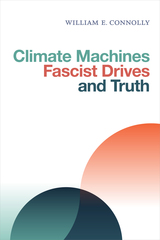 Climate Machines, Fascist Drives, and Truth
William E. Connolly
Duke University Press, 2019 In this new installation of his work, William E. Connolly examines entanglements between volatile earth processes and emerging cultural practices, highlighting relays among extractive capitalism, self-amplifying climate processes, migrations, democratic aspirations, and fascist dangers. In three interwoven essays, Connolly takes up thinkers in the "minor tradition" of European thought who, unlike Cartesians and Kantians, cross divisions between nature and culture. He first offers readings of Sophocles and Mary Shelley, asking whether close attention to the Anthropocene could perhaps have arrived earlier had subsequent humanists absorbed their lessons. He then joins Deleuze and Guattari's notion of an abstract machine with contemporary earth sciences, doing so to compare the Antique Little Ice Age of the late Roman empire to contemporary relays between extractive capitalism and accelerating climate processes. The final essay stages a dramatic dialogue between Alfred North Whitehead and Michel Foucault about the pursuit of truth during a time of planetary turbulence. With Climate Machines Fascist Drives, and Truth, Connolly forges incisive interventions into key issues of our time.
Climate of Alaska
Martha Shulski and Gerd Wendler
University of Alaska Press, 2007 Those of us in the lower forty-eight states tend to think of Alaska as an unremitting wasteland of frigid temperatures, ice, and snow. But in reality, because of its immense size and its position at the edge of the Arctic, Alaska has a remarkably varied and complex climate.
Replete with striking photos, maps, and charts, The Climate of Alaska presents a detailed picture of what to expect in this state of climate extremes. From the 40-below temperatures of the Interior to the twenty-four hours of daylight in a northern summer, Alaska’s climate presents challenges to its inhabitants on a daily basis. Readers will find accessible descriptions of temperature, humidity, precipitation, and climate change that will enrich a visit to the state and provide insight on the living conditions of this fascinating place.
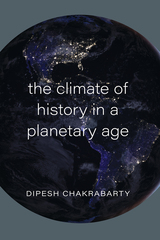 The Climate of History in a Planetary Age
Dipesh Chakrabarty
University of Chicago Press, 2021 For the past decade, historian Dipesh Chakrabarty has been one of the most influential scholars addressing the meaning of climate change. Climate change, he argues, upends long-standing ideas of history, modernity, and globalization. The burden of The Climate of History in a Planetary Age is to grapple with what this means and to confront humanities scholars with ideas they have been reluctant to reconsider—from the changed nature of human agency to a new acceptance of universals.
Chakrabarty argues that we must see ourselves from two perspectives at once: the planetary and the global. This distinction is central to Chakrabarty’s work—the globe is a human-centric construction, while a planetary perspective intentionally decenters the human. Featuring wide-ranging excursions into historical and philosophical literatures, The Climate of History in a Planetary Age boldly considers how to frame the human condition in troubled times. As we open ourselves to the implications of the Anthropocene, few writers are as likely as Chakrabarty to shape our understanding of the best way forward.
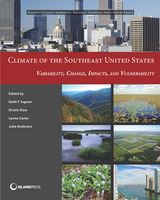 Climate of the Southeast United States: Variability, Change, Impacts, and Vulnerability
Edited by Keith Ingram
Island Press, 2013 Prepared for the 2013 National Climate Assessment and a landmark study in terms of its breadth and depth of coverage, Climate of the Southeast United States is the result of a collaboration among three Regional Integrated Sciences and Assessments Centers: the Southeast Climate Consortium; the Carolinas Regional Sciences and Assessments; and the Southern Climate Impacts Planning Program; with contributions from numerous local, state, federal, and nongovernmental agencies to develop a comprehensive, state of the art look at the effects of climate change in the region. The book summarizes the scientific literature with respect to climate impacts on the Southeast United States, including 11 southern states to the east of the Mississippi River, Puerto Rico, and the US Virgin Islands; reviews the historic climate, current climate, and the projected future climate of the region; and describes interactions with important sectors of the Southeast and cross-sectoral issues, namely climate change mitigation, adaptation, and education and outreach. Rich in science and case studies, it examines the latest climate change impacts, scenarios, vulnerabilities, and adaptive capacity and offers decision makers and stakeholders a substantial basis from which to make informed choices that will affect the well-being of the region’s inhabitants in the decades to come.
 A Climate Policy Revolution: What the Science of Complexity Reveals about Saving Our Planet
Roland Kupers
Harvard University Press, 2020 Humanity’s best hope for confronting the looming climate crisis rests with the new science of complexity.
The sheer complexity of climate change stops most solutions in their tracks. How do we give up fossil fuels when energy is connected to everything, from great-power contests to the value of your pension? Global economic growth depends on consumption, but that also produces the garbage now choking the oceans. To give up cars, coal, or meat would upend industries and entire ways of life. Faced with seemingly impossible tradeoffs, politicians dither and economists offer solutions at the margins, all while we flirt with the sixth extinction.
That’s why humanity’s last best hope is the young science of complex systems. Quitting coal, making autonomous cars ubiquitous, ending the middle-class addiction to consumption: all necessary to head off climate catastrophe, all deemed fantasies by pundits and policymakers, and all plausible in a complex systems view.
Roland Kupers shows how we have already broken the interwoven path dependencies that make fundamental change so daunting. Consider the mid-2000s, when, against all predictions, the United States rapidly switched from a reliance on coal primarily to natural gas. The change required targeted regulations, a few lone investors, independent researchers, and generous technology subsidies. But in a stunningly short period of time, shale oil nudged out coal, and carbon dioxide emissions dropped by 10 percent. Kupers shows how to replicate such patterns in order to improve transit, reduce plastics consumption, and temper the environmental impact of middle-class diets. Whether dissecting China’s Ecological Civilization or the United States’ Green New Deal, Kupers describes what’s folly, what’s possible, and which solutions just might work.
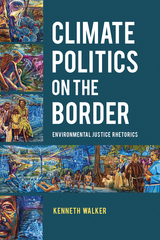 Climate Politics on the Border: Environmental Justice Rhetorics
Kenneth Walker
University of Alabama Press, 2022 Explores the ways climate change and extreme weather are negotiated politically in a border community
As a borderland city with generations of slow violence and extreme weather events like flash flooding and intense heat waves, San Antonio, Texas, speaks directly to global issues in climate politics. In Climate Politics on the Border: Environmental Justice Rhetorics, Kenneth Walker takes a place-based approach to his study of San Antonio to explore how extreme weather events and responses to them shape local places, publics, and politics, with an eye toward a future characterized by severe climate breakdown.
Attending to the local histories and micropolitics of San Antonio, Walker examines the effects of extreme weather events as they are experienced across radically inequitable social categories. These local histories serve as a guide, not just for future climates, which stand to be unprecedented, but for the necessary public and political responses to them. He shows how extreme weather events in the past have reinforced colonial social orders that weaken democratic goals of pluralism and equity. Conversely, he also shows how diverse coalitions have resisted and responded to these forces.
Walker examines the ethics of Latinx and Anglo relations within state-sponsored productions of racial inequity and environmental degradation, the coalitional capacities of environmental activists and second-wave Chicana/o organizations to protect clean water and transform local political representation, the obligations of place-keeping in Latinx urban design and ecological restoration, and the need to foster pluriversal worlds in city-level climate action and adaptation plans. Collectively these chapters rethink tropes of adaptation, resilience, and coalition as rhetorical and ecological capacities for public and political responses to extractivism.
Based on years of archival work and fieldwork, Climate Politics on the Border demonstrates vividly why ecological and anticolonial approaches to rhetoric are essential for grappling with climate politics. Overall, this is a timely study of how environmental degradation, pollution, and climate change are disputed and negotiated at the local political level in a borderland community.
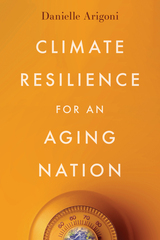 Climate Resilience for an Aging Nation
Danielle Arigoni
Island Press, 2023 Climate change is having an immediate and sometimes life-threatening impact, especially for older adults – generally speaking, people 65 or older. Older adults often face mobility, cognitive, and resource challenges, which contribute to a disproportionate number of deaths in the face of major disasters. But some challenges are less visible. Consider the grandparent who no longer can stand and wait at the bus stop because of the heat, or the retiree who lives in a home with black mold due to chronic flooding that she can’t afford to remediate or leave because of her limited fixed income.
Our population is aging—by 2034, the US will have more people over 65 than under 18. Despite the evidence that climate change is severely impacting older adults, and the reality that communities will be confronted with more frequent and more severe disasters, we’re not prepared to address the needs of older adults and other vulnerable populations in the face of a changing climate.
In Climate Resilience for an Aging Nation, community resilience and housing expert Danielle Arigoni argues that we cannot achieve true resilience until communities adopt interventions that work to meet the needs of their oldest residents. She explains that when we plan for those most impacted by climate, and for those with the greatest obstacles to opportunity and well-being, we improve conditions for all.
Arigoni explores how to integrate age-friendly resilience into community planning and disaster preparedness efforts through new planning approaches—including an age-friendly process, and a planning framework dedicated to inclusive disaster recovery—to create communities that serve the needs of older adults better, not only during disasters but for all the days in between. Examples are woven throughout the book, including case studies of age-friendly resilience in action from New York State; Portland, Oregon and Multnomah County; and New Orleans.
Climate Resilience for an Aging Nation will help professionals and concerned citizens understand how to best plan for both the aging of our population and the climate changes underway so that we can create safer, more livable communities for all.
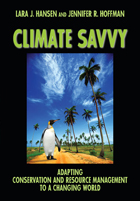 Climate Savvy: Adapting Conservation and Resource Management to a Changing World
Lara J. Hansen and Jennifer R. Hoffman
Island Press, 2010 Climate change demands a change in how we envision, prioritize, and implement conservation and management of natural resources. Addressing threats posed by climate change cannot be simply an afterthought or an addendum, but must be integrated into the very framework of how we conceive of and conduct conservation and management.
In Climate Savvy, climate change experts Lara Hansen and Jennifer Hoffman offer 18 chapters that consider the implications of climate change for key resource management issues of our time—invasive species, corridors and connectivity, ecological restoration, pollution, and many others. How will strategies need to change to facilitate adaptation to a new climate regime? What steps can we take to promote resilience?
Based on collaboration with a wide range of scientists, conservation leaders, and practitioners, the authors present general ideas as well as practical steps and strategies that can help cope with this new reality.
While climate change poses real threats, it also provides a chance for creative new thinking. Climate Savvy offers a wide-ranging exploration of how scientists, managers, and policymakers can use the challenge of climate change as an opportunity to build a more holistic and effective philosophy that embraces the inherent uncertainty and variability of the natural world to work toward a more robust future.
 Climate Security and the Military: Concepts, Strategies and Partnerships
Georg Frerks
Leiden University Press, 2024 This book, Climate Security and the Military: Concepts, Strategies and Partnerships, reviews the climate Security Nexus from the military angle and proposes the design of climate security strategies and how they can contribute to adaptation to and mitigation of the related challenges. Part 1 reviews the understanding of the Climate Security Nexus. Subsequently, Part 2 assesses the potential design of climate security strategies. In Part 3, adaptation to climate change by the military is reviewed. Finally, part 4 discusses the potential contribution of the military to climate mitigation from the angle of operations on land, at sea and in the air, and of solar geoengineering. By thus analysing the impact climate has on security around the world and military operations, this book provides a unique and much needed view on the mutual influence of climate security and the military and provides suggestions to adapt to and mitigate the resulting challenges.
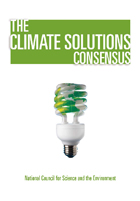 The Climate Solutions Consensus: What We Know and What To Do About It
National Council for Science and the Environment
Island Press, 2010 In 2007, the Intergovernmental Panel on Climate Change shared the 2007 Nobel Peace Prize (with former Vice President Al Gore) for its reporting on the human causes of climate change. In 2008, the National Council for Science and the Environment reported that the acceleration of climate change is already faster than the IPCC projected only a year earlier. How we deal with the rapid environmental changes, and the human forces that are driving these changes, will be among the defining issues of our generation.
Climate Solutions Consensus presents an agenda for America. It is the first major consensus statement by the nation’s leading scientists, and it provides specific recommendations for federal policies, for state and local governments, for businesses, and for colleges and universities that are preparing future generations who will be dealing with a radically changed climate. The book draws upon the recommendations developed by more than 1200 scientists, educators and decision makers who participated in the National Council for Science and the Environment’s 8th National Conference on Science, Policy and the Environment.
After presenting a lucid narrative of the science behind climate change and its solutions, Climate Solutions Consensus presents 35 practical, results-oriented approaches for minimizing climate change and its impacts. It clearly spells out options for technological, societal, and policy actions. And it deals head-on with controversial topics, including nuclear energy, ocean fertilization and atmospheric geo-engineering.
One of the book’s key conclusions is that climate solutions are about much more than energy sources. They involve re-examining everything people do with an eye toward minimizing climate impacts. This includes our eating habits, consumption patterns, transportation, building and housing, forestry, land use, education, and more. According to these scientists, the time to act is now. With clarity and urgency, they tell us exactly what needs to be done to start reversing the driving factors behind climate change, minimizing their consequences, and adapting to what is beyond our power to stop.
Climate Strategy: Between Ambition and Realism
The Netherlands Scientific Council for Government Policy (WRR)
Amsterdam University Press, 2007
According to the UN-sponsored Intergovernmental Panel on Climate Change, current global changes in climate are 90-95% likely to have been caused, at least in part, by human activity. This challenging analysis of the current global climate struggle suggests three courses of necessary action for solving the climate problem and demonstrates their viability: adaptation to the changed climate, selection of worldwide strategies for mitigation until 2050, and an internationally coordinated effort to implement these policies. A highly readable and accessible addition to climate strategy and policy, this volume provides a refreshingly innovative look at current global climate initiatives.
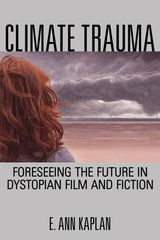 Climate Trauma: Foreseeing the Future in Dystopian Film and Fiction
Kaplan, E. Ann
Rutgers University Press, 2015 Each month brings new scientific findings that demonstrate the ways in which human activities, from resource extraction to carbon emissions, are doing unprecedented, perhaps irreparable damage to our world. As we hear these climate change reports and their predictions for the future of Earth, many of us feel a sickening sense of déjà vu, as though we have already seen the sad outcome to this story.
Drawing from recent scholarship that analyzes climate change as a form of “slow violence” that humans are inflicting on the environment, Climate Trauma theorizes that such violence is accompanied by its own psychological condition, what its author terms “Pretraumatic Stress Disorder.” Examining a variety of films that imagine a dystopian future, renowned media scholar E. Ann Kaplan considers how the increasing ubiquity of these works has exacerbated our sense of impending dread. But she also explores ways these films might help us productively engage with our anxieties, giving us a seemingly prophetic glimpse of the terrifying future selves we might still work to avoid becoming.
Examining dystopian classics like Soylent Green alongside more recent examples like The Book of Eli, Climate Trauma also stretches the limits of the genre to include features such as Blindness, The Happening, Take Shelter, and a number of documentaries on climate change. These eclectic texts allow Kaplan to outline the typical blind-spots of the genre, which rarely depicts climate catastrophe from the vantage point of women or minorities. Lucidly synthesizing cutting-edge research in media studies, psychoanalytic theory, and environmental science, Climate Trauma provides us with the tools we need to extract something useful from our nightmares of a catastrophic future.
 The Climate Trial: Law and Justice on a Melting Planet
Noah Walker-Crawford
Duke University Press, 2026 Saúl Luciano Lliuya guides tours in the mountains and his family grow corn, wheat, barley, and potatoes on their farm in Huaraz, Peru, a community of more than 100,000 people in the Andes near Palcacocha, a glacial lake. Palcacocha, however, is growing, as is the major flood risk to Huaraz. Climate change through the emission of greenhouse gases continues to melt the Peruvian glaciers—greenhouse gases that come from corporate polluters not just in Peru, but across the industrialized world. So, Luciano Lliuya decided to sue. Although the German energy company RWE has never operated in Peru, Luciano Lliuya sought to hold the company, which uses coal power generation, liable for damages in a groundbreaking case that, despite being dismissed, established that major emitters can be held liable for climate harms. In The Climate Trial, anthropologist Noah Walker-Crawford draws on years of personal involvement with the lawsuit and extensive fieldwork in Peru and Germany to follow the people, legal strategies, scientific arguments, and political tensions that have shaped the trial. More than a courtroom drama, The Climate Trial is a deeply human story about moral responsibility in a changing world and what it means to be a “good neighbor” while living thousands of miles away.
Climates of Hunger: Mankind and the World's Changing Weather
Reid A. Bryson
University of Wisconsin Press, 1979 In recent years, world climate changes have drawn more attention than at any other time in history. What we once called "crazy weather," just a few years ago, is now beginning to be seen as a part of a logical and, in part, predictable pattern, an awesome natural force that we must deal with if man is to avoid disaster of unprecedented proportions.
Climates of Hunger is a book of paramount importance for our time. It will be essential reading not only for professionals in the field—including agricultural meteorologists, political scientists, geographers, sociologists, and business counselors—but for all who are concerned in any way with environmental trends, world and domestic food supplies, and their effects on human institutions.
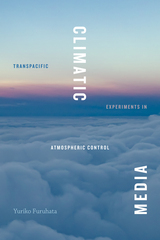 Climatic Media: Transpacific Experiments in Atmospheric Control
Yuriko Furuhata
Duke University Press, 2022 In Climatic Media, Yuriko Furuhata traces climate engineering from the early twentieth century to the present, emphasizing the legacies of Japan’s empire building and its Cold War alliance with the United States. Furuhata boldly expands the scope of media studies to consider technologies that chemically “condition” Earth’s atmosphere and socially “condition” the conduct of people, focusing on the attempts to monitor and modify indoor and outdoor atmospheres by Japanese scientists, technicians, architects, and artists in conjunction with their American counterparts. She charts the geopolitical contexts of what she calls climatic media by examining a range of technologies such as cloud seeding and artificial snowflakes, digital computing used for weather forecasting and weather control, cybernetics for urban planning and policing, Nakaya Fujiko’s fog sculpture, and the architectural experiments of Tange Lab and the Metabolists, who sought to design climate-controlled capsule housing and domed cities. Furuhata’s transpacific analysis offers a novel take on the elemental conditions of media and climate change.
The Climb from Salt Lick: A Memoir of Appalachia
Nancy L. Abrams
West Virginia University Press, 2018 In the mid-1970s, Nancy L. Abrams, a young photojournalist from the Midwest, plunges into life as a small-town reporter in West Virginia. She befriends the hippies on the commune one mountaintop over, rents a cabin in beautiful Salt Lick Valley, and falls in love with a local boy, wrestling to balance the demands of a job and a personal life. She learns how to survive in Appalachia—how to heat with coal and wood, how to chop kindling, plant a garden, and preserve produce.
The Climb from Salt Lick is the remarkable memoir of an outsider coming into adulthood. It is the story of a unique place and its people from the perspective of a woman who documents its burdens and its beauty, using words and pictures to tell the rich stories of those around her.
 Climber’s Guide to Devil’s Lake
Sven Olof Swartling
University of Wisconsin Press, 2008 Devil’s Lake State Park in Wisconsin is the most popular rock-climbing area in the Midwest. It features spectacular cliffs and other rock formations where the Ice Age glacier's terminal moraine meets an ancient landscape of rock. This third edition of the popular Climber’s Guide to Devil’s Lake has been thoroughly updated for twenty-first-century climbers and hikers and includes information for use with GPS receivers. It provides information for climbers of all abilities and preferences, offering precise directions to help them navigate and climb within the park. Features include: •an updated introduction by George J. Pokorny and new photographs by Eric Andre •a summary of the geologic and natural history of the Baraboo hills by Patricia K. Armstrong •locations and updated descriptions of nearly 1,800 climbs •landmark photographs from most major climbing areas •GPS waypoints, map coordinates, altimeter readings, and approach information •detailed diagrams locating climbing routes at most major climbing areas •6 new diagrams, 5 new climbing areas, and 120 new routes
Climbing
Hil Malatino
Duke University Press, 2026
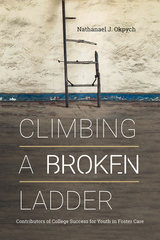 Climbing a Broken Ladder: Contributors of College Success for Youth in Foster Care
Nathanael J. Okpych
Rutgers University Press, 2021 Although foster youth have college aspirations similar to their peers, fewer than one in ten ultimately complete a two-year or four-year college degree. What are the major factors that influence their chances of succeeding? Climbing a Broken Ladder advances our knowledge of what can be done to improve college outcomes for a student group that has largely remained invisible in higher education. Drawing on data from one of the most extensive studies of young people in foster care, Nathanael J. Okpych examines a wide range of factors that contribute to the chances that foster youth enroll in college, persist in college, and ultimately complete a degree. Okpych also investigates how early trauma affects later college outcomes, as well as the impact of a significant child welfare policy that extends the age limit of foster care. The book concludes with data-driven and concrete recommendations for policy and practice to get more foster youth into and through college.
Climbing a Burning Rope: Poems
John Paul Davis
University of Pittsburgh Press, 2024 In Climbing a Burning Rope, John Paul Davis focuses his peculiar imagination, philosophical lyricism, and misfit spiritual outlook on life in the hypercapitalist twenty-first century where the inscrutable logic of algorithms haunts our constantly connected selves. Celebrating the weird and wild, lamenting wounds and weariness, Davis’s poems carve out a space in which we can reclaim what is sacred and be reminded to keep something of ourselves for ourselves.
 Climbing the Divide
Walt McDonald
University of Notre Dame Press, 2003 “For years, I’ve wondered in amazement how Walt McDonald does what he does, poem after poem, book after book. He sings like no one else. In Climbing the Divide, McDonald has made his strongest collection of poems yet.” —David Citino, author of The News and Other Poems
“Climbing the Divide must have been written with a pen Walt McDonald dipped into his heart. Crisscrossing generations, poems detail watching a grandfather with knuckles the size of walnuts carve a grizzly bear out of oak, taking car keys away from a father ‘who drove tanks for Patton’ and thinking about nights in the jungle of Vietnam while pushing a granddaughter in a swing because her father is training overseas for Desert Storm. Binding us to his Texas world in sensual detail about men with big-boned fists who inhabit a land where the moon pockmarks the sky, Walt McDonald refuses to let moments of communion be swallowed by ‘war on every channel.’ His poems stay lodged in the heart to remind us why we need to celebrate, even in a world that threatens to drown out song.” —Vivian Shipley, author of When There Is No Shore
“I spent one whole amazing fall morning engrossed in this book. What impresses me most is the love and music and startling intelligence with which, for all of us, Walt McDonald charts the territory beyond mid-life.” —Jeanne Murray Walker
The poems in Climbing the Divide celebrate with praise and amazement the wonders and risks of wilderness and family, of friends before and after the war. The boy in these poems grows up during World War II, feisty in spite of losses and the harsh, hardscrabble land where he lives. Surrounded by heroes, he learns ranching and faith from parents, extended family, and neighbors. In pilot training and war and back home with friends and memories of friends missing in action, he finds delight with his wife, who makes “magical hammocks at bedtime” for their children. Despite heartache and rage, they discover more hope and joy than they thought possible while growing older—jogging at 65 in winter, hiking grizzly country with bells, and “climbing the divide,” knowing they’re nearer each day to “the dark, hollow halo of space.”
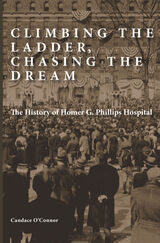 Climbing the Ladder, Chasing the Dream: The History of Homer G. Phillips Hospital
Candace O’Connor
University of Missouri Press, 2022 Nothing about Homer G. Phillips Hospital came easily. Built to serve St. Louis’s rapidly expanding African-American population, the grand new hospital opened its doors in 1937, toward the end of the Great Depression. “Homer G.,” as many called it, joined a burgeoning group of black hospitals amid a national period of institutional segregation and strong racial prejudice nationwide.
When the beautiful, up-to-date hospital opened, it attracted more black residents than any other such program in the United States. Patients also flocked to the hospital, as did nursing students who found there excellent training, ready employment, and a boost into the middle class. For decades, the hospital thrived; by the 1950s, three-quarters of African-American babies in St. Louis were born at Homer G.
But the 1960s and 1970s brought less need for all-black hospitals, as faculty, residents, and patients were increasingly welcome in the many newly integrated institutions. Ever-tightening city budgets meant less money for the hospital, and in 1979, despite protests from the African-American community, HGPH closed. Years later, the venerated, long-vacant building came to life again as the Homer G. Phillips Senior Living Community.
Candace O’Connor draws upon contemporary newspaper articles, institutional records, and dozens of interviews with former staff members to create the first, full history of the Homer G. Phillips Hospital. She also brings new facts and insights into the life and mysterious murder (still an unsolved case) of the hospital’s namesake, a pioneering Black attorney and civil rights activist who led the effort to build the sorely needed medical facility in the Ville neighborhood.
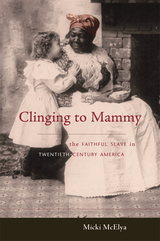 Clinging to Mammy: The Faithful Slave in Twentieth-Century America
Micki McElya
Harvard University Press, 2007 When Aunt Jemima beamed at Americans from the pancake mix box on grocery shelves, many felt reassured by her broad smile that she and her product were dependable. She was everyone's mammy, the faithful slave who was content to cook and care for whites, no matter how grueling the labor, because she loved them. This far-reaching image of the nurturing black mother exercises a tenacious hold on the American imagination.
Micki McElya examines why we cling to mammy. She argues that the figure of the loyal slave has played a powerful role in modern American politics and culture. Loving, hating, pitying, or pining for mammy became a way for Americans to make sense of shifting economic, social, and racial realities. Assertions of black people's contentment with servitude alleviated white fears while reinforcing racial hierarchy. African American resistance to this notion was varied but often placed new constraints on black women.
McElya's stories of faithful slaves expose the power and reach of the myth, not only in popular advertising, films, and literature about the South, but also in national monument proposals, child custody cases, white women's minstrelsy, New Negro activism, anti-lynching campaigns, and the civil rights movement. The color line and the vision of interracial motherly affection that helped maintain it have persisted into the twenty-first century. If we are to reckon with the continuing legacy of slavery in the United States, McElya argues, we must confront the depths of our desire for mammy and recognize its full racial implications.
Clinical Approach to Ocular Motility: Characteristics and Orthoptic Management of Strabismus
Ida Iacobucci
Michigan Publishing, 2014 In this, the 2ndedition of her original text on the theory, science, and treatment of common and uncommon disorders of the oculomotor system, Professor Ida Lucy Iacobucci, Certified Orthoptist, presents updated material on the many advances made in the field since her original text was first published in 1980. This book is based on her lectures to Orthoptic and Ophthalmology students and it encompasses over 50 years of clinical and teaching experience.
Prof. Iacobucci describes a wide range of clinical tests to evaluate multiple categories of strabismus and provides a wealth of detail on the characteristics, management, and orthoptic treatment options for each. The book is organized for quick and easy reference and is a valuable addition to required texts for students.
Clinical Cases for Pediatric Medical Students and Residents
Ruth Worthington
Michigan State University Press, 2017 The thirty-six cases presented in this volume are the pedagogic result of the author’s years working in a pediatrics medical setting. These cases include scenarios that aim to help students improve such skills as evaluating clinical presentations, formulating differential diagnoses, determining appropriate work-ups and interpreting their results, and producing working diagnoses and subsequent treatment plans. The text also examines appropriate responses to emergency situations. The cases come in a variety of formats to give a well-rounded tour of myriad scenarios. Suggested answers provided at the end of each case allow for critical assessment without immediate access to work-up results. This text is essential for those looking to build the critical skills necessary to succeed in the pediatric field.
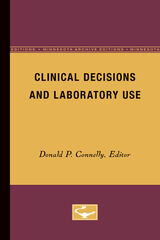 Clinical Decisions and Laboratory Use
Donald Connelly
University of Minnesota Press, 1982
Clinical Decisions and Laboratory Use was first published in 1982.As the national expenditure for health care continues to mount, pressures from within and outside of medicine are encouraging more effective and economical use of medical resources. Though much of the current attention is focused on a few high-cost, technologically dramatic procedures, the rapidly growing use of laboratory tests makes up a substantial portion of heal care costs. Evidence suggests that a significant amount of laboratory use is ineffective and unnecessary and could be eliminated with no harmful effects on the quality of care.This book, which is based on the Conference on Clinical Decision Making and Laboratory Use held at the University of Minnesota in 1980, focuses on the problems faced by health care professionals as they attempt to control laboratory costs and suggests ways of making rational and effective decisions. The 32 chapters deal with the following topics: Medical Decisions, Technology, and Social Needs; The Process of Clinical Decision Making; Clinical Decisions and the Clinical Laboratory; Medical Education and Effective Laboratory Use; Tools for Supporting the Decision-Making Process; and Research Initiatives Toward Effective Decision Making and Laboratory Use. Physicians, clinic and hospital administrators, laboratory directors, and health care planners will find this book a useful source of information in establishing their own procedures for clinical decision making.
The Clinical Diary of Sándor Ferenczi
Sándor Ferenczi
Harvard University Press, 1988 In the half-century since his death, the Hungarian analyst Sándor Ferenczi has amassed an influential following within the psychoanalytic community. During his lifetime Ferenczi, a respected associate and intimate of Freud, unleashed widely disputed ideas that influenced greatly the evolution of modern psychoanalytic technique and practice. In a sequence of short, condensed entries, Sándor Ferenczi’s Diary records self-critical reflections on conventional theory—as well as criticisms of Ferenczi’s own experiments with technique—and his obstinate struggle to divest himself and psychoanalysis of professional hypocrisy. From these pages emerges a hitherto unheard voice, speaking to his heirs with startling candor and forceful originality—a voice that still resonates in the continuing debates over the nature of the relationship in psychoanalytic practice.
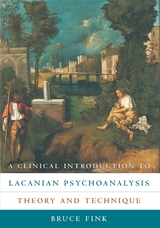 A Clinical Introduction to Lacanian Psychoanalysis: Theory and Technique
Bruce Fink
Harvard University Press, 1997 "The goal of my teaching has always been, and remains, to train analysts."
--Jacques Lacan, Seminar XI, 209
Arguably the most profound psychoanalytic thinker since Freud, and deeply influential in many fields, Jacques Lacan often seems opaque to those he most wanted to reach. These are the readers Bruce Fink addresses in this clear and practical account of Lacan's highly original approach to therapy. Written by a clinician for clinicians, Fink's Introduction is an invaluable guide to Lacanian psychoanalysis, how it's done, and how it differs from other forms of therapy. While elucidating many of Lacan's theoretical notions, the book does so from the perspective of the practitioner faced with the pressing questions of diagnosis, what therapeutic stance to adopt, how to involve the patient, and how to bring about change.
Fink provides a comprehensive overview of Lacanian analysis, explaining the analyst's aims and interventions at each point in the treatment. He uses four case studies to elucidate Lacan's unique structural approach to diagnosis. These cases, taking up both theoretical and clinical issues in Lacan's views of psychosis, perversion, and neurosis, highlight the very different approaches to treatment that different situations demand.
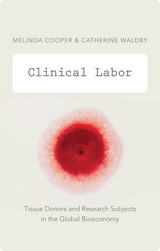 Clinical Labor: Tissue Donors and Research Subjects in the Global Bioeconomy
Melinda Cooper and Catherine Waldby
Duke University Press, 2014 Forms of embodied labor, such as surrogacy and participation in clinical trials, are central to biomedical innovation, but they are rarely considered as labor. Melinda Cooper and Catherine Waldby take on that project, analyzing what they call "clinical labor," and asking what such an analysis might indicate about the organization of the bioeconomy and the broader organization of labor and value today. At the same time, they reflect on the challenges that clinical labor might pose to some of the founding assumptions of classical, Marxist, and post-Fordist theories of labor.
Cooper and Waldby examine the rapidly expanding transnational labor markets surrounding assisted reproduction and experimental drug trials. As they discuss, the pharmaceutical industry demands ever greater numbers of trial subjects to meet its innovation imperatives. The assisted reproductive market grows as more and more households look to third-party providers for fertility services and sectors of the biomedical industry seek reproductive tissues rich in stem cells. Cooper and Waldby trace the historical conditions, political economy, and contemporary trajectory of clinical labor. Ultimately, they reveal clinical labor to be emblematic of labor in twenty-first-century neoliberal economies.
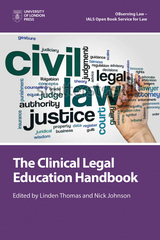 The Clinical Legal Education Handbook
Edited by Linden Thomas and Nicholas Johnson
University of London Press, 2020 The Clinical Legal Education Handbook is a practical resource and guide for those engaged in the design and delivery of clinical legal education programs at university law schools. The Handbook offers direction on how to establish and run student law clinics, sets out guidance on both the pedagogical and regulatory considerations involved in the delivery of clinical programs, and introduces the existing body of research and scholarship on Clinical Legal Education (CLE).
CLE has become an increasingly popular method of legal education in recent years. By the end of 2013 at least 70% of all law schools in the United Kingdom were delivering some type of CLE, and 25% of these offered credit-bearing CLE programs. It is almost certain that this number will increase in the years to come with the advent of the forthcoming Solicitors’ Qualifying Examination, which will allow time spent volunteering in a student law clinic to count as “qualifying work experience.” However, despite the popularity of CLE, there is currently very little information available about the best practices for setting up and delivering these programs.
The Handbook seeks to remedy this gap, offering an invaluable resource to staff involved in running law clinics, both as a practical guide to establishing and running their programs and as a teaching resource and recommended text on clinical programs. It will also act as a resource for clinical legal education researchers who wish to engage in regulatory, pedagogic, and legal service delivery research in this area.
 Clinical Trials in Ovarian Cancer
Walsh, Christine S
Rutgers University Press, 2017 When a patient is diagnosed with a gynecological malignancy, she and her doctors must make urgent, high-risk decisions about her course of treatment. In selecting an appropriate plan of care, physicians must weigh the patient’s individual needs, the tumor’s specific characteristics, and the treatment’s potential side effects. Because there is no one-size-fits-all treatment solution, a plethora of clinical trials have been performed on ovarian cancer patients, but clinicians may struggle to keep up with this ever-growing body of research. Collecting and synthesizing research findings from a wide array of medical journal articles and book chapters, Clinical Trials in Ovarian Cancer provides physicians with an invaluable resource. Gynecologic oncologist Christine S. Walsh systematically outlines each of the seminal Phase III trials that have shaped the treatment of ovarian cancers, detailing the rationale for the trial, the patient population studied, treatment delivery methods, efficacy, toxicity, and trial conclusions. She provides a clear overview of established treatments, as well as still-controversial experimental approaches. The first book to organize this cutting-edge research into an easy-to-use reference, Clinical Trials in Ovarian Cancer should help medical personnel at all levels provide their patients with the highest standard of care.
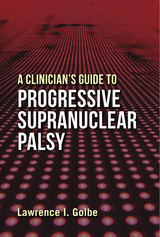 A Clinician's Guide to Progressive Supranuclear Palsy
Golbe, Lawrence I
Rutgers University Press, 2019 This brief, clinically-focused volume is informed by Lawrence I. Golbe’s three decades of research and tertiary clinical care in progressive supranuclear palsy, a complex disorder with rapidly changing diagnostic and therapeutic approaches. It is an ideal source for the general neurologist seeking a refresher and the primary care provider, neurological nurse, or physical, occupational or speech therapist who must address their patients’ specialized needs.
A Clinician’s Guide to Progressive Supranuclear Palsy emphasizes early diagnostic signs, medication options, non-pharmacologic management and palliative care. It offers a quick overview of the complications of PSP most likely to prompt an ER visit; a widening spectrum of PSP variants; and ample description of the genetics, epidemiology, natural history, pathology, molecular biology and neurochemistry of PSP. The PSP Rating Scale used in the book is a convenient tool for clinicians in routine practice and the leading PSP clinical measure world-wide. Golbe provides a practical and useful guidebook to help all clinicians learn and battle this complex disorder.
Clint Eastwood, Actor and Director: New Perspectives
Leonard Engel
University of Utah Press, 2007 In his recent films — Unforgiven, Mystic River, and Million Dollar Baby — Clint Eastwood has revealed himself as a greater figure than moviegoers had imagined him to be. While he has been an exceptionally successful actor, creating iconic characters in two genres, Western and detective films, as a director, his recent films have reached a surprising power, depth, and maturity.
The contributors to this volume revisit and examine his career as an actor and director, and are part of a growing critical evaluation of Eastwood's films. A common thread, however, is their respect for his cinematic storytelling. They examine how he put his individual stamp on particular genres, while extending and enriching our understanding of his achievements.
The Clinton Riddle: Perspectives on the Forty-second President
Todd G. Shields
University of Arkansas Press, 2004 In 2002 a distinguished interdisciplinary group of scholars gathered at the Diane D. Blair Center of Southern Politics and Society at the University of Arkansas to provide a critical evaluation of the Clinton-Gore administration. Their groundbreaking assessment of the most controversial president in modern times treats such crucial topics as race, women, and minorities; the character issue; foreign policy; and the media. This book provides a unique vantage point on the “Clinton riddle” that all future studies will need to consider.
 The Clinton Scandal and the Future of American Government
Mark J. Rozell and Clyde Wilcox, Editors
Georgetown University Press, 2000 The Clinton scandal consumed the better part of a year of American public life, bitterly dividing the nation and culminating in a constitutional crisis. In this book, thoughtful, nonpartisan essays provide an insightful and lasting analysis of one of the major political events of our time. Here leading scholars explore the long-reaching constitutional and political implications of the scandal: how it will affect the presidency, the law, and the political process. A first group of chapters considers effects of the scandal on institutions: the presidency, Congress, the courts, the independent counsel statute, executive privilege, and the impeachment process itself. A second section addresses political factors: public opinion, the media, and presidential character and personality. A concluding essay broadly examines the implications of the scandal for governance. These far-reaching essays address such issues as risks posed to Congressional political careers, the prospect of future presidents being subject to civil suits, the pros and cons of Kenneth Starr's investigation, the role of the media in breaking and then shaping the story, and ways of reforming the system to handle the unacceptable private behavior of future presidents. A provocative book for readers concerned with how our government copes with such a challenge, and an essential reader for courses on the presidency or American government, this collection will stand the tests of both time and rigorous analysis.
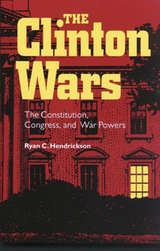 The Clinton Wars: The Constitution, Congress, and War Powers
Ryan C. Hendrickson
Vanderbilt University Press, 2002 Today the United States is fighting a "war" against terrorism, a military action whose definition will be a matter of controversy, particularly, if history is any guide, between Congress and the president. Throughout its history, the United States has grappled with the constitutional tension built into the conduct of its foreign affairs and the interpretation of the power to make war and use force abroad. Since the Cold War's end, the United States has had to navigate through a period of strategic ambiguity, where American national security interests are much less certain. Ryan Hendrickson examines the behavior of the Clinton administration and Congress in dealing with the range of American military operations that occurred during the Clinton presidency. He uses a case-study approach, laying out the foreign background and domestic political controversies in separate chapters on Somalia, Haiti, Bosnia, Kosovo, and Iraq. Of special interest after the World Trade Center attacks is the chapter "Terrorism: Usama Bin Laden." The author analyzes a number of factors that influence the domestic decision-making process. We see the president relying on congressional consultation and approval during periods of political or personal weakness, and, conversely, in better times we see a president with a freer hand. Also influential is the ability of the public to comprehend and support the reasons for a particular action, with troops in Bosnia requiring more explanation than cruise missiles over Baghdad. Consideration is given to the relevance and effectiveness of the War Powers Resolution of 1973, a Watergate-era attempt by Congress to restore what it perceived to be its legitimate constitutional role in the decision to use force abroad.
The Clintons of Arkansas: An Introduction by Those Who Know Them Best
Ernest Dumas
University of Arkansas Press, 1993 This collection of anecdotal stories by the people who know them best introduces Bill and Hillary to the nation as only friends can. The essays collectively place the Clintons into proper social, historical, and geographical context for anyone who wants to know the former First Family on a more personal level.
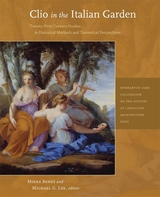 Clio in the Italian Garden: Twenty-First–Century Studies in Historical Methods and Theoretical Perspectives
Mirka Beneš and Michael G. Lee
Harvard University Press, 2011 Italian gardens have received more attention from historians than perhaps any other garden tradition. This volume presents eight richly illustrated essays by established and emerging scholars that suggest striking new directions for future research.
Mirka Beneš and Raffaella Fabiani Giannetto examine the long historical development and disciplinary diversity of Italian garden studies. Marcello Fagiolo and Vincenzo Cazzato advance a new theory of villa systems that enlarges the geographical frame of the field. Mauro Ambrosoli highlights the contributions of anonymous laborers and gardeners in the creation of the countryside, while Lionella Scazzosi shows how this broader view of agency informs decisions by policymakers regarding the restoration and maintenance of historical gardens. Antonella Pietrogrande and Denis Ribouillault offer new interpretations of some of the most famous Renaissance sites through analyses of cultural imagination and modes of perception.
This volume exemplifies the broad transformations, both quantitative and methodological, taking place in the study and practice of garden design, and offers a reflective meditation on the vitality of one of the oldest branches of garden and landscape history.
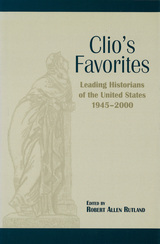 Clio's Favorites: Leading Historians of the United States, 1945-2000
Robert Allen Rutland
University of Missouri Press, 2000
Although historians talk about each other's work routinely, they have been reluctant to record their thoughts about the leading practitioners of U.S. history. Robert Allen Rutland attempts to remedy this state of things with this collection named for Clio, the Greek muse vested with the inspirations of history. The volume offers a glimpse of the lives and work of historians who must be considered among the most remarkable from the last half of the twentieth century.
The roll call of excellence for Clio's Favorites was established after Rutland informally polled some twenty-five historians, asking them to name the outstanding workers in the field of U.S. history since the end of World War II. Among the criteria for selection were: quality (not volume) of the historian's work; influence in the field of study; importance of his or her graduate and undergraduate teaching; and the figure's public persona as reflected by awards, honors, and involvement in public service. The historians profiled in Clio's Favorites, most of whom broke new ground, met and surpassed these standards. The list could have gone on, but Rutland believes these twelve represent the cream of the crop. They are: Bernard Bailyn, Merle Curti, David Herbert Donald, John Hope Franklin, Richard Hofstadter, Howard Roberts Lamar, Gerda Lerner, Arthur S. Link, Edmund S. Morgan, David M. Potter, Arthur M. Schlesinger, Jr., and C. Vann Woodward.
Just as the subject of each essay in Clio's Favorites is a remarkably distinguished historian, the authors of these twelve essays are accomplished historians themselves. Good historical writing is never outdated, Rutland argues. The extensive work of the scholars profiled here has endured and will continue to endure. Likewise, the writing in Clio's Favorites, by twelve expert historians, will survive. This book will be a lasting record of the contributions made by the best U.S. historians practicing their craft over the last fifty years.
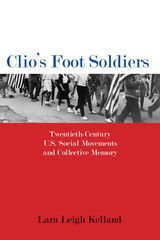 Clio's Foot Soldiers: Twentieth-Century U.S. Social Movements and Collective Memory
Lara Leigh Kelland
University of Massachusetts Press, 2018 Collective memories are key to social movements. Activists draw on a shared history to build identity, create movement cohesion, and focus political purpose. But what happens when marginalized communities do not find their history in dominant narratives? How do they create a useable past to bind their political communities together and challenge their exclusion?
In Clio's Foot Soldiers, Lara Leigh Kelland investigates these questions by examining 1960s and 1970s social movements comprised of historically marginalized peoples: Civil Rights, Black Power, Women's and Gay Liberation, and American Indian. These movements sought ownership over their narratives to create historical knowledge reflective of their particular experiences. To accomplish their goals, activists generated new forms of adult education, published movement newspapers, and pursued campus activism and speeches, public history efforts and community organizations. Through alternative means, marginalized communities developed their own historical discourses to mobilize members, define movement goals, and become culturally sovereign. In so doing, they provided a basis for achieving political liberation and changed the landscape of liberal cultural institutions.
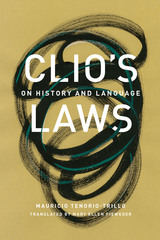 Clio's Laws: On History and Language
By Mauricio Tenorio-Trillo; translated by Mary Ellen Fieweger
University of Texas Press, 2019 Offering a unique perspective on the very notions and practices of storytelling, history, memory, and language, Clio’s Laws collects ten essays (some new and some previously published in Spanish) by a revered voice in global history. Taking its title from the Greek muse of history, this opus considers issues related to the historian’s craft, including nationalism and identity, and draws on Tenorio-Trillo’s own lifetime of experiences as a historian with deep roots in both Mexico and the United States. By turns deeply ironic, provocative, and experimental, and covering topics both lowbrow and highbrow, the essays form a dialogue with Clio about idiosyncratic yet profound matters. Tenorio-Trillo presents his own version of an ars historica (what history is, why we write it, and how we abuse it) alongside a very personal essay on the relationship between poetry and history. Other selections include an exploration of the effects of a historian’s autobiography, a critique of history’s celebratory obsession, and a guide to reading history in an era of internet searches and too many books. A self-described exile, Tenorio-Trillo has produced a singular tour of the historical imagination and its universal traits.
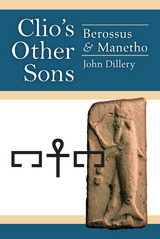 Clio's Other Sons: Berossus and Manetho
John Dillery
University of Michigan Press, 2015 Soon after the death of Alexander the Great, the priest Berossus wrote the first known narrative and comprehensive history of his native Babylon, and the priest Manetho likewise wrote the first such history of his native Egyptian civilization. Nothing like these histories had been produced before in these cultures. Clio’s Other Sons considers why that is: why were these histories written at this point, and for what purposes? Berossus and Manetho operated at the crossings of several political, social, and intellectual worlds. They were members of native elites under the domination of Macedonian overlords; in their writings we can see suggestions that they collaborated in the foreign rule of their lands, but at the same time we see them advocating for their cultures. Their histories were written in Greek and betray active engagement with Greek historical writing, but at the same time these texts are clearly composed from native records, are organized along lines determined by local systems of time-reckoning, and articulate views that are deeply informed by regional scholarly and wisdom traditions. In this volume John Dillery charts the interactions of all these features of these historians. An afterword considers Demetrius, the approximate contemporary of Berossus and Manetho in time, if not in culture. While his associates wrote new histories, Demetrius’ project was a rewriting of an existing text, the Bible. This historiographical “corrective” approach sheds light on the novel historiography of Manetho and Berossus.
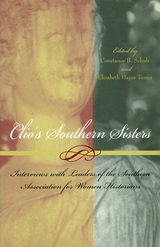 Clio's Southern Sisters: Interviews with Leaders of the Southern Association for Women Historians
Edited by Constance B. Schulz & Elizabeth Hayes Turner
University of Missouri Press, 2004
It is no accident that the Southern Association for Women Historians enjoys the founding date of 1970. After extended and often bitter engagement with entrenched sexism in the decades following World War II, women historians found their voices and crafted a means by which to be heard. The years between 1970 and 1980 represented a decade of optimism for women who sought equality in the workplace. Professional women, professors of history most especially, found hope in organizations such as the SAWH, created to address issues of visibility, legitimacy, and equality in historical associations and in employment.
In Clio’s Southern Sisters, Constance B. Schulz and Elizabeth Hayes Turner collect the stories of the women who helped to found and lead the organization during its first twenty years. These women give evidence, in strong and effective language, of the experiences that shaped their entrée into the profession. They vividly describe the point at which they experienced the shift in their lives and in the lives of those around them that led toward a new day for women in the history profession.
Some found that discrimination followed them like a shadow, and the pain of those days still remains with them. Others sought their graduate education in institutions where women were welcomed and where professors valued their work and encouraged their success. Yet when they entered the job market, they found that some employers flatly refused to consider them because they were women. Lost job opportunities for women were linked in tangled ways to the prevailing image of women as less desirable as colleagues, or as intellectually weaker than their male counterparts.
Through the SAWH, these women were able to make changes from within the profession. They felt an obligation to help the next generation of women scholars. In the midst of a national movement to end sex discrimination through legislation, to increase women’s consciousness-raising efforts, and to acknowledge the economic realities of women in the workforce, these women came together to form an organization that could enable them to have the careers they deserved. This timely volume will be appreciated by all those who reaped the benefits for which these “southern sisters” fought so hard.
Clipped Coins, Abused Words, and Civil Government: John Locke’s Philosophy of Money
George Caffentzis
Pluto Press, 2021 This book situates John Locke’s philosophy of knowledge and his political theory within his engagement in British monetary debates of the 17th and 18th century. Anchored in extensive archival research, George Caffentzis offers the most expansive reading of Locke’s economic thought to date, contextualizing it within the expansion of capitalist accumulation on a world scale and the universality of money as a medium of exchange. Updated with a new introduction by Paul Rekret, a new foreword by Harry Cleaver and new material by the author, Clipped Coins, Abused Words, and Civil Government continues to make a significant intervention in contemporary debates around the history of capitalism, colonialism and philosophy.
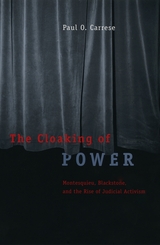 The Cloaking of Power: Montesquieu, Blackstone, and the Rise of Judicial Activism
Paul O. Carrese
University of Chicago Press, 2003 How did the US judiciary become so powerful—powerful enough that state and federal judges once vied to decide a presidential election? What does this prominence mean for the law, constitutionalism, and liberal democracy? In The Cloaking of Power, Paul O. Carrese provides a provocative analysis of the intellectual sources of today’s powerful judiciary, arguing that Montesquieu, in his Spirit of the Laws, first articulated a new conception of the separation of powers and strong but subtle courts. Montesquieu instructed statesmen to “cloak power” by placing judges at the center of politics, while concealing them behind juries and subtle reforms. Tracing this conception through Blackstone, Hamilton, and Tocqueville, Carrese shows how it led to the prominence of judges, courts, and lawyers in America today. But he places the blame for contemporary judicial activism squarely at the feet of Oliver Wendell Holmes Jr. and his jurisprudential revolution, which he believes to be the source of the now-prevalent view that judging is merely political.
To address this crisis, Carrese argues for a rediscovery of an independent judiciary—one that blends prudence and natural law with common law and that observes the moderate jurisprudence of Montesquieu and Blackstone, balancing abstract principles with realistic views of human nature and institutions. He also advocates for a return to the complex constitutionalism of the American founders and Tocqueville and for judges who understand their responsibility to elevate citizens above individualism, instructing them in law and right.
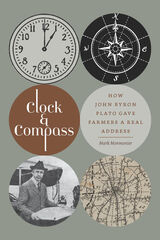 Clock and Compass: How John Byron Plato Gave Farmers a Real Address
Mark Monmonier
University of Iowa Press, 2022 A city guy who aspired to be a farmer, John Byron Plato took a three-month winter course in agriculture at Cornell before starting high school, which he left a year before graduation to fight in the Spanish-American War. He worked as a draftsman, ran a veneers business, patented and manufactured a parking brake for horse-drawn delivery wagons, taught school, and ran a lumber yard. In his early thirties he bought some farmland north of Denver, Colorado, and began raising Guernsey cattle, which he advertised for sale in the local paper. When an interested buyer eager to see his calves couldn’t find his farm, Plato realized that an RFD postal address was only good for delivering mail.
Plato’s solution was a map-and-directory combo that used direction and distance from a local business center to give farmers a real address, just like city dwellers. He patented his invention called the “Clock System” and tried to sell it to the Post Office Department. What follows is a tale of persistence and failure as rural farming declined and technology and capitalism overtook John Byron Plato’s chances at geographic immortality.
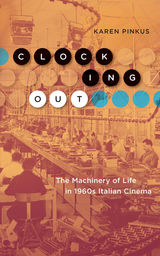 Clocking Out: The Machinery of Life in 1960s Italian Cinema
Karen Pinkus
University of Minnesota Press, 2020 An original reflection on Italy’s postwar boom considers potentials for resistance in today’s neoliberal (dis)order
What can 1960s Italian cinema teach us about how to live and work today? Clocking Out challenges readers to think about labor, cinema, and machines as they are intertwined in complex ways in Italian cinema of the early ’60s. Drawing on critical theory and archival research, this book asks what kinds of fractures we might exploit for living otherwise, for resisting traditional narratives, and for anticapitalism. Italy in the 1960s was a place where the mass-producing factory was the primary mode of understanding what it meant to work, but it was also a time when things might have gone another way. This thinking and living differently appears in the cracks, lapses, or moments of film. Clocking Out is organized into scenes from an obscure 1962 Italian comedy (Renzo e Luciana, from Boccaccio 70). Reconsidering the origins of paradigms such as clocking in and out, “society is a factory,” and the gendered division of labor, Karen Pinkus challenges readers to think through cinema, enabling us to see gaps and breakdowns in the postwar order. She focuses on the Olivetti typewriter company and a little-known film from an Italian anthology movie, thinking with cinema about the power of the Autonomia movement, the refusal to work, and the questions of wages, paternalism, and sexual difference. Alternating microscopic attention to details and zooming outward, Pinkus examines rituals of production, automation, repetition, and fractures in a narrative of labor that begins in the 1960s and extends to the present—the age of the precariat, right-wing resentment, and nostalgia for an order that was probably never was.
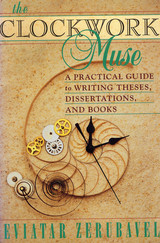 The Clockwork Muse: A Practical Guide to Writing Theses, Dissertations, and Books
Eviatar Zerubavel
Harvard University Press, 1999 For anyone who has blanched at the uphill prospect of finishing a long piece of writing, this book holds out something more practical than hope: it offers a plan. The Clockwork Muse is designed to help prospective authors develop a workable timetable for completing long and often formidable projects.
The idea of dashing off a manuscript in a fit of manic inspiration may be romantic, but it is not particularly practical. Instead, Eviatar Zerubavel, a prolific and successful author, describes how to set up a writing schedule and regular work habits that will take most of the anxiety and procrastination out of long-term writing, and even make it enjoyable. The dreaded ‘writer’s block’ often turns out to be simply a need for a better grasp of the temporal organization of work.
The Clockwork Muse rethinks the writing process in terms of time and organization. It offers writers a simple yet comprehensive framework that considers such variables as when to write, for how long, and how often, while keeping a sense of momentum throughout the entire project. It shows how to set priorities, balance ideals against constraints, and find the ideal time to write. For all those whose writing has languished, waiting for the “right moment,” The Clockwork Muse announces that the moment has arrived.
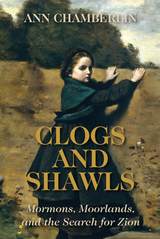 Clogs and Shawls: Mormons, Moorlands, and the Search for Zion
Ann Chamberlin
University of Utah Press, 2019 In this revealing family memoir, best-selling author Ann Chamberlin explores the history of her Mormon grandmother Frances Lyda and her seven sisters who grew up desperately poor in Bradford, Yorkshire, in the early years of the twentieth century. Chamberlin’s narrative follows these eight daughters of Mary Jane Jones and Ralph Robinson Whitaker, a remarkably gifted yet poor and blind piano tuner. Most of the girls were forced by necessity to abandon school at age twelve and find work in terrible conditions at a local factory. When their mother converted to the Church of Jesus Christ of Latter-day Saints in 1901, she became the backbone of the Mormon community in Yorkshire. Her daughters followed their mother into her faith, while navigating their own, sometimes tragic, ways into adulthood, family, and the world beyond industrial England. Though they were exploited and undereducated, the girls maintained a steadfast belief in a brighter future for the Mormon faithful, a mindset that, despite their many differences, forged an unshakable togetherness between them. All gifted and strong individuals in their own right, many of the Whitaker sisters overcame long odds and incredible hardships to carry on and prosper in Salt Lake City.
Chamberlin interviewed her grandmother and six of her surviving great-aunts for Clogs and Shawls, the relatives who had made their way to Mormon Zion. She weaves novelistic passages with their first-person narratives to create a singular work of oral immigrant family history that is both lively and revealing.
 Cloning: A Biologist Reports
Robert Gilmore McKinnell
University of Minnesota Press, 1985
Cloning was first published in 1985. Minnesota Archive Editions uses digital technology to make long-unavailable books once again accessible, and are published unaltered from the original University of Minnesota Press editions.
Cloning has become in recent years a subject of widespread speculation: the word is a source of fear and wonder, the concept a jumping-off point for the fantasies of cartoonists, film producers, and novelists. With this book, cell biologist Robert Gilmore McKinnell provides the first clear scientific explanation of the procedure for general readers.
Cloning is best defined as the asexual reproduction of genetic duplicates. The word clone derives from the Greek word for a twig or a slip, and the first "cloners" were in fact horticulturalists. Early attempts to clone animals culminated in 1952 when biologists reported that they had produced frogs by transplanting genetic material from an embryonic body cell into an egg from which the nucleus had been removed.
In this account, McKinnell traces the historical background of cloning and describes in detail the modern procedure used in the cloning of frogs—the highest animal thus far cloned. He emphasizes that the purpose of cloning is not to produce numerous frogs—or people—but rather to serve as a tool in biological research—to achieve greater understanding of cancer and aging, immunobiology and the differentiation of cells.
McKinnell also deals with questions about potential mammalian clones and examines the social, ethical, and biological problems we face in our considerations about human cloning. He concludes that human clones are not necessary for research purposes and that the diversity achieved with sexual reproduction is far more desirable than the sameness of cloned creatures.
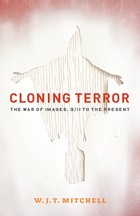 Cloning Terror: The War of Images, 9/11 to the Present
W. J. T. Mitchell
University of Chicago Press, 2010 The phrase “War on Terror” has quietly been retired from official usage, but it persists in the American psyche, and our understanding of it is hardly complete. Nor will it be, W. J. T Mitchell argues, without a grasp of the images that it spawned, and that spawned it. Exploring the role of verbal and visual images in the War on Terror, Mitchell finds a conflict whose shaky metaphoric and imaginary conception has created its own reality. At the same time, Mitchell locates in the concept of clones and cloning an anxiety about new forms of image-making that has amplified the political effects of the War on Terror. Cloning and terror, he argues, share an uncanny structural resemblance, shuttling back and forth between imaginary and real, metaphoric and literal manifestations. In Mitchell’s startling analysis, cloning terror emerges as the inevitable metaphor for the way in which the War on Terror has not only helped recruit more fighters to the jihadist cause but undermined the American constitution with “faith-based” foreign and domestic policies. Bringing together the hooded prisoners of Abu Ghraib with the cloned stormtroopers of the Star Wars saga, Mitchell draws attention to the figures of faceless anonymity that stalk the ever-shifting and unlocatable “fronts” of the War on Terror. A striking new investigation of the role of images from our foremost scholar of iconology, Cloning Terror will expand our understanding of the visual legacy of a new kind of war and reframe our understanding of contemporary biopower and biopolitics.
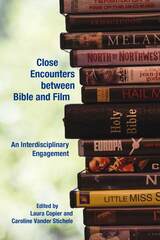 Close Encounters between Bible and Film: An Interdisciplinary Engagement
Laura Copier
SBL Press, 2016 Explore new routes into the burgeoning field of biblical literature and film theory
The present collection of essays is a sequel to the groundbreaking Semeia 74 issue, published in 1996, entitled Biblical Glamour and Hollywood Glitz. These new essays showcase the divergent approaches from film studies and cultural studies that can be used in the visual analysis of biblical and religious themes, narratives, and characters in cinema. It is the first volume that specifically addresses issues of methodology, theory, and analysis in the study between bible and film. As such, this collection is of interest to scholars in film studies and theology/religion/biblical studies, who are invested in doing interdisciplinary research in the expanding field of religion and film.
Features
- Specific focus on methods of film analysis, rather than the more common focus on thematic analysis in the study of religion, Bible, and film.
- Visual analysis in the encounter between Bible and film
- Fourteen essays and an introduction by top scholars in the field
Close Encounters: Film, Feminism, and Science Ficiton
Constance Penley, Elisabeth Lyon, Lynn Spigel, and Janet Bergstrom, Editors
University of Minnesota Press, 1991 Close Encounters was first published in 1991. Minnesota Archive Editions uses digital technology to make long-unavailable books once again accessible, and are published unaltered from the original University of Minnesota Press editions. Offers new critical approaches to science fiction as represented in film, television, fan culture, and other non-literary media. Addresses the way conventional notions of sexual difference are reworked by science fiction film. Includes the complete script of Peter Wollen's 1987 film Friendship's Death. Contributors: Raymond Bellour, Janet Bergstrom, Roger Dadoun, Harvey R. Greenberg, M.D., Henry Jenkins III, Enno Patalas, Constance Penley, Vivian Sobchak, Lynn Spigel, and Peter Wollen.
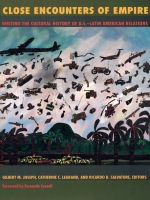 Close Encounters of Empire: Writing the Cultural History of U.S.-Latin American Relations
Gilbert M. Joseph, Catherine C. LeGrand, and Ricardo D. Salvatore, eds.
Duke University Press, 1998 New concerns with the intersections of culture and power, historical agency, and the complexity of social and political life are producing new questions about the United States’ involvement with Latin America. Turning away from political-economic models that see only domination and resistance, exploiters and victims, the contributors to this pathbreaking collection suggest alternate ways of understanding the role that U.S. actors and agencies have played in the region during the postcolonial period. Exploring a variety of nineteenth- and twentieth-century encounters in Latin America, these theoretically engaged essays by distinguished U.S. and Latin American historians and anthropologists illuminate a wide range of subjects. From the Rockefeller Foundation’s public health initiatives in Central America to the visual regimes of film, art, and advertisements; these essays grapple with new ways of conceptualizing public and private spheres of empire. As such, Close Encounters of Empire initiates a dialogue between postcolonial studies and the long-standing scholarship on colonialism and imperialism in the Americas as it rethinks the cultural dimensions of nationalism and development.
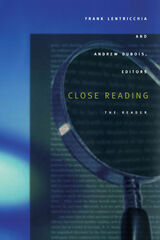 Close Reading: The Reader
Frank Lentricchia and Andrew DuBois, eds.
Duke University Press, 2003 An anthology of exemplary readings by some of the twentieth century’s foremost literary critics, Close Reading presents a wide range of responses to the question at the heart of literary criticism: how best to read a text to understand its meaning. The lively introduction and the selected essays provide an overview of close reading from New Criticism through poststructuralism, including works of feminist criticism, postcolonial theory, queer theory, new historicism, and more. From a 1938 essay by John Crowe Ransom through the work of contemporary scholars, Close Reading highlights the interplay between critics—the ways they respond to and are influenced by others’ works. To facilitate comparisons of methodology, the collection includes discussions of the same primary texts by scholars using different critical approaches. The essays focus on Hamlet, “Lycidas,” “The Rape of the Lock,” Ulysses, Invisible Man, Beloved, Jane Austen, John Keats, and Wallace Stevens and reveal not only what the contributors are reading, but also how they are reading. Frank Lentricchia and Andrew DuBois’s collection is an essential tool for teaching the history and practice of close reading. Contributors. Houston A. Baker Jr., Roland Barthes, Homi Bhabha, R. P. Blackmur, Cleanth Brooks, Kenneth Burke, Paul de Man, Andrew DuBois, Stanley Fish, Catherine Gallagher, Sandra Gilbert, Stephen Greenblatt, Susan Gubar, Fredric Jameson, Murray Krieger, Frank Lentricchia, Franco Moretti, John Crowe Ransom, Eve Kosofsky Sedgwick, Helen Vendler
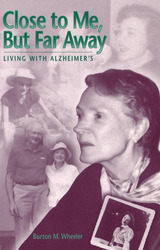 Close to Me, but Far Away: Living with Alzheimer's
Burton M. Wheeler
University of Missouri Press, 2001
Each day Burt Wheeler is plagued by the same question. When did it happen? If he could pinpoint the beginning, then he might begin to make peace with himself. He vividly remembers when the doctor diagnosed Kee, his loving wife of over fifty years, with "Alzheimer-type dementia." But, as hard as he tries, it's impossible for him to determine when his wife's dementia started. He remembers her bout with depression, but that, he thinks, was surely due to her breast cancer. There was their dream vacation to Greece when Kee seemed so tired and indifferent. There were the unopened books, when reading had always been such a source of pleasure to her. And, he recalls, the gradual personality changes with friends, and even with family.
Wheeler started writing this book as a form of self-therapy when he found himself thrust into the role of caretaker to his wife--a role for which he felt unprepared. He wrote in memory of the very special woman his wife had been—a wonderful mother, charming and gracious, as well as a deeply respected psychotherapist. She was also his best friend, and he loved her. So, to some degree, this is a love story—a story about two people who have shared life's ups and downs for over fifty years. It's also about commitment.
In Close to Me, but Far Away, Wheeler provides insight into what a caregiver's day is like, as he shares his most intimate thoughts with us. The book provides a window into the author's personal life as he seeks to confront his own ineptitude and the occasional despair he feels as he deals daily with Alzheimer's. He also touches on the question of what keeps him going through times of exhaustion and frustration. Part of his answer lies in holding tenaciously to memories, and part lies in what he believes is a human's extraordinary capacity to continue plodding along simply because he must. Wheeler also believes in rejoicing in the beauty that can be experienced, and he believes in humor, humor achieved only by distancing ourselves from the events that so deeply engage us. And, of course, there is also the indefinable nature of love.
Alzheimer's is a terrifying and horrible disease, as much for loved ones as for the patient. Those who are caregivers or friends of Alzheimer's patients or caregivers will empathize with Burton Wheeler's story. And some might receive comfort from his words or learn from him. Because Alzheimer's is a disease that could affect anyone, Close to Me, but Far Away is a story that should be read by all.
 Close Writing: Kathy Acker, Cookie Mueller, and Love-in-Pieces
Alice Butler
Duke University Press, 2026 In Close Writing, Alice Butler reflects on the diaries, letters, publications, performances, lives, and afterlives of her most beloved queer feminist writers: Kathy Acker and Cookie Mueller. While the transgressive avant-garde writer Kathy Acker has developed a cult following in the decades since her death in the late-90s, the actress and writer Cookie Mueller has remained relatively obscure. In this creative-critical study, Butler participates and responds to the lives and writings of her shared "beloved", reimagining the scene of the archive as a scene of triangulated and bittersweet love that traverses the boundaries of life and death. She draws on the autofictional strategies that Acker and Mueller pioneered in their own experimental writings and performances, encountering the women in intimate theoretical spaces of sensuality, sexuality, and sickness that slip between life and text. By encountering Acker and Mueller as transgressors and innovators, but also as beloved figures in her writing life whom she addresses in love letters, Butler brings readers to new, reparative textures of understanding, embodiment, and affection through close writing.
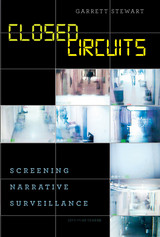 Closed Circuits: Screening Narrative Surveillance
Garrett Stewart
University of Chicago Press, 2015 The recent uproar over NSA dataveillance can obscure the fact that surveillance has been part of our lives for decades. And cinema has long been aware of its power—and potential for abuse.
In Closed Circuits, Garrett Stewart analyzes a broad spectrum of films, from M and Rear Window through The Conversation to Déjà Vu, Source Code, and The Bourne Legacy, in which cinema has articulated—and performed—the drama of inspection’s unreturned look. While mainstays of the thriller, both the act and the technology of surveillance, Stewart argues, speak to something more foundational in the very work of cinema. The shared axis of montage and espionage—with editing designed to draw us in and make us forget the omnipresence of the narrative camera—extends to larger questions about the politics of an oversight regime that is increasingly remote and robotic. To such a global technopticon, one telltale response is a proliferating mode of digitally enhanced “surveillancinema.”
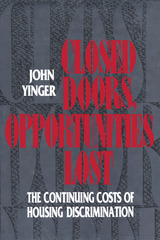 Closed Doors, Opportunities Lost: The Continuing Costs of Housing Discrimination
John Yinger
Russell Sage Foundation, 1995 "Yinger writes as if four decades of protest and progressive legislation have barely altered the terrain upon which minority Americans struggle for equality. He's right....Yinger figures that housing discrimination costs black homebuyers $5.7 billion and Hispanic homebuyers $3.4 billion every three years." —Washington Monthly Nearly three decades after the passage of the Fair Housing Act, illegal housing discrimination against blacks and Hispanics remains rampant in the United States. Closed Doors, Opportunities Lost reports on a landmark nationwide investigation of real estate brokers, comparing their treatment of equally qualified white, black, and Hispanic customers. The study reveals pervasive discrimination. Real estate brokers showed 25 percent fewer homes to the minority buyers, and loan agencies were 60 percent more likely to turn down minority applicants. Realtors and lenders also charged higher prices to minority buyers, withheld or gave insufficient financial and application information, and showed them homes only in non-white neighborhoods. Residents of minority neighborhoods faced further difficulties trying to sell their homes or obtain housing credit and homeowner's insurance. Economist John Yinger provides a lucid account of these disturbing facts and shows how deeply housing discrimination can affect the living conditions, education, and employment of black and Hispanic Americans. Deprived of residential mobility and discouraged from owning their own homes, many minority families are unable to flee stagnant or unsafe neighborhoods. Two thirds of black and Hispanic children are concentrated in high-poverty schools where educational achievement is low and dropout rates are high. The employment possibilities for minority job-seekers are diminished by the ongoing movement of jobs from the cities to the suburbs, where housing discrimination is particularly severe. Altogether, these effects of housing discrimination create a vicious cycle—discrimination imposes social and economic barriers upon blacks and Hispanics, and the resulting hardships fuel the prejudice that leads whites to associate minorities with neighborhood deterioration. Closed Doors, Opportunities Lost provides a history of fair housing and fair lending enforcement and joins the intense debate about integration policy. Yinger proposes a bold, comprehensive program that aims not only to end discrimination in housing and mortgage markets but to reverse their long-term effects by stabilizing poorer neighborhoods and removing the stigma of integration. He urges reforms to strengthen the enforcement powers of HUD and other agencies, provide funding for poor and integrated schools, encourage local housing and race-counseling programs, and shift income tax breaks toward low-income homebuyers. Closed Doors, Opportunities Lost provides valuable insight into the causes, extent, and consequences of housing discrimination—undeniably one of America's most vexing and important problems. This volume speaks directly to the ongoing debate about the nature and causes of poverty and the underclass, civil rights policy, the Community Reinvestment Act, and the plight of our nation's cities.
 Closed Encounters: Literary Politics and Public Culture
Jeffrey Wallen
University of Minnesota Press, 1998 Closed Encounters was first published in 1998. Minnesota Archive Editions uses digital technology to make long-unavailable books once again accessible, and are published unaltered from the original University of Minnesota Press editions. It's committed. It's political. It's socially engaged. It's academic criticism in the nineties. But what does it achieve? In a provocative and fair-minded look at current critical practices and the future of the academy, Jeffrey Wallen draws a disturbing picture of public intellectuals in search of a public and cultural critics unable to enter a dialogue with others. Wallen argues that literary politics is no substitute for debate on genuine political issues. Taking up several of the most influential critics of recent years-Edward Said, Eve Kosofsky Sedgwick, Michael Bérubé, Gerald Graff, Richard Rorty, Stanley Fish, and many others-Wallen asks: Can their desire to persuade an audience beyond the classroom be fulfilled? And can cultural critics realize their ambitious social and institutional goals for change? In a work that is neither of the Left nor of the Right, but likely to unsettle both, Wallen argues that literary criticism actually undermines the prospects for the dialogue it calls out for. In addition, Wallen argues that the institutionalization of critiques of truth and difference-critiques that appear to liberate us by revealing that knowledge and values are constructed, and can therefore be transformed-often leads to a further constraining of thought and narrowing of outlooks. In his analysis of the administration of conflict, Wallen describes the troubled state of academic freedom and points to a shift from the institutional protection of dissenting views to the institutional protection from views one finds unpleasant. Yet the prospects are not bleak: Wallen emphasizes that academic critics continue to play a crucial role in crafting what we expect from discussion. In this spirit, Closed Encounters lays the groundwork for fashioning a truly public, socially engaged criticism.
Closed for Repairs
Nancy Alonso, translated from the Spanish by Anne Fountain
Northwestern University Press, 2007 Closed for Repairs is a series of eleven vignettes that depict Cuban ingenuity in the face of urban problems. Each solution is framed with humor and irony and gives a glimpse of life on the island today. In a clever fashion, Nancy Alonso shows us the spirit of resolve on the part of Cubans when faced with such issues as transportation problems, lack of water, and the shortage of consumer goods and construction materials caused by the embargo. Illuminating the endurance and resilience of the Cuban people, these stories will make you chuckle. Alonso's sly wit is compelling as she satirizes the bureaucracy—an element of her work that will resonate universally.
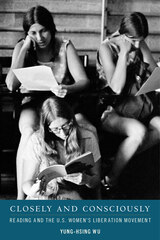 Closely and Consciously: Reading and the US Women's Liberation Movement
Yung-Hsing Wu
University of Massachusetts Press, 2024 The significant archive of writing that came out of the women’s liberation movement in the United States, from 1965 to 1980, speaks to the value activists placed on reading as an act that is at once personal and yet also about the collective good. Yung-Hsing Wu examines the importance of reading—personal, professional, vocational, aesthetic, and always political—and how the act itself brought a host of women, each with their own history with the movement, into relation, and into a belief in that relation. The value given to reading can be seen in the ways feminists pursued media representation; in consciousness-raising (CR) groups including shared reading in their meetings; in women opening bookstores, developing newsletters, establishing journals, and starting presses; and in corporate publishers pursuing feminist fiction.
Closely and Consciously crisscrosses distinct print spheres, including newsletters and periodicals produced by feminist cells and consciousness-raising groups, feminist presses seeking to articulate their visions for women’s writing, the emergence of feminist literary criticism in first-time monographs and newly established journals, personal and editorial correspondence, press records, and the publishing histories of bestsellers that testified to the increasingly broad popularity of women’s writing. Uniting all these disparate activists and media outlets, and providing crucial relationality, was reading. With a mix of close readings and archival research, Wu unpacks and interprets this central act of reading and why it matters during a crucial moment of feminist history.
Closely Watched Trains
Bohumil Hrabal
Northwestern University Press, 1995 Hrabal's postwar classic about a young man's coming of age in German-occupied Czechoslovakia is among his most popular works. Milos Hrma is a timid railroad apprentice who insulates himself with fantasy against a reality filled with cruelty and grief. After receiving acclaim as a novel, Closely Watched Trains was made into a successful film that won the Academy Award for Best Foreign Film of 1967.
 Closer to Home: English Writers and Places, 1780–1830
Roger Sale
Harvard University Press, 1986 Roger Sale invites us to look afresh at five English authors: Jane Austen, Wordsworth, and—famous in their time but half forgotten today—George Crabbe, William Cobbett, and John Clare. The five differ greatly in style, tone, temper, subject, and genre. What they have in common is the importance they attach to place: not the generalized places of Renaissance literature, nor the pictorially composed scenery of the landscape poets, but specific localities that have a profound effect on their own lives or those of their characters.
Sale is a perceptive critic, with the gift of empathy. We are caught up in his account of Crabbe's Peter Grimes, condemned to his ghastly mudflats and marshes, projecting onto the river the emblems of his guilt. So too with Clare's evocations of his beloved countryside as it once had been but was no more, and Cobbett's shrewd perceptions of rural life; with Wordsworth's creation of two distinct Lake Districts, the one of his maturity and the one of his haunted childhood; with Austen's heroines achieving freedom by accepting the challenge of living in their confined space.
The distinctive qualities of each of these writers and their places are conveyed with imaginative sympathy. To read these chapters is to come to know, or know better, five writers worth knowing. And to go with Sale to Crabbe's Aldeburgh, Austen's Mansfield and Highbury, Cobbett's rural routes, Clare's Helpston, and Wordsworth's Lakes region is to experience these special places as well. It is a rewarding excursion.
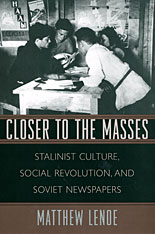 Closer to the Masses: Stalinist Culture, Social Revolution, and Soviet Newspapers
Matthew Lenoe
Harvard University Press, 2004 In this provocative book, Matthew Lenoe traces the origins of Stalinist mass culture to newspaper journalism in the late 1920s. In examining the transformation of Soviet newspapers during the New Economic Policy and the First Five Year Plan, Lenoe tells a dramatic story of purges, political intrigues, and social upheaval.
Under pressure from the party leadership to mobilize society for the monumental task of industrialization, journalists shaped a master narrative for Soviet history and helped create a Bolshevik identity for millions of new communists. Everyday labor became an epic battle to modernize the USSR, a fight not only against imperialists from outside, but against shirkers and saboteurs within. Soviet newspapermen mobilized party activists by providing them with an identity as warrior heroes battling for socialism. Yet within the framework of propaganda directives, the rank-and-file journalists improvised in ways that ultimately contributed to the creation of a culture. The images and metaphors crafted by Soviet journalists became the core of Stalinist culture in the mid-1930s, and influenced the development of socialist realism.
Deeply researched and lucidly written, this book is a major contribution to the literature on Soviet culture and society.
Closest Pronunciation: Poems
Ed Roberson
Northwestern University Press, 2013 Northwestern University Press is honored to inaugurate the Drinking Gourd Chapbook Poetry Prize series with Ed Roberson’s Closest Pronunciation. Here is a teacher of poets studying his own assignments, questioning and seeking the generative capacity in looking at and seeing things that ends in the realization of a poem. In a line from the brief poem "Night Writing," from which the chapbook draws its title, he writes, "The word closest in pronunciation / To an ambulance’s siren is ‘wrong.’" The collection as a whole gives voice, often quiet but always profound, to many things overlooked and neglected in culture, nature, and everyday life.
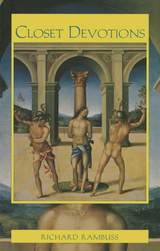 Closet Devotions
Richard Rambuss
Duke University Press, 1998 Religion and sex, body and soul, sacred and profane: In Closet Devotions, Richard Rambuss traces the relays between these cultural formations by examining the issue of “sacred eroticism,” the literary or artistic expression of devotional feelings in erotic terms that has repeatedly occurred over the centuries. Rather than dismissing such expression as mere convention, Rambuss takes it seriously as a form of erotic discourse, one that gives voice to desires that, outside the sphere of sacred rapture, would otherwise be deemed taboo. Through startling rereadings of works ranging from the devotional verse of the metaphysical poets (Donne, Herbert, Crashaw, and Traherne) to photographer Andres Serrano’s controversial “Piss Christ,” from Renaissance religious iconography to contemporary gay porn, Rambuss uncovers the highly charged erotic imagery that suffuses religious devotional art and literature. And he explores one of Christian culture’s most guarded (and literal) closets—the prayer closet itself, a privileged space where the vectors of same-sex desire can travel privately between the worshiper and his or her God. Elegantly written and theoretically astute, Closet Devotions illuminates the ways in which sacred Christian devotion is homoeroticized, a phenomenon that until now has gone unexplored in current scholarship on religion, the body, and its passions. This book will attract readers across a wide array of disciplines, including gay and lesbian studies, literary theory and criticism, Renaissance studies, and religion.
 Closet Writing/Gay Reading: The Case of Melville's Pierre
James Creech
University of Chicago Press, 1994 One of the most urgent tasks for gay studies today, James Creech argues, is the retrieval of a repressed, "closeted" literary heritage. But contradictions and problems cloud even the most basic theoretical questions: What does a lesbian or gay reading of a literary text require or presume? Can we talk about a homosexual writer expressing him- or herself before the invention of "homosexuality"? Was it possible for a writer like Herman Melville, for example, to create literary works linked to his own prohibited eros?
In Closet Writing/Gay Reading, Creech shows how a literary critic can be receptive to implicit and closeted sexual content. Forcefully advocating a tactic of identification and projection in literary analysis, he lends renewed currency to the kind of "sentimental" response to literature that continental theory—particularly deconstruction—has sought to discredit.
In the second half of his book, Creech sets out to analyze what he considers the exemplary novel of the nineteenth-century closet, Melville's Pierre, or: The Ambiguities. By approaching Pierre as the gay man Melville longed to have as its reader, Creech is able to decipher the novel's "encrypted erotics" and to reveal that Melville's apparent tale of incest is actually a homosexual novel in disguise. The closeted "address" to queer-sensitive readers that Pierre disseminates finally receives a critical reading that strives to be explicit, shareable, and public.
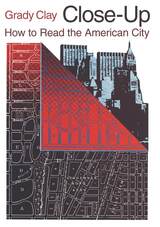 Close-Up: How to Read the American City
Grady Clay
University of Chicago Press, 1980 "Grady Clay looks hard at the landscape, finding out who built what and why, noticing who participates in a city's success and who gets left in a 'sink,' or depressed (often literally) area. Clay doesn't stay in the city; he looks at industrial towns, truck stops, suburbs—nearly anywhere people live or work. His style is witty and readable, and the book is crammed with illustrations that clarify his points. If I had to pick up one book to guide my observations of the American scene, this would be it."—Sonia Simone, Whole Earth Review
"The emphasis on the informal aspects of city-shaping—topographical, historical, economic and social—does much to counteract the formalist approach to American urban design. Close-Up...should be required reading for anyone wishing to understand Americans and their cities."—Roger Cunliffe, Architectural Review
"Close-Up is a provocative and stimulating book."—Thomas J. Schlereth, Winterthur Portfolio
"Within this coherent string of essays, the urban dweller or observer, as well as the student, will find refreshing strategies for viewing the environmental 'situations' interacting to form a landscape."—Dallas Morning News
"Clay's Close-Up, first published in 1973, is still a key book for looking at the real American city. Too many urban books and guidebooks concentrate on the good parts of the city....Clay looks at all parts of the city, the suburbs, and the places between cities, and develops new terms to describe parts of the built environment—fronts, strips, beats, stacks, sinks, and turf. No one who wants to understand American cities or to describe them, should fail to know this book. The illustrations are of special interest to the guidebook writer."—American Urban Guidenotes
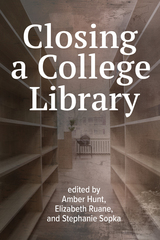 Closing a College Library
Amber Hunt
Association of College & Research Libraries, 2024 There are a growing number of college closures and mergers in the United States. The reasons vary—sharply declining enrollment numbers, unsustainable endowment drawdowns, accreditation issues—as does the amount of notice stakeholders receive before the closure and the fate of the campus and its resources.
Closing a College Library offers firsthand accounts of closing a library from different institutions of higher education, with practical tips, checklists, and sample documents, questions to ask yourself as you move through the process, and lessons learned. It provides effective practices for the immediate needs that arise when a library is facing closure, from preparing the building to rehoming special collections and archives to transferring electronic resources.
There is much unfamiliar work that comes with a closure or merger, work that can happen concurrently with your regular duties and while you’re handling the emotions of your team, students, alumni, faculty, and staff. Closing a College Library offers tools and support in making difficult decisions.
 Closing Arguments: Clarence Darrow on Religion, Law, and Society
Clarence Darrow
Ohio University Press, 2005 Clarence Darrow, son of a village undertaker and coffinmaker, rose to become one of America’s greatest attorneys—and surely its most famous. The Ohio native gained renown for his central role in momentous trials, including his 1924 defense of Leopold and Loeb and his defense of Darwinian principles in the 1925 Scopes “Monkey Trial.” Some have traced Darrow’s lifelong campaign against capital punishment to his boyhood terror at seeing a Civil War soldier buried—and no client of Darrow’s was ever executed, not even black men who were accused of murder for killing members of a white mob. Closing Arguments: Clarence Darrow on Religion, Law, and Society collects, for the first time, Darrow’s thoughts on his three main preoccupations, revealing a carefully conceived philosophy expressed with delightful pungency and clarity. His thoughts on social issues, especially on the dangers of religious fundamentalism, are uncannily prescient. A dry humor infuses his essays, and his reflections on himself and his philosophy reveal a quiet dignity at the core of a man better known for provoking Americans during an era of unprecedented tumult. From the wry “Is the Human Race Getting Anywhere?” to the scornful “Patriotism” and his elegiac summing up, “At Seventy-two,” Darrow’s writing still stimulates, pleases and challenges. A rebel who always sided intellectually and emotionally with the minority, Darrow remains a figure to contend with sixty-seven years after his death. “Inside every lawyer is the wreck of a poet,” Darrow once said. Closing Arguments demonstrates that, in his case, that statement is true.
 The Closing Door: Conservative Policy and Black Opportunity
Gary Orfield and Carole Ashkinaze
University of Chicago Press, 1991 The Closing Door is the first major critique of the effect of conservative policies on urban race and poverty in the 1980s. Atlanta, with its booming economy, strong elected black leadership, and many highly educated blacks, seemed to be the perfect site for those policies and market solutions to prove themselves. Unfortunately, not only did expected economic opportunity fail to materialize but many of the hard-won gains of the civil rights movement were lost. Orfield and Ashkinaze painstakingly analyze the evidence from Atlanta to show why black opportunity deteriorated over the 1980s and outline possible remedies for the damage inflicted by the Reagan and Bush administrations.
"The Closing Door is a crucial breath of fresh air . . . an important and timely text which will help to alter the 'underclass' debate in favor of reconsidering race-specific policies. Orfield and Ashkinaze construct a convincing argument with which those who favor 'race-neutrality' will have to contend. In readable prose they make a compelling case that economic growth is not enough."—Preston H. Smith II, Transition
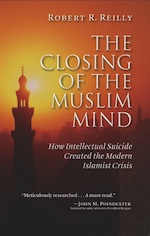 The Closing of the Muslim Mind: How Intellectual Suicide Created the Modern Islamist
Robert R. Reilly
Intercollegiate Studies Institute, 2010
Islam’s Intellectual Suicide—and the Threat to Us All
People are shocked and frightened by the behavior coming out the Islamic world—not only because it is violent, but also because it is seemingly inexplicable. While there are many answers to the question of “what went wrong” in the Muslim world, no one has decisively answered why it went wrong. Until now.
In this eye-opening new book, foreign policy expert Robert R. Reilly uncovers the root of our contemporary crisis: a pivotal struggle waged within the Muslim world nearly a millennium ago. In a heated battle over the role of reason, the side of irrationality won. The deformed theology that resulted, Reilly reveals, produced the spiritual pathology of Islamism, and a deeply dysfunctional culture.
Terrorism—from 9/11, to London, Madrid, and Mumbai, to the Christmas 2009 attempted airline bombing—is the most obvious manifestation of this crisis. But Reilly shows that the pathology extends much further. The Closing of the Muslim Mindsolves such puzzles as:
· why peace is so elusive in the Middle East
· why the Arab world stands near the bottom of every measure of human development
· why scientific inquiry is nearly dead in the Islamic world
· why Spain translates more books in a single year than the entire Arab world has in the past thousand years
· why some people in Saudi Arabia still refuse to believe man has been to the moon
· why Muslim media frequently present natural disasters like Hurricane Katrina as God’s direct retribution
Delving deeper than previous polemics and simplistic analyses, The Closing of the Muslim Mindprovides the answers the West has so desperately needed in confronting the Islamist crisis.
WHAT THEY ARE SAYING
"The lack of liberty within Islam is a huge problem. Robert Reilly’s The Closing of the Muslim Mind shows that a millennium ago Muslims debated whether minds should be free to explore the world—and freedom lost. The intellectual history he offers helps to explain why Muslim countries fell behind Christian-based ones in scientific inquiry, economic development, and technology. Reilly provides astonishing statistics . . . [and] also points out how theology prefigures politics."
—World Magazine
"As Robert R. Reilly points out in The Closing of the Muslim Mind . . . the Islamic conception of God as pure will, unbound by reason and unknowable through the visible world, rendered any search for cause and effect in nature irrelevant to Muslim societies over centuries, resulting in slipshod, dependent cultures. Reilly notes, for example, that Pakistan, a nation which views science as automatically impious given its view that an arbitrary God did not imprint upon nature a rational order worth investigating, produces almost no patents."
—American Spectator
"What happened to moderate Islam and what sort of hope we may have for it in the future is the subject of Robert Reilly’s brilliant and groundbreaking new book. The Closing of the Muslim Mind is a page-turner that reads almost like an intellectual detective novel...One thing Reilly’s account makes clear: Only when we move beyond the common platitudes of our contemporary political discussion and begin to deal with Islam as it really is — rather than the fiction that it is the equivalent of our Western culture dressed up in a burqa — will we be able to help make progress in that direction." —National Review Online
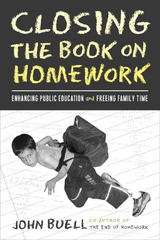 Closing The Book On Homework: Enhancing Public Education
John Buell
Temple University Press, 2003 In this, the sequel to his critically acclaimed and controversial The End of Homework, John Buell extends his case against homework. Arguing that homework robs children—and parents—of unstructured time for play and intellectual and emotional development, Closing the Book on Homework offers a convincing case for why homework is an outgrowth of broader cultural anxieties about the sanctity of work itself. After the publication of Buell's previous book, many professional educators portrayed reducing homework as a dangerous idea, while at the same time parents and teachers increasingly raised doubts as to its continued usefulness in education. According to John Buell, the importance of play is culturally underappreciated. Not only grade schoolers, but high school students and adult workers deserve time for the kind of leisure that fosters creativity and sustains a life long interest in learning. Homework is assigned for many reasons, many having little to do with learning, including an accepted, if unchallenged, belief that it fosters good work habits for children's futures. As John Buell argues convincingly, homework does more to obstruct the growth of children's minds, and consumes the time of parents and children who may otherwise develop relationships that foster true growth and learning. A unique book that is sure to fuel the growing debate on school reform, Closing the Book on Homework offers a roadmap for learning that will benefit the wellbeing of children, parents, and teachers alike.
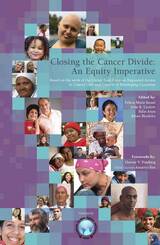 Closing the Cancer Divide: An Equity Imperative
Felicia Marie Knaul
Harvard University Press, 2012 Cancer has become a leading cause of death and disability and a serious yet unforeseen challenge to health systems in low- and middle-income countries. A protracted and polarized cancer transition is under way and fuels a concentration of preventable risk, illness, suffering, impoverishment from ill health, and death among poor populations. Closing this cancer divide is an equity imperative. The world faces a huge, unperceived cost of failure to take action that requires an immediate and large-scale global response.
Closing the Cancer Divide presents strategies for innovation in delivery, pricing, procurement, finance, knowledge-building, and leadership that can be scaled up by applying a diagonal approach to health system strengthening. The chapters provide evidence-based recommendations for developing programs, local and global policy-making, and prioritizing research. The cases and frameworks provide a guide for developing responses to the challenge of cancer and other chronic illnesses. The book summarizes results of the Global Task Force on Expanding Access to Cancer Care and Control in Developing Countries, a collaboration among leaders from the global health and cancer care communities worldwide, originally convened by Harvard University. It includes contributions from civil society, global and national policy-makers, patients and practitioners, and academics representing an array of fields.
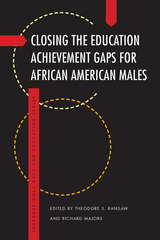 Closing the Education Achievement Gaps for African American Males
Theodore S. Ransaw
Michigan State University Press, 2016 Closing the Education Achievement Gaps for African American Males is a research-based tool to improve the schooling experience of African American males. Editors Theodore S. Ransaw and Richard Majors draw together a collection of writings that provide much-needed engagement with issues of gender and identity for black males, as well as those of culture, media, and technology, in the context of education.
The distinguished and expert contributors whose work comprises this volume include an achievement-gap specialist for males of color, two psychologists, a math teacher, an electrical engineer, a former school principal, a social worker, and a former human rights commissioner. From black male learning styles to STEM, this book shows that issues pertaining to educational outcomes for black males are nuanced and complex but not unsolvable.
With its combination of fresh new approaches to closing achievement gaps and up-to-date views on trends, this volume is an invaluable resource on vital contemporary social and educational issues that aims to improve learning, equity, and access for African American males.
Closure: The Rush to End Grief and What it Costs Us
Nancy Berns
Temple University Press, 2011 When it comes to the end of a relationship, the loss of a loved one, or even a national tragedy, we are often told we need “closure.” But while some people do find closure for their pain and grief, many more feel closure does not exist and believe the notion only promises false hopes. Sociologist Nancy Berns explores these ideas and their ramifications in her timely book, Closure. Berns uncovers the various interpretations and contradictory meanings of closure. She identifies six types of “closure talk,” revealing closure as a socially constructed concept—a “new emotion.” Berns also explores how closure has been applied widely in popular media and how the idea has been appropriated as a political tool and to sell products and services. This book explains how the push for closure—whether we find it helpful, engaging, or enraging—is changing our society.
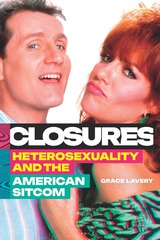 Closures: Heterosexuality and the American Sitcom
Grace Lavery
Duke University Press, 2024 From The Mary Tyler Moore Show to Arrested Development to BoJack Horseman, the American sitcom revolves around crises that must be resolved by episode’s end, with a new crisis to come next week. In Closures, Grace Lavery reconsiders the genre’s seven-decade history as an endless cycle of crisis and closure that formally and representationally frames heterosexuality as constantly on the verge of both collapse and reconstitution. She shows that even the normiest family-based sitcoms rely on queer characters like Alice (The Brady Bunch) and Steve Urkel (Family Matters) who highlight how the family is perpetually incomplete and unstable. Analyzing the genre’s techniques and devices such as the laugh track and the cringe pan, Lavery also charts the shift to friend-group and workplace sitcoms like Friends and The Office, which she contends reflect a weakening of social ties in ways that place characters in an unending state of becoming. With this capacious yet svelte queer and trans theorization of the sitcom, Lavery demonstrates that the family ties that bind the genre’s normative heterosexuality are far more tenuous than we have been led to believe.
The Cloth of Many Colored Silks: Papers on History and Society Ghanaian and Islamic in Honor of Ivor Wilks
John Hunwick and Nancy Lawler
Northwestern University Press, 1997 The Cloth of Many Colored Silks collects a wide variety of scholarship dealing with Ghanaian history and society, including papers by Basil Davidson, Jean Allman, Esther Goody and Jack Goody, Sandra E. Greene, Polly Hill, Ray A. Kea, Peter Shinnie, Victoria B. Tashjian, Larry W. Yarak, Ralph A. Austen, Paulo Fernando de Moraes Farias, Robert S. Kramer, Robert Launay, Donna J.E. Maier, R.S. O'Fahey, David Owusu-Ansah, and Enid Schildkrout.
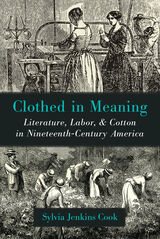 Clothed in Meaning: Literature, Labor, and Cotton in Nineteenth-Century America
Sylvia Jenkins Cook
University of Michigan Press, 2020 The rise of both the empire of cotton and the empire of fashion in the nineteenth century brought new opportunities for sartorial self-expression to millions of ordinary people who could now afford to dress in style and assert their physical presence. Millions of laborers toiling in cotton fields and producing cotton cloth in industrial mills faced a brutal reality of exploitation, servitude, and regimentation—yet they also had a profound desire to express their selfhood. Another transformative force of this era—the rise of literary publication and the radical extension of literacy to the working class—opened an avenue for them to do so.
Cloth and clothing provide potent tropes not only for physical but also for intellectual forms of self-expression. Drawing on sources ranging from fugitive slave narratives, newspapers, manifestos, and mill workers’ magazines to fiction, poetry, and autobiographies, Clothed in Meaning examines the significant part played by mill workers and formerly enslaved people, many of whom still worked picking cotton, in this revolution of literary self-expression. They created a new literature from their palpable daily intimacy with cotton, cloth, and clothing, as well as from their encounters with grimly innovative modes of work. In the materials of their labor they discovered vivid tropes for formulating their ideas and an exotic and expert language for articulating them. The harsh conditions of their work helped foster in their writing a trenchant irony toward the demeaning reduction of human beings to “hands” whose minds were unworthy of interest. Ultimately, Clothed in Meaning provides an essential examination of the intimate connections between oppression and luxury as recorded in the many different voices of nineteenth-century labor.
Clothed Villainy: Acting White in Early Modern Drama
Jamie Paris
University of Alabama Press, 2026 A striking blend of critical race theory, performance studies, and Indigenous scholarship that examines performative whiteness and its roots in early modern drama. Written with bold clarity and personal insight, Clothed Villainy challenges readers to confront their assumptions about race, history, and identity. This is a book for scholars, students, and anyone seeking to understand the deeply entrenched performance of race in our society—and how we might reimagine it for a more equitable world.
Clothes Make the Man: Early Medieval Textiles from the Netherlands
Chrystel R. Brandenburgh
Leiden University Press, 2017 Textiles that have been uncovered in archaeological excavations include garments, household fabrics, and sails. But until now, systematic analyses of such discoveries had not yet been undertaken for Dutch artifacts. Closing this considerable gap, Clothes Make the Man focuses on textile remains dating from between 400 and 1000 CE that have been recovered from settlements and cemeteries in what is now the Netherlands. As Chrystel R. Brandenburgh shows, such fabrics enable valuable reconstructions of burial clothing and yield important data about their production processes and techniques.
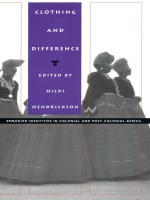 Clothing and Difference: Embodied Identities in Colonial and Post-Colonial Africa
Hildi Hendrickson, ed.
Duke University Press, 1996 This volume examines the dynamic relationship between the body, clothing, and identity in sub-Saharan Africa and raises questions that have previously been directed almost exclusively to a Western and urban context. Unusual in its treatment of the body surface as a critical frontier in the production and authentification of identity, Clothing and Difference shows how the body and its adornment have been used to construct and contest social and individual identities in Nigeria, Zimbabwe, Tanzania, Kenya, and other African societies during both colonial and post-colonial times. Grounded in the insights of anthropology and history and influenced by developments in cultural studies, these essays investigate the relations between the personal and the public, and between ideas about the self and those about the family, gender, and national groups. They explore the bodily and material creation of the changing identities of women, spirits, youths, ancestors, and entrepreneurs through a consideration of topics such as fashion, spirit possession, commodity exchange, hygiene, and mourning. By taking African societies as its focus, Clothing and Difference demonstrates that factors considered integral to Western social development—heterogeneity, migration, urbanization, transnational exchange, and media representation—have existed elsewhere in different configurations and with different outcomes. With significance for a wide range of fields, including gender studies, cultural studies, art history, performance studies, political science, semiotics, economics, folklore, and fashion and textile analysis/design, this work provides alternative views of the structures underpinning Western systems of commodification, postmodernism, and cultural differentiation. Contributors. Misty Bastian, Timothy Burke, Hildi Hendrickson, Deborah James, Adeline Masquelier, Elisha Renne, Johanna Schoss, Brad Weiss
Clothing Goes to War: Creativity Inspired by Scarcity in World War II
Nan Turner
Intellect Books, 2021 The story of civilian clothing use during World War II.
Manufacturing for civilians across the globe nearly stopped at the outset of World War II, as outfitting troops took precedence over nonmilitary production. Raw materials were prioritized for the armed forces and the majority of nonmilitary factories were shifted to war work, resulting in shortages and rationing of consumer products. Civilians, especially women, responded to the resulting scarcity of goods by using ingenuity and creativity to “make do.” In Clothing Goes to War, Nan Turner offers a critical look at some of the resourceful results of this period as necessity paved the way for fashionable invention.
 Clothing Matters: Dress and Identity in India
Emma Tarlo
University of Chicago Press, 1996 What do I wear today? The way we answer this question says much about how we manage and express our identities. This detailed study examines sartorial style in India from the late nineteenth century to the present, showing how trends in clothing are related to caste, level of education, urbanization, and a larger cultural debate about the nature of Indian identity.
Clothes have been used to assert power, challenge authority, and instigate social change throughout Indian society. During the struggle for independence, members of the Indian elite incorporated elements of Western style into their clothes, while Gandhi's adoption of the loincloth symbolized the rejection of European power and the contrast between Indian poverty and British wealth. Similar tensions are played out today, with urban Indians adopting "ethnic" dress as villagers seek modern fashions.
Illustrated with photographs, satirical drawings, and magazine advertisements, this book shows how individuals and groups play with history and culture as they decide what to wear.
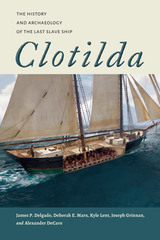 Clotilda: The History and Archaeology of the Last Slave Ship
James P. Delgado, Deborah E. Marx, Kyle Lent, Joseph Grinnan, and Alexander DeCaro
University of Alabama Press, 2023 Documents the maritime historical research and archaeological fieldwork used to identify the wreck of the notorious schooner Clotilda
Clotilda: The History and Archaeology of the Last Slave Ship is the first definitive work to examine the maritime historical and archaeological record of one of the most infamous ships in American history. Clotilda was owned by Alabama businessman Timothy Meaher, who, on a dare, equipped it to carry captured Africans from what is now Benin and bring them to Alabama in 1860—some fifty years after the import of captives to be enslaved was banned. To hide the evidence, Clotilda was set afire and sunk.
What remained was a substantially intact, submerged, and partially buried shipwreck located in a backwater of the Mobile River. The site of the wreck was an open secret to some people who knew Meaher, but its identity remained unknown for more than a century as various surveys through the years failed to locate the ship.
This volume, authored by the archaeological team who conducted a comprehensive, systematic survey of a forgotten “ship graveyard,” details the exhaustive forensic work that conclusively identified the wreck, as well as the stories and secrets that have emerged from the partly burned hulk. James P. Delgado and his coauthors discuss the various searches for Clotilda, sharing the forensic data and other analyses showing how those involved concluded that this wreck was indeed Clotilda. Additionally, they offer physical evidence not previously shared that situates the schooner and its voyage in a larger context of the slave trade.
Clotilda: The History and Archaeology of the Last Slave Ship serves as a nautical biography of the ship as well. After reviewing the maritime trade in and out of Mobile Bay, this account places Clotilda within the larger landscape of American and Gulf of Mexico schooners and chronicles its career before being used as a slave ship. All of its voyages had a link to slavery, and one may have been another smuggling voyage in violation of federal law. The authors have also painstakingly reconstructed Clotilda’s likely appearance and characteristics.
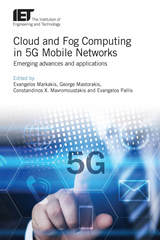 Cloud and Fog Computing in 5G Mobile Networks: Emerging advances and applications
Evangelos Markakis
The Institution of Engineering and Technology, 2017 Cloud computing is a key trend in computing and networking. Now diffused among end-users devices in mobile and wireline networks, the cloud is becoming the "fog". This book presents frameworks and schemes that use devices from end-users or near-users to carry out storage, communication, computation and control in the network. These novel approaches support the Internet of Things, the efficient provision of heterogeneous 5G mobile services, as well as emerging applications over future wireless network architectures. Elaborating on the emerging mobile networking paradigms for the 2020 5G timeframe, this book presents new connectivity services that are highly scalable and programmable in terms of speed, capacity, security, reliability, availability, latency and impact on battery life. Finally, the book discusses recent and new developments, prompting future directions on the theories, practices, standards and strategies related to 5G mobile systems.
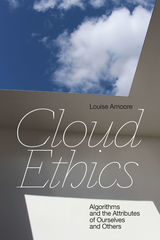 Cloud Ethics: Algorithms and the Attributes of Ourselves and Others
Louise Amoore
Duke University Press, 2020 In Cloud Ethics Louise Amoore examines how machine learning algorithms are transforming the ethics and politics of contemporary society. Conceptualizing algorithms as ethicopolitical entities that are entangled with the data attributes of people, Amoore outlines how algorithms give incomplete accounts of themselves, learn through relationships with human practices, and exist in the world in ways that exceed their source code. In these ways, algorithms and their relations to people cannot be understood by simply examining their code, nor can ethics be encoded into algorithms. Instead, Amoore locates the ethical responsibility of algorithms in the conditions of partiality and opacity that haunt both human and algorithmic decisions. To this end, she proposes what she calls cloud ethics—an approach to holding algorithms accountable by engaging with the social and technical conditions under which they emerge and operate.
Cloud Moving Hands
Cathy Song
University of Pittsburgh Press, 2007 These poems, threaded by the teachings of Buddha, examine loss—the death of a loved one, the longing for a child, the yearning for another place and time—and the suffering such attempts transpire, but ultimately the poems are an affirmation that to be born into human life is our greatest opportunity to transform loss and sorrow into awakening joy.
Cloud of Ink
L. S. Klatt
University of Iowa Press, 2011 On the surface, L. S. Klatt’s poems are airy and humorous—with their tales of chickens wandering the highways of Ohio and Winnebago trailers rolling up to heaven and whales bumping like watermelons in a bathtub—but just under the surface they turn disconcertingly serious as they celebrate the fluent word. Under the heat of inquiry, under the pressure of metaphor, the poems in Cloud of Ink liquefy, bend, and serpentine as they seek sometimes a new and sometimes an ancient destination. They present the reader with existential questions as they side-wind into the barbaric; the pear is figured as a “wild boar” and the octopus is “gutted,” yet primal energies cut a pathway to the mystical and the transcendent. The poetic cosmos Klatt creates is loquacious and beautiful, strange and affirmative, but never transparent. Amid “a maelstrom of inklings,” the writer—and the audience—must puzzle out the meaning of the syllabary.
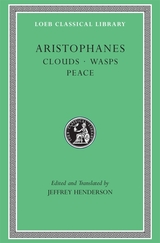 Clouds. Wasps. Peace
Aristophanes
Harvard University Press, 1998 The master of Old Comedy.
Aristophanes of Athens, one of the world’s greatest comic dramatists, has been admired since antiquity for his iridescent wit and beguiling fantasy, exuberant language, and brilliant satire of the social, intellectual, and political life of Athens at its height. The Loeb Classical Library edition of his plays is in four volumes.
The Introduction to the edition is in Volume I. Also in the first volume is Acharnians, in which a small landowner, tired of the Peloponnesian War, magically arranges a personal peace treaty; and Knights, perhaps the most biting satire of a political figure (Cleon) ever written.
Three plays are in Volume II. Socrates’ “Thinkery” is at the center of Clouds, which spoofs untraditional techniques for educating young men. Wasps satirizes Athenian enthusiasm for jury service. In Peace, a rollicking attack on war-makers, the hero travels to heaven on a dung beetle to discuss the issues with Zeus.
The enterprising protagonists of Birds create a utopian counter-Athens ruled by birds. Also in Volume III is Lysistrata, in which our first comic heroine organizes a conjugal strike of young wives until their husbands end the war between Athens and Sparta. Women again take center stage in Women at the Thesmophoria, this time to punish Euripides for portraying them as wicked.
Frogs, in Volume IV, features a contest between the traditional Aeschylus and the modern Euripides, yielding both sparkling comedy and insight on ancient literary taste. In Assemblywomen Athenian women plot to save Athens from male misgovernance—with raucously comical results. Here too is Wealth, whose gentle humor and straightforward morality made it the most popular of Aristophanes’ plays from classical times to the Renaissance.
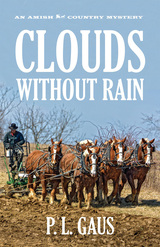 Clouds Without Rain: An Amish Country Mystery
P. L. Gaus
Ohio University Press, 2001 Written in the tradition of Tony Hillerman, in Clouds without Rain, P. L. Gaus once again provides compelling intrigue and insight into Amish culture and tradition alongside contemporary American life. In the wake of a fatal accident involving an Amish buggy and an eighteen-wheeler, Professor Michael Branden, working with the Holmes County Sheriff’s Department, becomes suspicious about the true nature of the crash. His suspicions only grow when the trustee of the dead man’s estate disappears a few days later. Faced with Amish teenagers in goat masks robbing buggies on dusty lanes, land swindles involving out-of-town developers, several mysterious deaths, and the disappearance of a bank official, Branden realizes that there is far more to the story than a buggy crash on a sleepy country road. This new edition of Clouds without Rain features an exclusive interview with the author, reading group materials, and a detailed map and driving guide to Holmes County, Ohio with everything one needs to visit the iconic scenes depicted in the story.
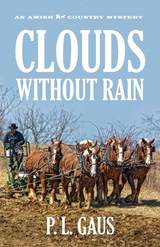 Clouds without Rain: An Amish Country Mystery
P. L. Gaus
Ohio University Press, 2001 Written in the tradition of Tony Hillerman, in Clouds without Rain, P. L. Gaus once again provides compelling intrigue and insight into Amish culture and tradition alongside contemporary American life. In the wake of a fatal accident involving an Amish buggy and an eighteen-wheeler, Professor Michael Branden, working with the Holmes County Sheriff’s Department, becomes suspicious about the true nature of the crash. His suspicions only grow when the trustee of the dead man’s estate disappears a few days later. Faced with Amish teenagers in goat masks robbing buggies on dusty lanes, land swindles involving out-of-town developers, several mysterious deaths, and the disappearance of a bank official, Branden realizes that there is far more to the story than a buggy crash on a sleepy country road. This new edition of Clouds without Rain features an exclusive interview with the author, reading group materials, and a detailed map and driving guide to Holmes County, Ohio with everything one needs to visit the iconic scenes depicted in the story.
 Clout City: The Rise and Fall of the Chicago Political Machine
Dominic A. Pacyga
University of Chicago Press, 2025 Unearths the religious and cultural roots of a powerful political machine that empowered some everyday Chicagoans but ruled all of the city for decades. In politics, clout is essential. Too often, it determines whether insider access is granted or denied, favors are given or withheld, and payoffs are made or received. But Chicago clout, as we know it today, is even more potent than that—it’s the absolute currency of a social, cultural, and political order that is self-reinforcing and self-dealing. Or, at least, it was.
In Clout City, award-winning historian Dominic A. Pacyga reveals how cultural, ethnic, and religious forces created this distinctive system—and ultimately led to its collapse. Tracing clout’s origins in the Irish Catholic–dominated working-class neighborhood of Bridgeport, shaped by De La Salle Institute and home to the legendary Daley family, Pacyga shows how communal ties can be a force for good and also the deepest wellspring of corruption. He maps Chicago’s unique politics to its remarkable history, from the Great Fire of 1871 through its rise and decline as an industrial center to its emergence as a global city in the early twenty-first century. With deep research and firsthand experience from a lifetime in the city, Pacyga argues that Chicago’s politics is understood best as a mixture of cultural and religious influences and more worldly pursuits, exploring how both Jewish and Catholic communalism played central roles in the creation and sustenance of the Chicago machine.
Chicago’s politics today aren’t as defined by its distinctive brand of clout. But they are shaped by clout’s decline and the ghost of the machine. Pacyga’s tour of the city’s multilayered past is an indispensable guide to its present and future.
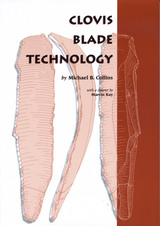 Clovis Blade Technology: A Comparative Study of the Keven Davis Cache, Texas
By Michael B. Collins
University of Texas Press, 1999 Around 11,000 years ago, a Paleoindian culture known to us as "Clovis" occupied much of North America. Considered to be among the continent's earliest human inhabitants, the Clovis peoples were probably nomadic hunters and gatherers whose remaining traces include camp sites and caches of goods stored for utilitarian or ritual purposes. This book offers the first comprehensive study of a little-known aspect of Clovis culture—stone blade technology. Michael Collins introduces the topic with a close look at the nature of blades and the techniques of their manufacture, followed by a discussion of the full spectrum of Clovis lithic technology and how blade production relates to the production of other stone tools. He then provides a full report of the discovery and examination of fourteen blades found in 1988 in the Keven Davis Cache in Navarro County, Texas. Collins also presents a comparative study of known and presumed Clovis blades from many sites, discusses the Clovis peoples' caching practices, and considers what lithic technology and caching behavior can add to our knowledge of Clovis lifeways. These findings will be important reading for both specialists and amateurs who are piecing together the puzzle of the peopling of the Americas, since the manufacture of blades is a trait that Clovis peoples shared with the Upper Paleolithic peoples in Europe and northern Asia.
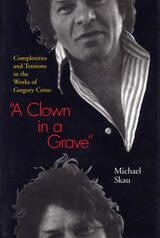 A Clown in a Grave: Complexities and Tensions in the Works of Gregory Corso
Michael Skau
Southern Illinois University Press, 1999 Using a number of critical approaches, Michael Skau examines Gregory Corso's complex imagination, his humor, and his poetic techniques in dealing with America, the Beat generation, and death. Skau covers the complete works of Corso, one of the four major Beat Generation writers (with Jack Kerouac, Allen Ginsberg, and William S. Burroughs) who attempted to provide an alternative to what they saw as the academic forms of literature dominating American writing through the 1940s and 1950s. The Beat option focused on ordinary people, spurning the cultural pretensions of the intelligentsia and using common language as well as the rhythms of actual speech. Corso, abandoned as a child by his mother, subjected to a variety of foster homes, and imprisoned as an adolescent, became an authentic voice of America's neglected streetwise youth. He embodies much of the tension, confusion, and rebellion that emerged in America after World War II and eventually crested in the 1960s. Corso emphasizes social issues, yet risks undermining this significance by using wit, wordplay, and humor. While conceding mortality, he is adamant in refusing to acknowledge death's power. Even as he rebels against conventional literature, he still is enchanted by classicism and romanticism, often borrowing their techniques and idioms. Skau examines these complexities and seeming contradictions throughout Corso's career, showing that Corso finds value in inconsistency and vacillation. For him, as illustrated in the poems "Hair" and "Marriage," contradiction and ambivalence suggest the foundations of freedom of imagination. In spite of Corso's significance as an American poet, Skau's is the first extensive study of his work, including his fiction. Skau also provides the first complete bibliography of Corso's published work in more than thirty years.
Clown Through Mask: The Pioneering Work of Richard Pochinko as Practised by Sue Morrison
Veronica Coburn and Sue Morrison
Intellect Books, 2013 Richard Pochinko (1946–89) played a pioneering role in North American clown theater through the creation of an original pedagogy synthesizing modern European and indigenous Native American techniques. In Clown Through Mask, Veronica Coburn and onetime Pochinko apprentice Sue Morrison lay out the methodology of the Pochinko style of clowning and offer a bold philosophical framework for its interpretation. Morrison is today a leading teacher of Pochinko’s Clown through Mask technique and this book extends significantly the literature on this underdocumented form of theater.
 Clowns in the Burying Ground: The Grateful Dead, Literature, and the Limits of Philosophy
Christopher K. Coffman
Duke University Press, 2026 In Clowns in the Burying Ground, Christopher K. Coffman presents intertextual readings of the Grateful Dead and their lyrics to argue that the band’s lyricists were deeply and significantly engaged with the literary tradition. Through an analysis of their music, lyrics, and biographies, Coffman shows how the group and its individual members drew on the canons of European and American literature to shape both the form and content of their creative work. Coffman draws on the language of the “literary fragment,” as conceived by German Romantic philosophers and their intellectual heirs, to identify how the Grateful Dead’s lyricists employed intertextuality, allusion, and other strategies to explore how meaning takes shape at the boundary between poetry and philosophy. From Shakespeare to “Shakedown Street,” Clowns in the Burying Ground demonstrates the Dead’s literary depth and how their most successful lyrics and performances walk the line between creation and chaos.
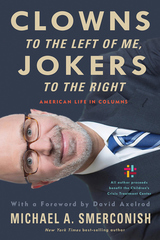 Clowns to the Left of Me, Jokers to the Right: American Life in Columns
Michael A. Smerconish
Temple University Press, 2020 Opinionated talk show host and columnist Michael Smerconish has been chronicling local, state, and national events for the Philadelphia Daily News and the Philadelphia Inquirer for more than 15 years. He has sounded off on topics as diverse as the hunt for Osama bin Laden and what the color of your Christmas lights says about you. In this collection of 100 of his most memorable columns, Smerconish reflects on American political life with his characteristic feistiness. A new Afterword for each column provides updates on both facts and feelings, indicating how the author has evolved over the years, moving from a reliable Republican voter to a political Independent.
Clowns to the Left of Me, Jokers to the Right covers the post-9/11 years, Barack Obama’s ascension, and the rise of Donald Trump. Smerconish describes meeting Ronald Reagan, having dinner with Fidel Castro, barbequing with the band YES in his backyard, spending the same night with Pete Rose and Ted Nugent, drinking champagne from the Stanley Cup, and conducting Bill Cosby’s only pretrial interview. He also writes about local Philadelphia culture, from Sid Mark to the Rizzo statue.
Smerconish’s outlook as expressed in these impassioned opinion pieces goes beyond “liberal” or “conservative.” His thought process continues to evolve and change, and as it does, he aims to provoke readers to do the same.
All author proceeds benefit the Children’s Crisis Treatment Center, a Philadelphia- based, private, nonprofit agency that provides behavioral health services to children and their families.
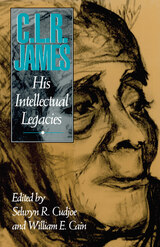 C.L.R. James: His Intellectual Legacies
Selwyn R. Cudjoe
University of Massachusetts Press, 1995 C.L.R. James (1901-1989) made important contributions in a host of fields--literature, criticism, cultural studies, political theory, history, and philosophy. One of the most astute minds of this century, he served as mentor for two generations of international intellectuals. He contributed enormously to their understanding of the colonial question, the Negro question, the Russian question, the role of dialectics in proletarian struggle, and the theory and practice of Marxism in the Americas. In addition to The Black Jacobins, his incisive account of the Haitian revolution of the 1790s, and Notes on Dialectics, James published a range of other books, including a classic work on the game of cricket and a study of Herman Melville.
This collection of essays offers a variety of fresh perspectives on James's life and writings. Included are reminiscences of those who knew James well and critical essays by eminent scholars. The book is the first to offer a full treatment of James's many contributions to twentieth-century intellectual life.
Club Icarus
Matt W. Miller
University of North Texas Press, 2013
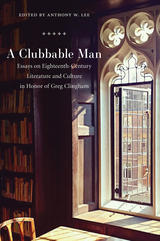 A Clubbable Man: Essays on Eighteenth-Century Literature and Culture in Honor of Greg Clingham
Anthony W. Lee
Bucknell University Press, 2022 Samuel Johnson famously referred to his future biographer, the unsociable magistrate Sir John Hawkins, as “a most unclubbable man." Conversely, this celebratory volume gathers distinguished eighteenth-century studies scholars to honor the achievements, professional generosity, and sociability of Greg Clingham, taking as its theme textual and social group formations. Here, Philip Smallwood examines the “mirrored minds” of Johnson and Shakespeare, while David Hopkins parses intersections of the general and particular in three key eighteenth-century figures. Aaron Hanlon draws parallels between instances of physical rambling and rhetorical strategies in Johnson’s Rambler, while Cedric D. Reverand dissects the intertextual strands uniting Dryden and Pope. Contributors take up other topics significant to the field, including post-feminism, travel, and seismology. Whether discussing cultural exchange or textual reciprocities, each piece extends the theme, building on the trope of relationship to organize and express its findings. Rounding out this collection are tributes from Clingham’s former students and colleagues, including original poetry.
The Clubs of Augustan London
Robert J. Allen
Harvard University Press Preserving the fine old flavor of the time and subject with which he deals, Mr Allen here makes a delightful study of the position of the club among the literary currents of England's most socially-minded age. He traces the rise of the club to prominence as a social institution, shows how conspicuous clubs were in the countless descriptions of the Town, presents new material on the origin of the Kit-Cat Club, and corrects some old misapprehensions about various other societies. A considerable part of the book treats of the fictitious societies of gentlemen, by means of which essayists and versifiers adroitly catered to the public. The final chapter deals with the relations between clubs and authors.
 The Clue in the Trees: An Enchantment Lake Mystery
Margi Preus
University of Minnesota Press, 2019 Francie returns to Enchantment Lake looking for answers, only to get dragged into a murder mystery she might not survive
Francie’s brother Theo has secrets—secrets Francie thinks she wants to know. But what if one of those secrets is that Theo is a murderer? To avoid considering that possibility, Francie plunges into her senior year at a small-town high school near Enchantment Lake in northern Minnesota. It’s a radical change from her private school in New York, but she hopes to keep an eye on her great aunts and maybe finally learn more about the mother she never knew. A small silver box seems to hold the answers, and she is determined to get her hands on it. But when her long-lost brother turns up, so does a dead body, and once again Francie is drawn into a mystery. A long list of suspects, with Theo at the top, keeps her head spinning. When Francie herself becomes a suspect she starts to feel like she is walking on thin ice, but it isn’t until she is literally walking on thin ice that the pieces start to come together—and by then it may be too late. In her previous adventure Enchantment Lake, Francie was thrown into northern Minnesota lake living: fishing, berry picking, lost kayaks and scary boat rides, poisoned hotdishes, exploding bulldozers, a forest fire . . . and murder. But if she thinks things have settled down, she’s in for a surprise. A new school with new friends (and a few enemies), a lead role in a play, an encounter with a giant muskie, archaeological twists, secret tunnels, thin ice, and a strangely sticky murder are all coming her way in The Clue in the Trees.
|
|

